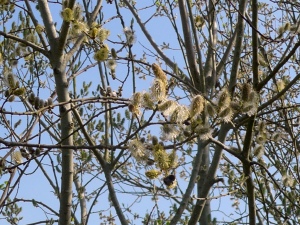
These notes cover the period from April 2022 to the current date.
For Notes before April 2022 please visit Nature Notes archive
Nature Notes Sat 23rd March 2024
Who came: Huw plus his SWT hit squad volunteers, Plus Liz & Grecia
Not able to make it: Dave, Simon, Rossano, Rachel, Felix & Will.
Notes by Liz. Photos: Liz
Our regular team was very thin on the ground this week as several people were ill, while others had work commitments.
Grecia stayed by the main gate to let Hit Squad volunteers in, while Huw & I planned the work areas. There were around 10 SWT volunteers, who were fantastic at using their experience and initiative to decide what to cut back, and what to leave.
What we did:
Cut back brambles encroaching on Grecia’s meadow, alongside the paths, alongside the Scrapes and the very top of the new wildflower meadow, also pulling up the ivy on the ground swamping any wildflowers. The grass was too wet to cut with our shears, so it will have to wait.
What we saw:
Literally 100’s of buff-tailed bumblebee queens had come out of hibernation and were buzzing low across and into the grassy flower meadows. Some were foraging amongst the huge numbers of flowering Primroses, some on the Goat willow catkins, some were looking for nesting sites.
It was a fantastic sight, and to know that each of these Queens will produce hundreds more bumblebees to pollinate crops and wildflowers over the summer was very gratifying. We have obviously provided them with a good hibernation and nesting habitat.
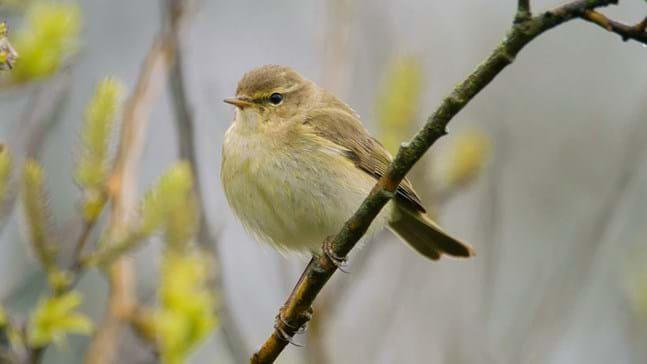 Huw had spotted a Kestrel, several of us saw a Red admiral butterfly, and we were constantly serenaded by the bird song, mainly Tits and Sparrows, but also the first Chiff Chaffs I’ve heard this year. Chiff chaffs are tiny birds (weighs less than £1 coin). They mostly migrate to sub-Saharan Africa each year, returning each spring to breed, although increasingly because of climate change, some remain in the UK over winter. They attract mates with their continual (& quite monotonous) two note song- ‘chiff, chaff’, each ‘chaff’ being not exactly in tune with the last one! They usually cross the channel in mixed flocks with other songbirds, so I was listening out for Garden and Willow warblers, but didn’t hear them today. Perhaps this one had overwintered on our site, keeping quiet!
Huw had spotted a Kestrel, several of us saw a Red admiral butterfly, and we were constantly serenaded by the bird song, mainly Tits and Sparrows, but also the first Chiff Chaffs I’ve heard this year. Chiff chaffs are tiny birds (weighs less than £1 coin). They mostly migrate to sub-Saharan Africa each year, returning each spring to breed, although increasingly because of climate change, some remain in the UK over winter. They attract mates with their continual (& quite monotonous) two note song- ‘chiff, chaff’, each ‘chaff’ being not exactly in tune with the last one! They usually cross the channel in mixed flocks with other songbirds, so I was listening out for Garden and Willow warblers, but didn’t hear them today. Perhaps this one had overwintered on our site, keeping quiet!
(pic curtesy of The Woodland Trust).
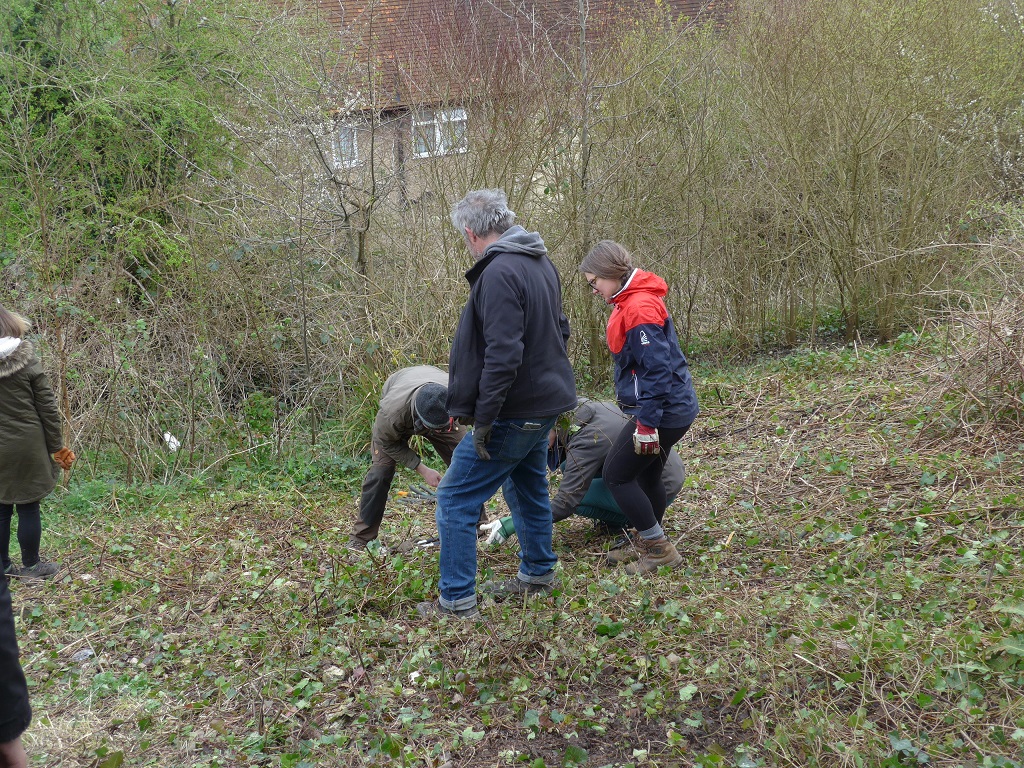 While cutting back the ivy spreading across the wildflower meadow, the group saw one, or maybe two different frogs, – time to move out of this area, we thought.
While cutting back the ivy spreading across the wildflower meadow, the group saw one, or maybe two different frogs, – time to move out of this area, we thought.
Pics below (from April 4th 2023)- Primroses galore; Buff tailed bumblebee on Goat willow (female flowers); Goat willow (male flowers).
Nature Notes Sat 3rd February 2024
Who came: Liz, Simon, Rossano, Rachel
Not able to make it: Grecia, Sally, Jim, Tara, & Dave is still suffering from Christmas Covid.
Notes by Liz. Photos: Simon & Liz
Dry mild day, great for working!
 What we did:
What we did:
We all worked on clearing a huge new swathe of the new top flower meadow. Rossano excelled himself again mattocking out bramble, nettle and Hemp agrimony roots. I did a second run at the area, taking out turfs, & roots that had been missed, Simon joined me to clear away the debris and smooth the patch out for Rachel to plant wildflowers and sow seeds.
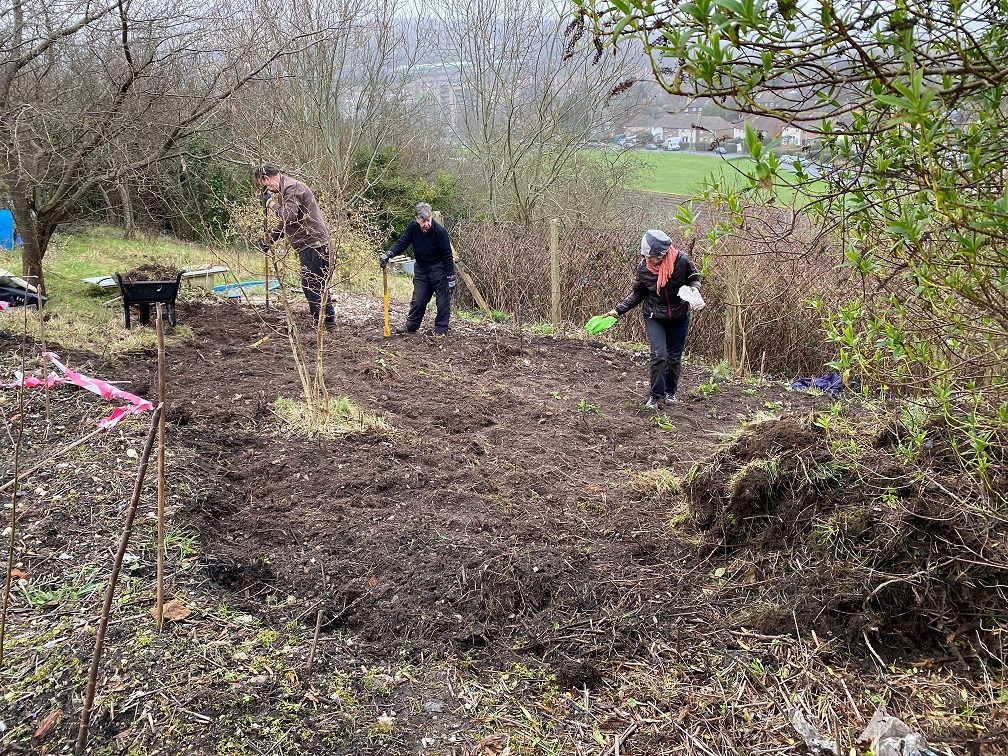 Rachel had brought white comfrey and foxglove plants, I’d brought Marjoram plants, one Salad burnet, some Vipers bugloss & some Plantain, all ‘weeds’ from our allotment. The seeds were mainly from my allotment and included, Marjoram, Scabious (field), Black mullein, Common Mullein, Wild carrot, Red campion, Field Mallow, & Knapweeds, both sorts. There were a few Primroses amongst the grass that we re-planted, and Rachel transplanted lots of Oxe eye daisy from the main Nature site.
Rachel had brought white comfrey and foxglove plants, I’d brought Marjoram plants, one Salad burnet, some Vipers bugloss & some Plantain, all ‘weeds’ from our allotment. The seeds were mainly from my allotment and included, Marjoram, Scabious (field), Black mullein, Common Mullein, Wild carrot, Red campion, Field Mallow, & Knapweeds, both sorts. There were a few Primroses amongst the grass that we re-planted, and Rachel transplanted lots of Oxe eye daisy from the main Nature site.
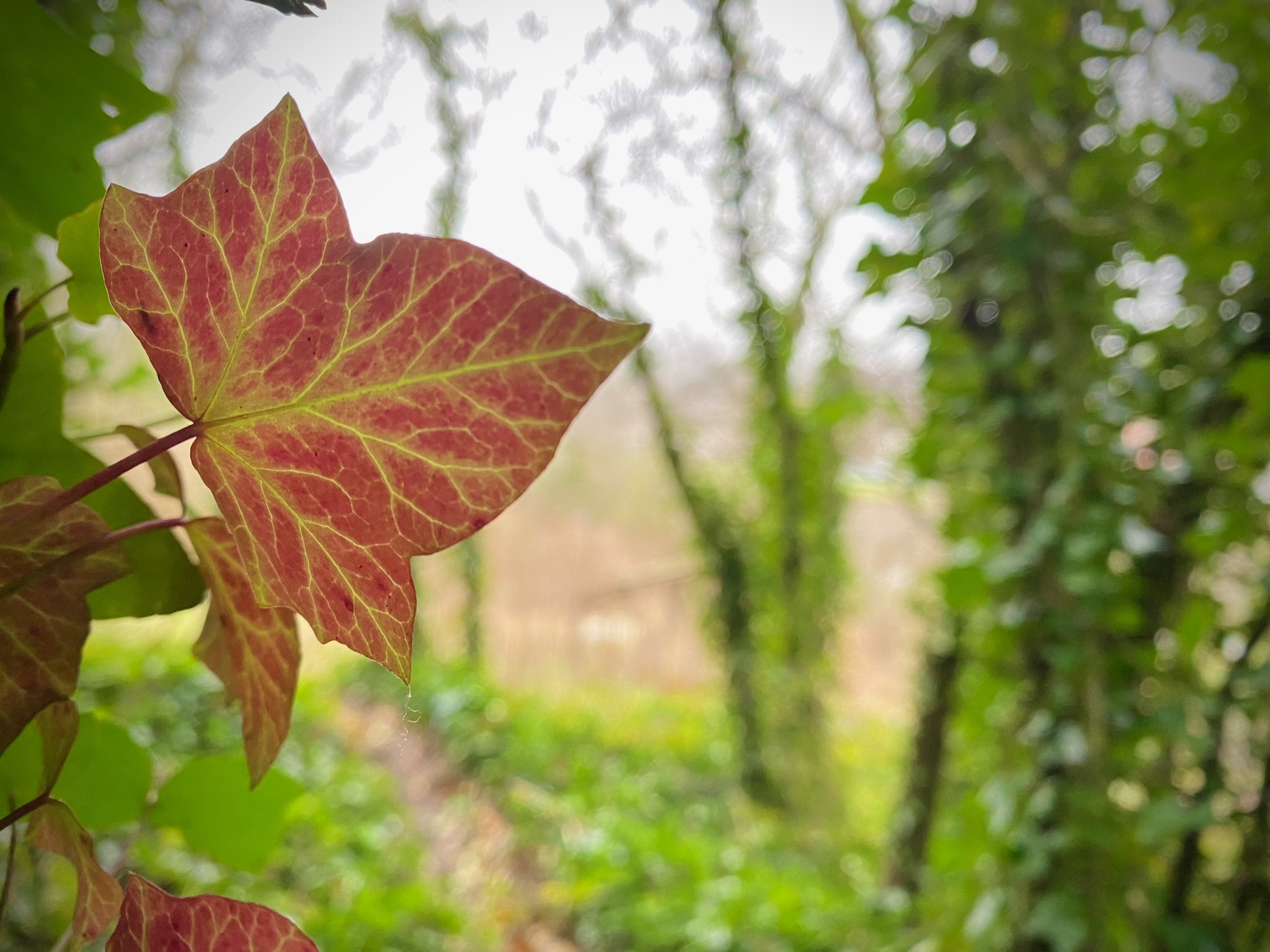 Simon had pulled his back (playing table tennis) so spent most of the session cutting back Wild cherry suckers and making both the mature Wild cherry tree and the enormous Hebe a more manageable size.
Simon had pulled his back (playing table tennis) so spent most of the session cutting back Wild cherry suckers and making both the mature Wild cherry tree and the enormous Hebe a more manageable size.
We talked a bit about where a new bench should go- so look out for a suitable plank to go on top of the tree stumps we’ve already found.
After lunch, Simon & I remembered that we needed to trim the small Blackthorn saplings by the small pond to persuade them into a ‘hedge’ shape
What we saw:
All the small trees we planted this winter are thriving.
The Cherry plum trees look on the verge of flowering, and many of the trees have leaf buds waiting to open – by the early March session probably. Robins of course came down to the disturbed soil for worms, and the odd Blue and Great tit could be heard- but we’re not quite into the full spring bird chorus, again by the March session hopefully.
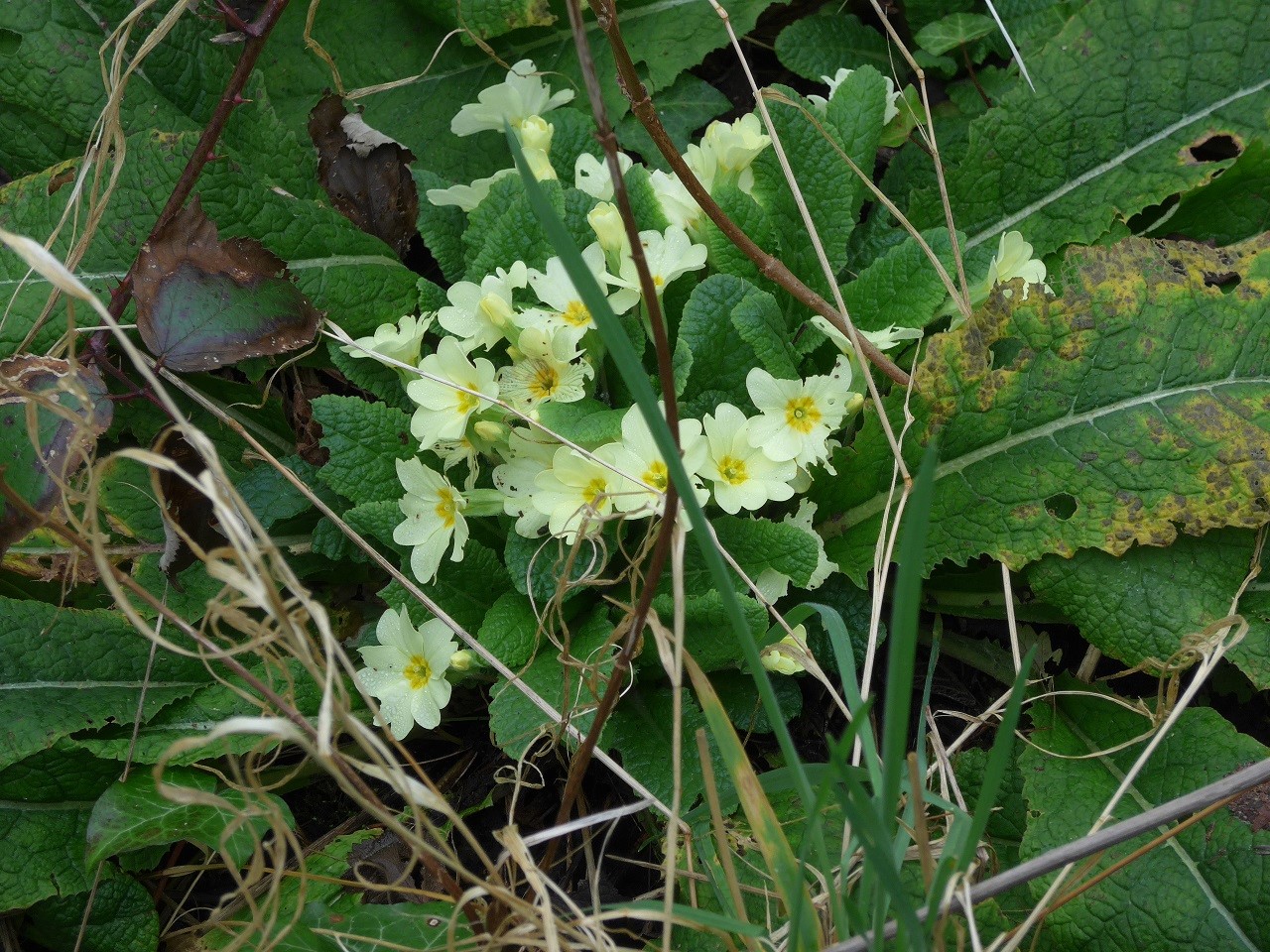 Several Primroses were flowering and many more won’t be long. Luckily the grass & Brambles aren’t yet growing so no path clearing needed!
Several Primroses were flowering and many more won’t be long. Luckily the grass & Brambles aren’t yet growing so no path clearing needed!
By March we will need all the help we can get cutting back paths and wildflower meadows ready for the new seasons small flowers to emerge. Luckily we have booked Huw and his SWT Hit squad to join us for an EXTRA session on Saturday 23rd March.
Nature Notes Sat 6th Jan 2024
Who came: Liz, Simon, Rossano, Rachel
Not able to make it: Felix, Gabby, & Dave is still suffering from Christmas Covid. Sally has temporarily dropped out of work sessions due to arthritis in her hip, but hopes to re-join when she gets her replacement op.
Notes by Liz.
At last, a dry day. Only a very small slot of sun, a cold north wind but dry!
We were a small team but we got loads done, ate homemade biscuits at a mid morning tea break, and had a good chat over lunch. It was a really enjoyable session, and much needed after the Christmas inactivity and constant rain.
What we did:
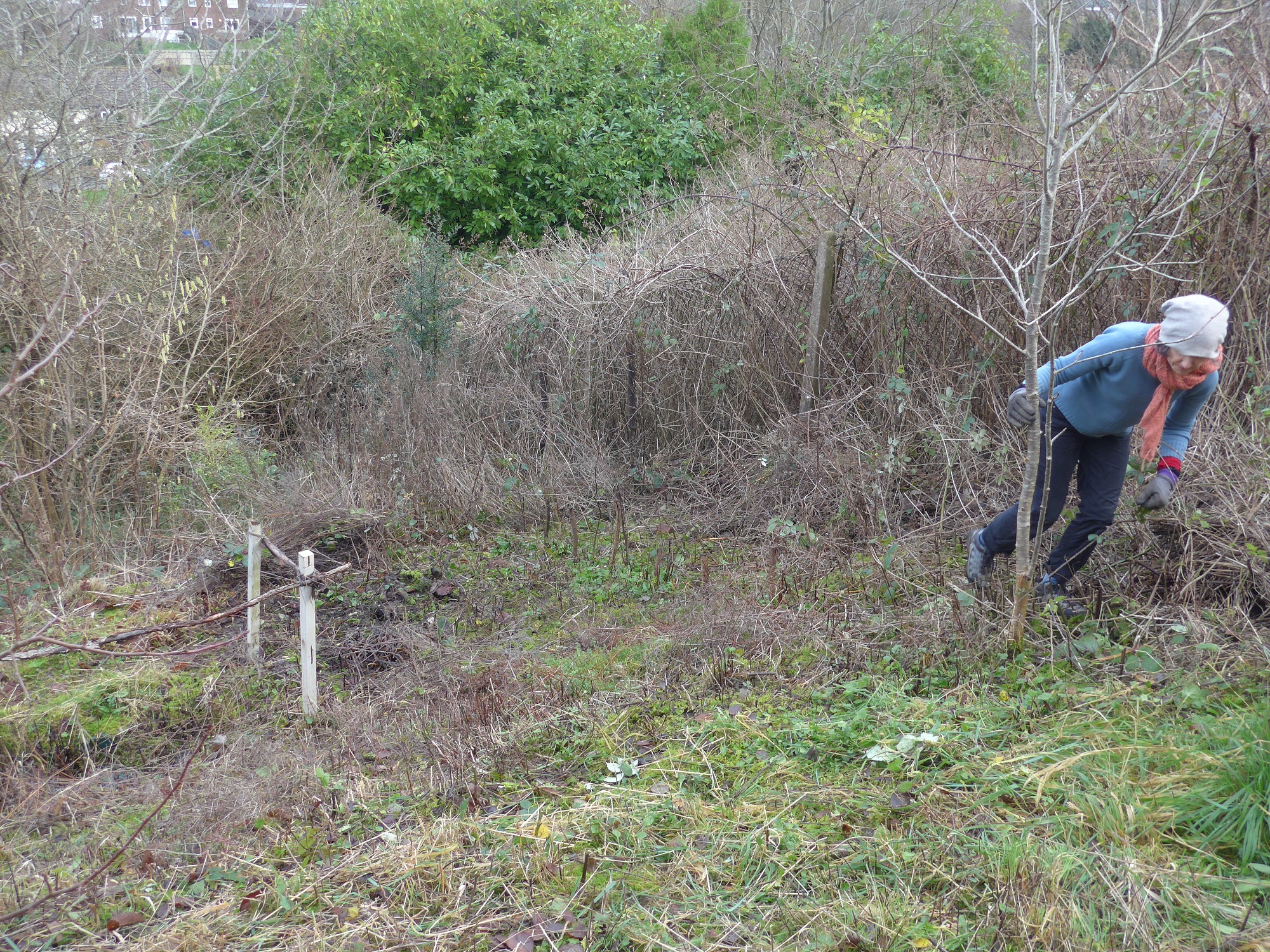 Rachel & I cut back most of the (incredibly steep) slope from seats above small pond to the trees below the small pond. Some of this area had been swamped by very tall Hemp agrimony which had made it hard to see small plants, so we were pleased to see the Blackthorn hedge planted 2 yrs ago growing very nicely, and actually quite tall now (a meter of so). We both thought we should give them a trim to get them to thicken out, so this will be a task for next month.
Rachel & I cut back most of the (incredibly steep) slope from seats above small pond to the trees below the small pond. Some of this area had been swamped by very tall Hemp agrimony which had made it hard to see small plants, so we were pleased to see the Blackthorn hedge planted 2 yrs ago growing very nicely, and actually quite tall now (a meter of so). We both thought we should give them a trim to get them to thicken out, so this will be a task for next month.
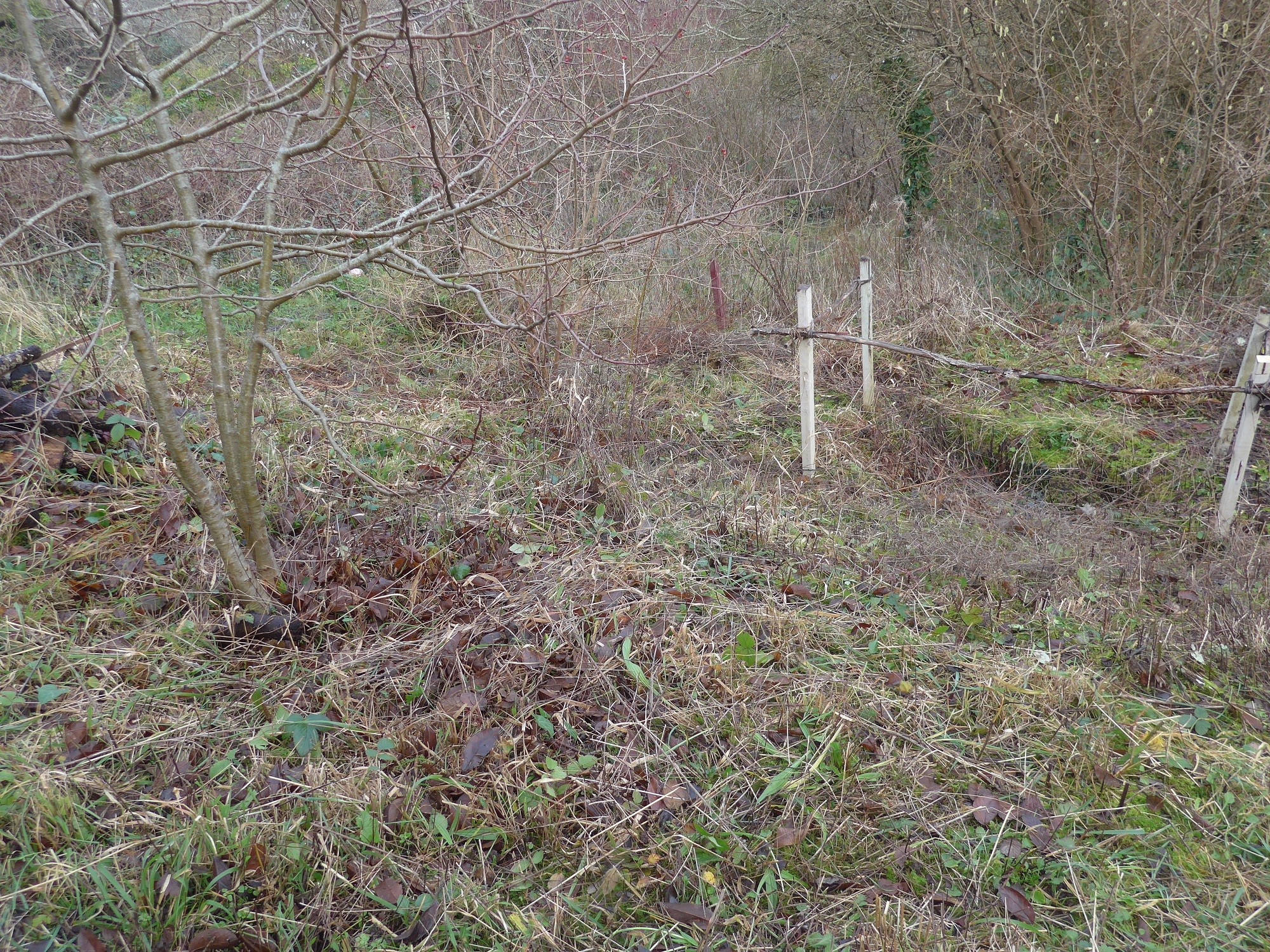 The primroses have really multiplied and should make a spectacular show in a month or so – one or two were actually flowering already. The Hazel bush in this patch was also very advanced with beautiful long catkins- way in advance of all the other bushes on the site. It must be a warmer, sheltered microclimate just here.
The primroses have really multiplied and should make a spectacular show in a month or so – one or two were actually flowering already. The Hazel bush in this patch was also very advanced with beautiful long catkins- way in advance of all the other bushes on the site. It must be a warmer, sheltered microclimate just here.
Simon repaired steps, renewing risers that were rotten and repositioning ones that were leaning down the hill.
Rossano did and absolutely fantastic job with the mattock, grubbing up Nettle, Bramble and Hemp agrimony roots across a huge swath of the new top meadow. After lunch, Simon and I cleared away most of the root debris. This area is nearly ready for planting with wildflowers at the next session.
Bring any excess wildflowers you have on your plots and we’ll put them in, plus Oxeye daisy’s we can move from other parts of the nature Site.
What we saw:
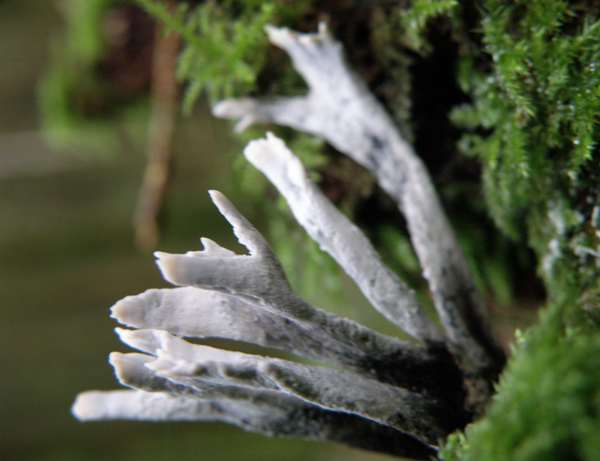
Robins of course came to have a look for exposed worms and insects. A very large tabby cat spent ages peering intently at the same spot, though we never saw it pounce. A dead and very wet rat. Candle snuff fungi –Xylaria hypoxylon, on a dead tree stump in the wood.
The Alders and Birch trees looked fantastic with their lovely winter bark colours and small fir cone type flowers. The large pond (left pic.) was the fullest we’ve ever seen it and must have been overflowing. (Right pic, in frost 2nd December 23)
Nature Notes Extra Monday 11th December
Notes by Dave
The December work session had to be postponed until the second Saturday of the month, when we planned to clear patches of the new field in order to sow them with Yellow-rattle. Unfortunately the weather that day turned out to be truly awful and the session was rained off. So we were running out of  time to sow the seeds. Ideally Yellow-rattle should be sown by the end of November as the seeds need around 4 months in cold and damp soil to germinate in the spring. So Liz and I set to work on the following Monday on a cold but dry morning.
time to sow the seeds. Ideally Yellow-rattle should be sown by the end of November as the seeds need around 4 months in cold and damp soil to germinate in the spring. So Liz and I set to work on the following Monday on a cold but dry morning.
Yellow-rattle is often very unpredictable to establish but can be very effective at suppressing grasses and allowing other flowers to grow. It’s an annual, and should spread by shedding its seed in subsequent years. It’s a hemi-parasite and draws water and nutrients from neighbouring plants, suppressing the growth of grasses by as much as 60%. Unfortunately it fares less well with the coarse vigorous grasses which dominate the Nature site. According to the books, the ideal sites for Yellow-rattle are areas of finer meadow grassland with low fertility.
Still, we could at least do our best to give the seeds a good start. We mattocked out Hemp Agrimony roots, Couch grass, brambles and nettles over an area of just over 3 sq metres. We cleared off a layer of soil, sowed around 3,000 Yellow-rattle seeds and then raked them in. Liz also sowed some Wild Carrot seeds which she’d collected.
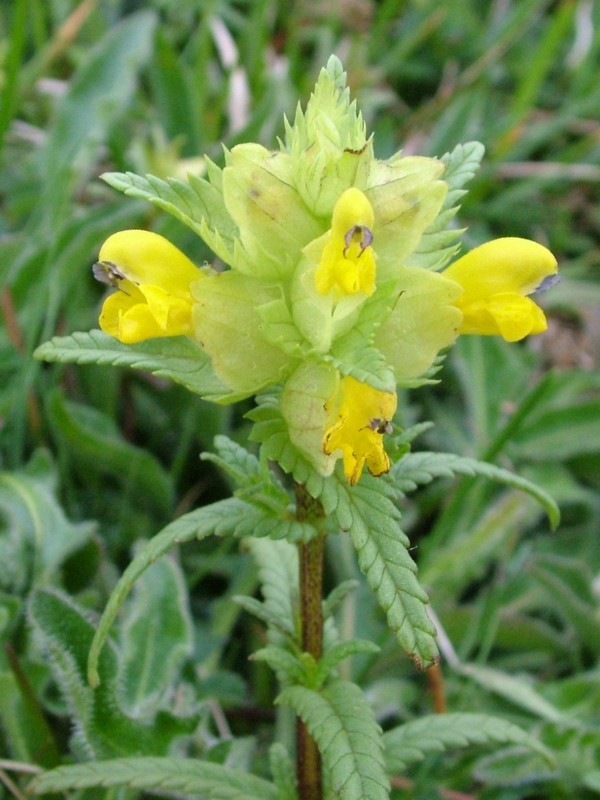
Yellow-rattle is an attractive flower with very distinctive leaves. All we need to do now is cut back grass, etc, to around 2/3 cms by early March and then leave well alone until the end of July. At that point we should cut everything short.
On visit to the Nature site a week or so earlier the whole site was covered in frost and the frozen pond looked beautiful. The slender long male flowers (catkins) of the Alder trees were already appearing. Is this a sign of climate change? The flowers usually appear between February and April. Last year’s female catkins were also visible, looking like round cones after shedding their seed.
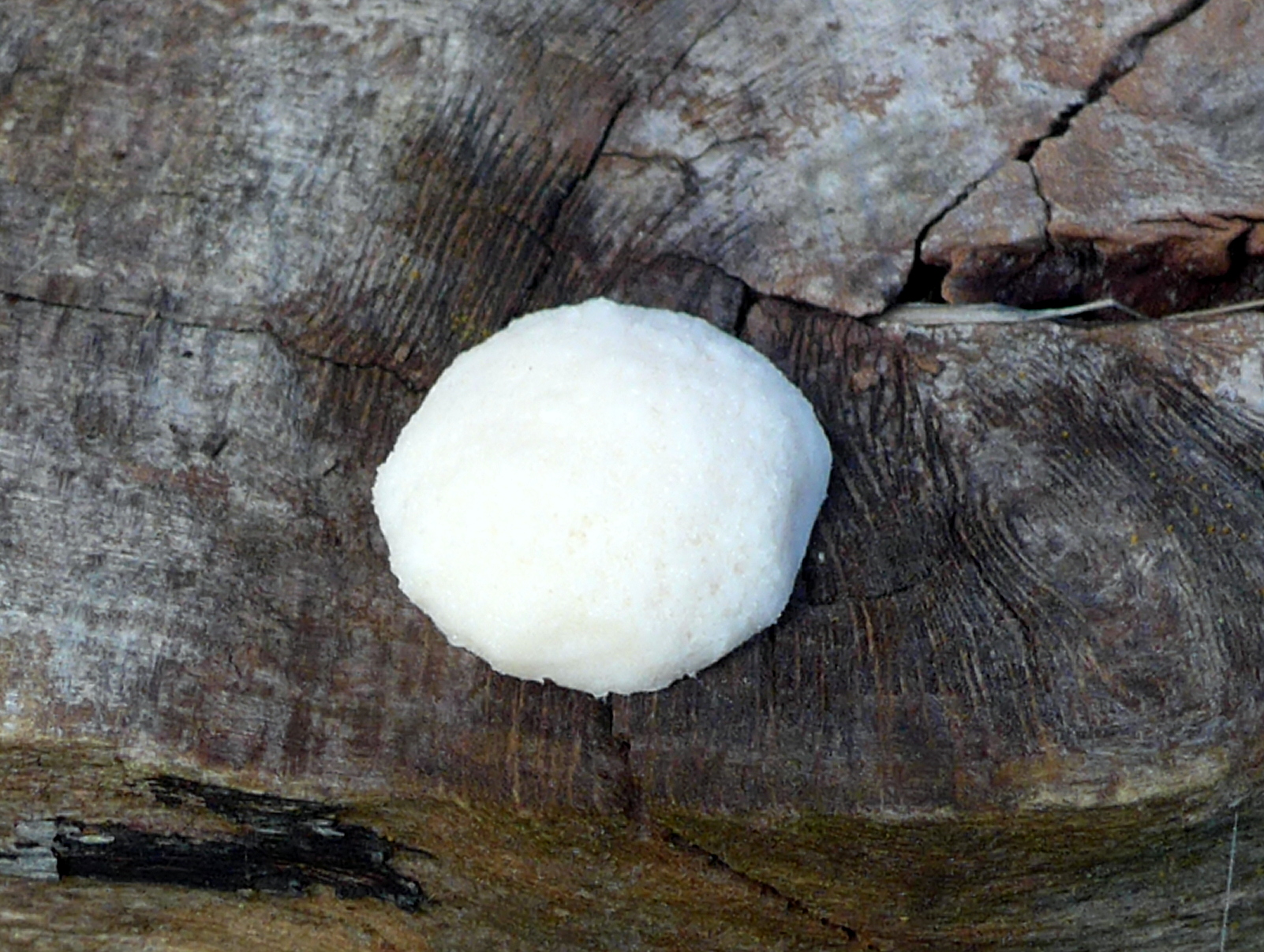 I have finally got round to identifying a strange white blob which we encountered on the seat by the water shelter in late October. We assumed it must be a fungus and after an online search I’m fairly sure it is Calvatia gigantea, commonly known as the giant puffball. It can grow to the size of a football but ours vanished while still fairly small.
I have finally got round to identifying a strange white blob which we encountered on the seat by the water shelter in late October. We assumed it must be a fungus and after an online search I’m fairly sure it is Calvatia gigantea, commonly known as the giant puffball. It can grow to the size of a football but ours vanished while still fairly small.
Nature Notes Saturday 11th November 2023
Present: Simon, Liz, Grecia and Dave.
Apologies: Tara, Rachel, Sally and Jim.
Notes by Dave
Yet another generous donation of trees from Special Branch Tree Nursery! We ordered 6 saplings for the extension to the Nature Site and I collected them on Friday. And what a day to choose! I got caught in two absolute deluges and then hit by hailstones for good measure. Road verges were like lakes with the bus sending up massive sprays. I was glad of the new hardcore path through Stanmer Park although even the first 100 yards of that was awash. I finally arrived at the allotments very bedraggled and heeled in the saplings on our plot.
 Over the past 9 years we’ve planted well over 150 native trees. The vast majority have come from Special Branch (pictured right) and most of these were donated. We’ve looked after them well and only 4 failed to thrive in one of the long dry summers during the Covid lockdowns.
Over the past 9 years we’ve planted well over 150 native trees. The vast majority have come from Special Branch (pictured right) and most of these were donated. We’ve looked after them well and only 4 failed to thrive in one of the long dry summers during the Covid lockdowns.
For those of you who don’t know Special Branch, it’s an invaluable organisation based at Stanmer Organics at the north end of Stanmer Park. It’s run by volunteers and dedicated to supplying native Sussex trees. They collect the seeds and grow the trees organically. The two mainstays are Chris and Martin and I always enjoy talking to them when I visit the nursery. They are both very knowledgeable and enthusiastic about the natural world. If you’re interested to know more about Special Branch and the importance of trees of local origin, have a look at their website. http://www.specialbranchtrees.org.uk
There were just 3 of us to start with on Saturday, a bit later we were joined by Grecia. Rossano came along too with baby Gustavo for a look around the site. Fortunately it was a glorious sunny day and we were in the best of the sun as the new field is right at the top of the hill. The ground was waterlogged of course. My photo above shows Liz, Grecia and Simon hacking out brambles, nettles, hemp agrimony, couch grass, etc, to clear patches of ground for planting. We chopped down 3 domestic apple trees which were in poor condition, and removed plum and cherry tree suckers. Surprisingly, perhaps, we didn’t disturb any ground-nesting bumblebees or solitary bees.
So what was planted?
- A Guelder Rose and a Crab Apple near the top of the field on the west side.
- 3 Silver Birch saplings and a small Rowan on the east side.
- A small self-sown Oak was uncovered at the previous session growing just below its ‘parent’ so we replanted it at the bottom of the field.
Left: Silver birches and Rowan planted
Right: Replanting self-sown Oak
Left: Planting Guelder Rose with Crab Apple in foreground
Right: Guelder Rose
After planting the trees, Liz sowed wildflower seeds which she’d collected, mainly from our plot – Yellow Rattle, Garlic Mustard, Small Scabious and Knapweed. In our mind’s eye, we have a vision of established trees in flower, surrounded by wild flowers and Tutsan shrubs. No doubt reality will be rather different!
Guelder Rose flowers and berries
Sally had grown on a cutting of a Winter-flowering Honeysuckle shrub which she believes is Lonicera Fragrantissima, a non-native cultivar. Our policy is to plant only native or naturalised trees, shrubs and flowers, but we’ve given this the benefit of the doubt as it so closely resembles the naturalised Fly Honeysuckle. Both have ovate leaves and creamy white flowers followed by red berries. One of my wildflower books says that Fly Honeysuckle (L.xylosteum) may actually be native on chalk woodland in West Sussex.
Left: Planted L.fragrantissima
Right: L.xylosteum in flower
We ate lunch in the sun and watched a Robin taking advantage of the dug ground. Afterwards Simon and Liz carried on for another hour or more, cutting back the bank immediately below the big pond and the very bottom bank. We didn’t have time on Saturday to repair a damaged step or clear the grass which is obscuring the steps and making them very slippery. And we are behind with cutting back the area below the small pond.
Amazingly though, given the size of the Nature site and our very small team, we are up-to-date with rest of the site maintenance plan as well as making a good start on the new field.
Nature Notes Saturday September 2023
Who came: Simon, Rachel, Liz, Jim, Dave. Sally came for lunch. Plus 12 people with Huw Morgan’s Sussex Wildlife Trust (SWT) Hit squad
Who couldn’t come: Tara, Rossano, Grecia.
Notes by Liz. Photos by Simon, Dave
 Wow! 17 people all working together on the Nature Site, fantastic. It was a lovely sunny day too – though it did get a bit over-warm by 11am. Together we got so much done! We had a quick look round the site first, as many had never visited. Some had worked here before and were keen to see the effect of their past session’s bramble bashing – a pond, flower bank, rain collection roof and benches.
Wow! 17 people all working together on the Nature Site, fantastic. It was a lovely sunny day too – though it did get a bit over-warm by 11am. Together we got so much done! We had a quick look round the site first, as many had never visited. Some had worked here before and were keen to see the effect of their past session’s bramble bashing – a pond, flower bank, rain collection roof and benches.
What did we do: We were working on a new area, a whole overgrown bank just below the car park that the Allotment Site reps had given us the go-ahead to develop. This has for many years been nothing but very invasive Rosebay Willow herb and Hemp agrimony, both great species for some moths and butterflies but definitely a ‘monoculture’, and the seed is spreading to every other part of the Nature Site, threatening to exclude all other plant species & the wildlife that depends on it.
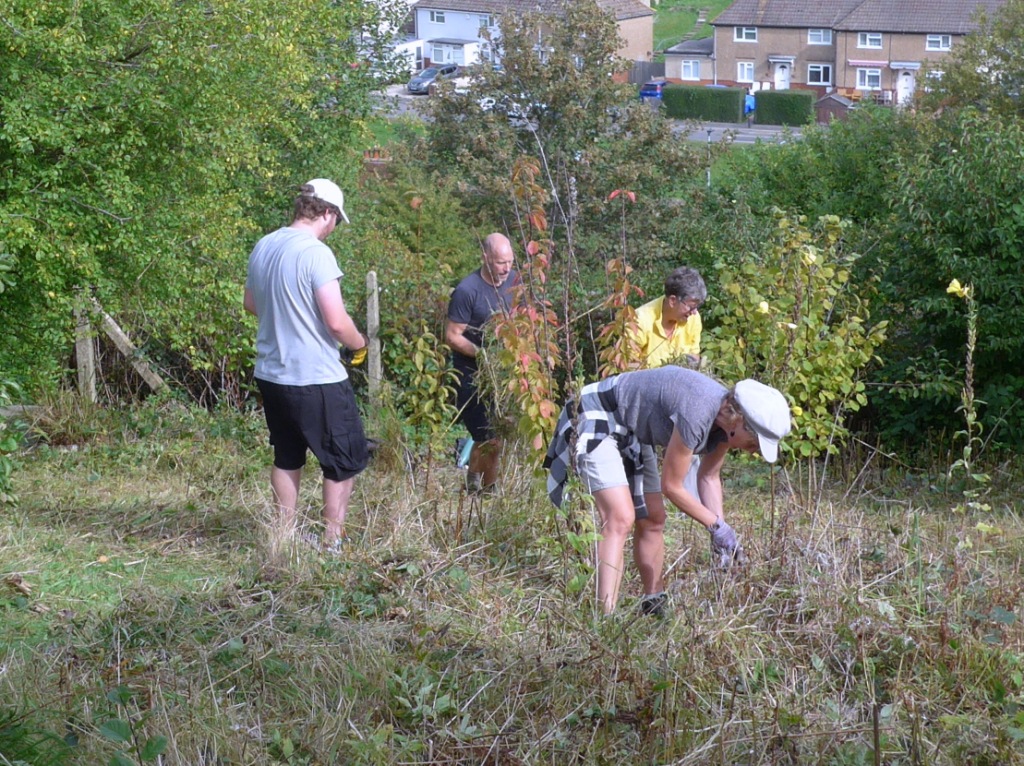 So, our mission was to cut down end of season flower heads and if possible pull or dig out the roots too. We plan to plant 5 or 6 native trees at the foot of the slope (North end), and sow/plant a range of sun loving wildflowers over the rest of the bank gradually crowding out most of the Rosebay and Hemp Agrimony. (we’ll never totally eradicate it but hope to keep it in check at least.)
So, our mission was to cut down end of season flower heads and if possible pull or dig out the roots too. We plan to plant 5 or 6 native trees at the foot of the slope (North end), and sow/plant a range of sun loving wildflowers over the rest of the bank gradually crowding out most of the Rosebay and Hemp Agrimony. (we’ll never totally eradicate it but hope to keep it in check at least.)
Some of our regular group also went round the site, cutting paths, cutting back dead flower growth on one section- the Scrapes, & mending the odd step.
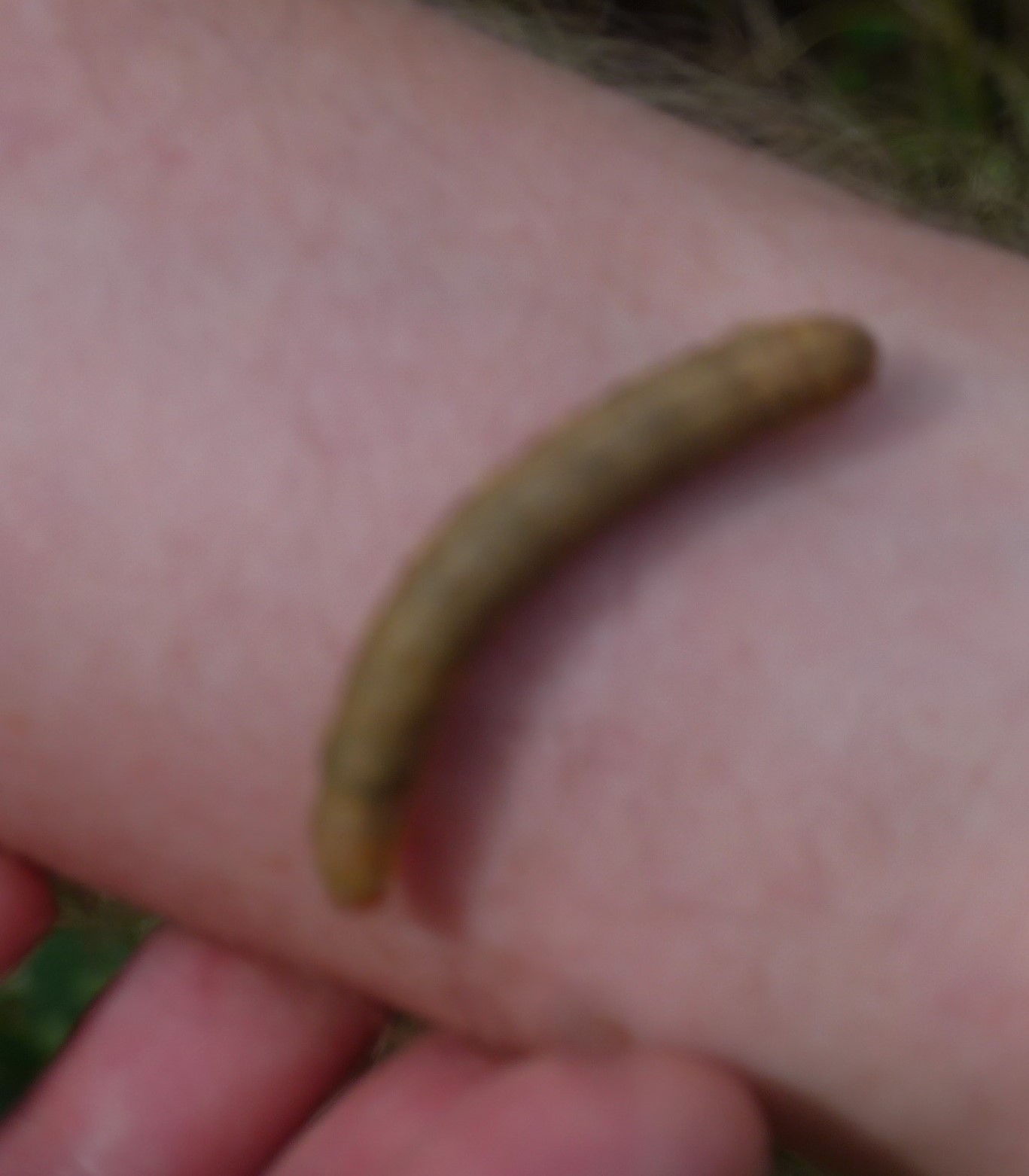
What did we see: lots of spiders, different, though unidentified species; brown shield bugs, one large, 3cms, caterpillar (sorry, very blurred pic left).
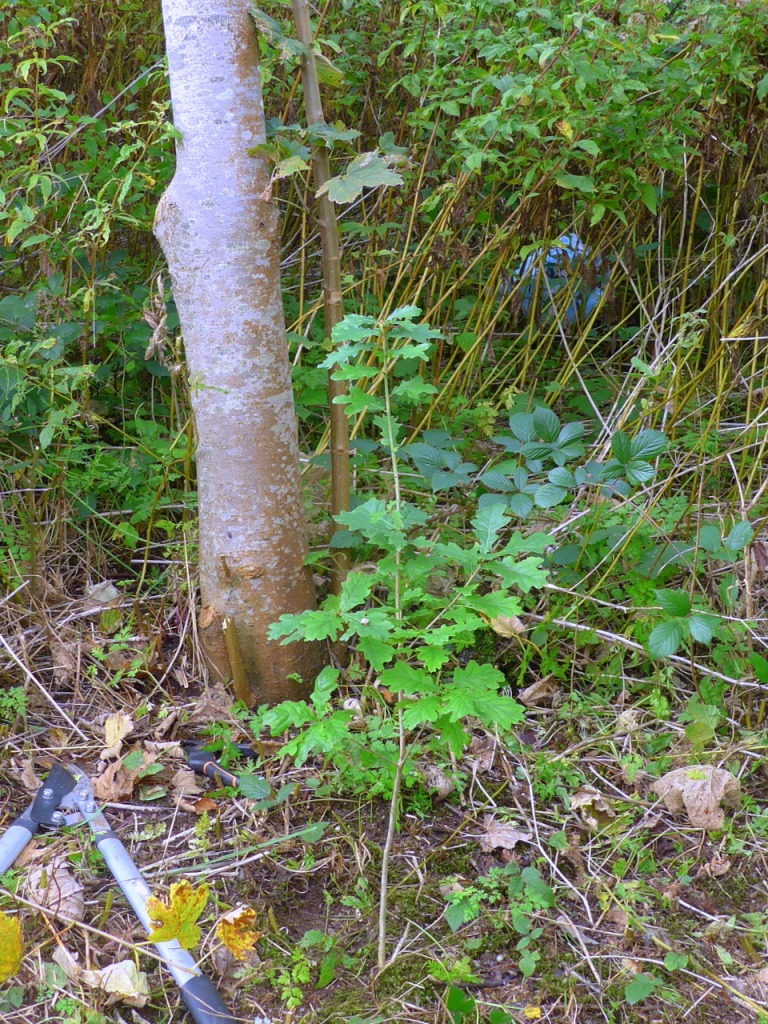
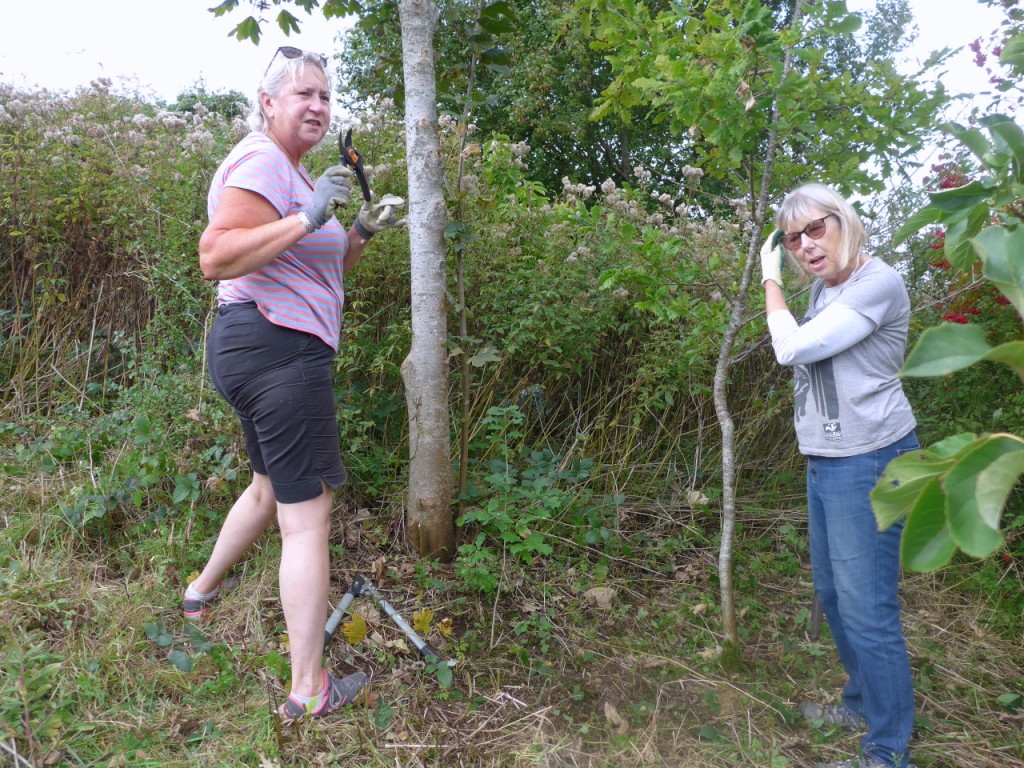 SWT hit squad people not only cut back the entire bank, but did it really sensitively, discovering several small tree saplings that would have been so easy to accidentally cut down in the process. One small Oak, a Yew, and several Holly saplings. We also discovered quite a number of small cultivated fruit trees. Some of these we may replace with native wild trees such as Rowan, Guelder Rose or Silver birch to provide flowers and berries for wildlife and attractive autumn leaf colours for us. We have already planted a hedge at the foot of the bank- Alder buckthorn to attract Brimstone butterflies, and Blackthorn for Brown Hairstreak butterflies, both species of which have been seen on the site.
SWT hit squad people not only cut back the entire bank, but did it really sensitively, discovering several small tree saplings that would have been so easy to accidentally cut down in the process. One small Oak, a Yew, and several Holly saplings. We also discovered quite a number of small cultivated fruit trees. Some of these we may replace with native wild trees such as Rowan, Guelder Rose or Silver birch to provide flowers and berries for wildlife and attractive autumn leaf colours for us. We have already planted a hedge at the foot of the bank- Alder buckthorn to attract Brimstone butterflies, and Blackthorn for Brown Hairstreak butterflies, both species of which have been seen on the site.
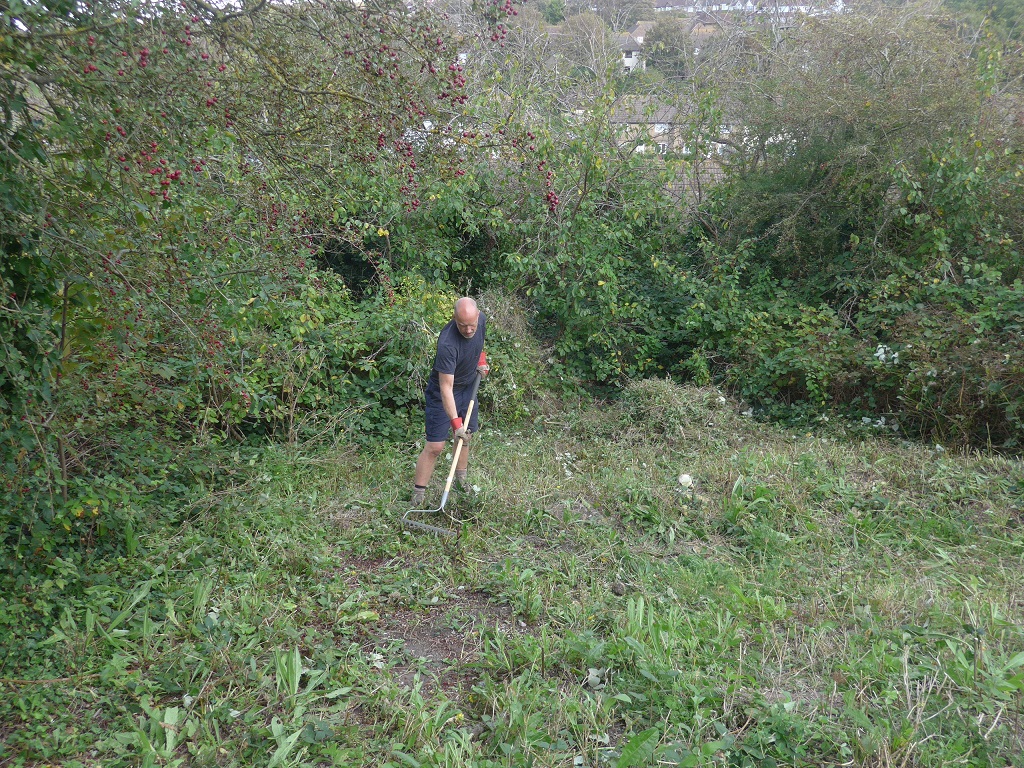 Simon from our group had been working on the Scrapes, cutting back this year’s dead flower heads, sprinkling the seeds before raking off, and noticed a number of small wildflower species lurking close to the ground. We identified Kidney vetch, Wild carrot, Bird’s-foot-trefoil, possibly Melilot, Clovers, St John’s-wort, Viper’s-bugloss & Chamomile. This was the first summer for the newly cleared area and we were very pleased with the range of species that have germinated, or are germinating, from the collected seeds we sowed. There is a bit of bramble coming back so we will have to keep on top of this in future years to retain this flower area, & of course the Hemp-agrimony has already moved in!
Simon from our group had been working on the Scrapes, cutting back this year’s dead flower heads, sprinkling the seeds before raking off, and noticed a number of small wildflower species lurking close to the ground. We identified Kidney vetch, Wild carrot, Bird’s-foot-trefoil, possibly Melilot, Clovers, St John’s-wort, Viper’s-bugloss & Chamomile. This was the first summer for the newly cleared area and we were very pleased with the range of species that have germinated, or are germinating, from the collected seeds we sowed. There is a bit of bramble coming back so we will have to keep on top of this in future years to retain this flower area, & of course the Hemp-agrimony has already moved in!
Many thanks to Huw from SWT and his fantastic Hit squad volunteers, we look forward to working with you again.
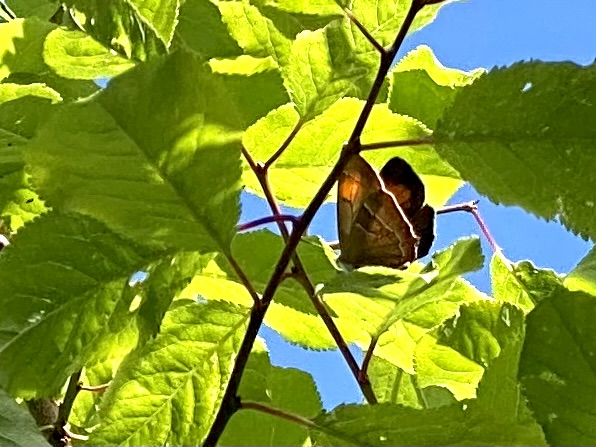 Spreading the word! We have recently put info about our Nature Site on other websites. Locally we have a monthly entry about work sessions on the B & H Green Spaces forum web site. We also posted our first ever sighting of a Brown Hairstreak butterfly under their ‘News’ page. B&H Green Space forum blog
Spreading the word! We have recently put info about our Nature Site on other websites. Locally we have a monthly entry about work sessions on the B & H Green Spaces forum web site. We also posted our first ever sighting of a Brown Hairstreak butterfly under their ‘News’ page. B&H Green Space forum blog
Nationally we have sent info about the Nature Site to ‘Wild Spaces’ which Butterfly Conservation has set up to report and promote all the many small and ‘unofficial’ green spaces in the country which support wildlife (esp. butterflies and moths) Wild Spaces
Nature Notes Saturday 2nd September 2023
Present: Liz, Rossano, Simon and Dave
Apologies: Tara, Grecia, Sally, Rachel, and Jim
Notes by Dave
Another exciting sighting: a female Brown Hairstreak! Liz spotted her high up in trees in the hedge at the bottom of the site. With difficulty Simon managed to get some photos to confirm the sighting when we enter it on iRecord.
 They are very beautiful butterflies and fairly rare. They are usually seen locally only across the West Sussex Weald, although a small colony has been building up in north Patcham in recent years. We were lucky to see one on Saturday as it’s a very elusive species, spending most of its life high in a tree canopy or hidden in hedgerows. It tends to be the females which are spotted when they are laying eggs
They are very beautiful butterflies and fairly rare. They are usually seen locally only across the West Sussex Weald, although a small colony has been building up in north Patcham in recent years. We were lucky to see one on Saturday as it’s a very elusive species, spending most of its life high in a tree canopy or hidden in hedgerows. It tends to be the females which are spotted when they are laying eggs
Their eggs are laid on Blackthorn mainly and also Bullace in August and September. We have planted lots of Blackthorn to provide a suitable habitat and there some very old Bullace trees too. To maintain a healthy colony they need a lot of blackthorn spread over a fairly wide area. Although Blackthorn is abundant in Sussex, so much of it is in hedgerows which are flailed unnecessarily destroying masses of eggs.
It really does look as though Brown Hairstreaks are breeding on our allotment site, possibly on the Nature Site as a result of our efforts. Two years ago Liz and I were amazed to spot a female Brown Hairstreak on our plot. We were sitting eating lunch when she landed on a nearby red hazel to soak up the sun. On this occasion I had no trouble taking photos.
Since then, Liz and I have seen a female twice this year on our plot. Sussex Butterfly Conservation have been doing a lot of work to conserve the species and are excited by the idea of a colony on our site.
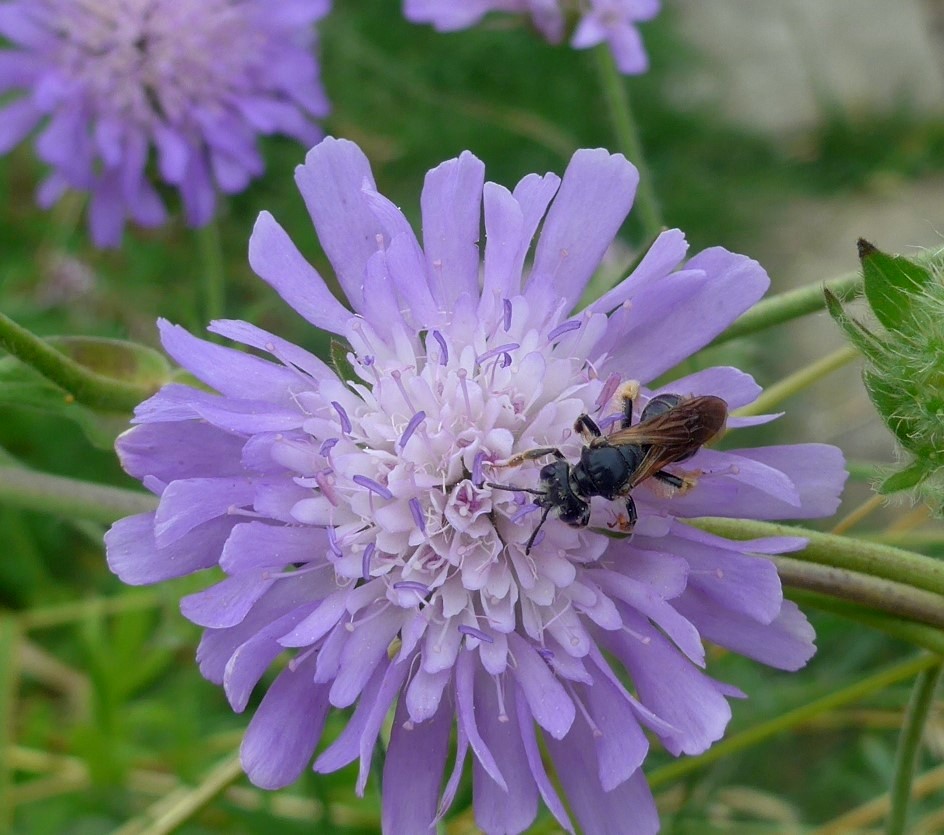 This has been a good year for exciting sightings on the Nature Site. I completely forgot to mention the Large Scabious Mining Bee (Andrena hattorfiana) which we spotted in late July and again in early August.
This has been a good year for exciting sightings on the Nature Site. I completely forgot to mention the Large Scabious Mining Bee (Andrena hattorfiana) which we spotted in late July and again in early August.
This is a very rare Southern species which has declined a lot. The local conservation officer for Buglife has been carrying out a survey on the Downs. She is sure that they must be nesting either on our allotment site or nearby. They nest on the ground in patches hidden by low vegetation. Each egg is provisioned with a small ball of pollen.
The females are slightly bigger than a Honey Bee. They have shiny black abdomens with orange hairs and there is also a form with a red band. They pick up masses of pollen, which gives them huge pink legs. The females collect pollen almost exclusively from Field Scabious and sometimes from Small Scabious. As Field Scabious has dwindled because of the spread of scrub and agricultural intensification, the bees face a long-term threat.
So, what work did we do?
Liz, Simon and I started by cutting back all of the vegetation on the west bank while Rossano removed an old Hawthorn on the east bank to let in more light. The top part of the east bank is still shaded by the Goat Willows but we wouldn’t dream of cutting down such magnificent trees which are a rich source of food for early bumblebees. We then tackled the paths, all of which were very overgrown; the top of the path from the car park had almost disappeared. Rossano started on the major task of removing brambles and Hemp Agrimony from the new patch of land. Simon and Liz carried on for a while after lunch, but we still didn’t have enough time to cut back vegetation on the Scrapes. It was yet another very hot and humid day!
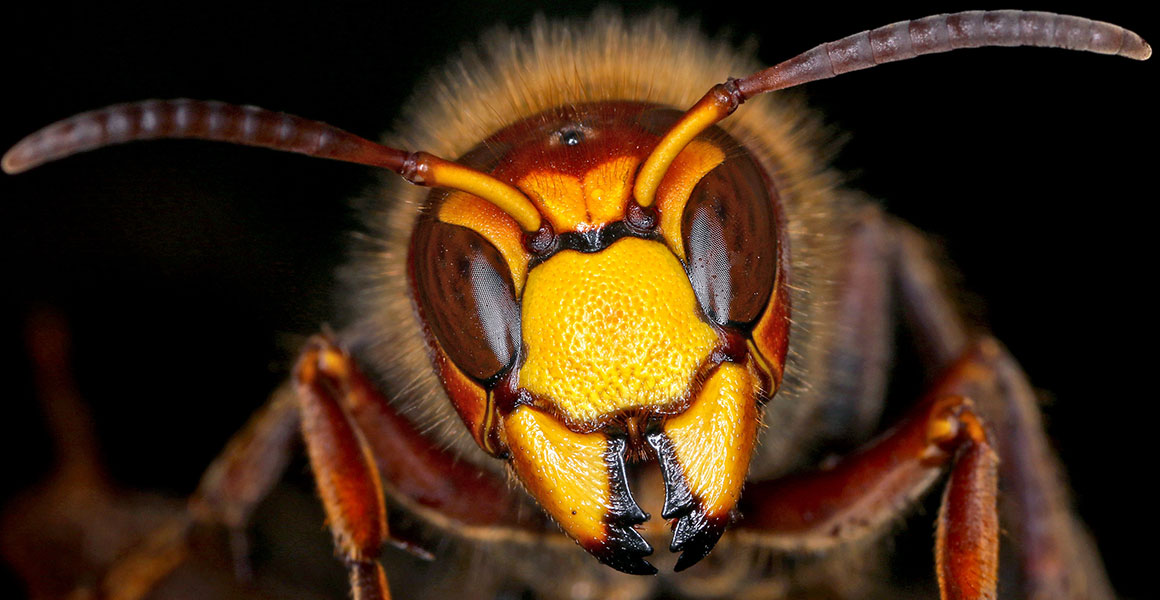 NOT sighted on the Nature Site: an Asian Hornet. And hopefully we never will! This invasive species has been in the news a lot lately. If they become established, they will be a deadly threat to our native bees and wasps. Each Asian Hornet can eat 300 honey bees a day.
NOT sighted on the Nature Site: an Asian Hornet. And hopefully we never will! This invasive species has been in the news a lot lately. If they become established, they will be a deadly threat to our native bees and wasps. Each Asian Hornet can eat 300 honey bees a day.
The i newspaper reports that it may not be just bees that have reason to fear the Asian hornet. No insects in Britain have evolved to defend against it, and it has no natural predators in this country. Analysis of their larvae (their young) has found protein from bees, wasps, spiders and even hedgehogs in their digestive systems. Evidence from France shows that the hornets are just as happy to scavenge from carrion as they are to hunt fresh meat.
They’re likely to come into the country on vegetables, clothing, ferries, etc. So far there have been 23 sightings this year, mostly in Kent. If a single mated queen makes it into the country she can establish a colony. A specialist unit from DEFRA has the complex task of tracking down each sighting and eradicating the hornet.
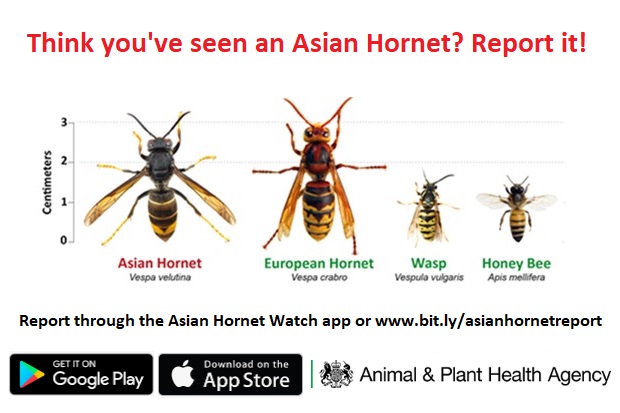
If you think you’ve spotted one, you’re asked to report it to Great British Non-Native Species Secretariat (NNSS) immediately.
You can get an Asian Hornet Watch app or use the NNSS online notification form or email alertnonnative@ceh.ac.uk.Asian Hornets are slightly smaller than our native European hornet but larger than a common wasp. They have yellow “socks” – leading to the common name in Asia of the “yellow-legged hornet. And they are darker than European hornets and many types of wasp, but have a distinct orange face and an orange-yellow band towards the tail end of its abdomen.
Asian hornets are not generally aggressive but it’s best not to approach or disturb their nests. Their sting can be painful to humans. In rare cases, a person may suffer an allergic reaction to a sting, leading to swelling and difficulty breathing. In extremely rare cases, a sting may cause death due to an anaphylactic shock.
If one does sting you, the advice is wash the area thoroughly with soap and cool water and, if possible, to apply ice to slow the venom spreading further. Asian hornets don’t leave a stinger so you will not need to worry about removing one.
Nature Notes Extra Wednesday 12th July 2023
Notes by Dave
 Liz and I had an exciting find on Grecia’s Meadow – a pair of Green-veined Whites mating. We had recorded only one previous sighting in 2018.
Liz and I had an exciting find on Grecia’s Meadow – a pair of Green-veined Whites mating. We had recorded only one previous sighting in 2018.
They are a fairly common butterfly, although they often go unnoticed as they’re mistaken for a Small White. However it is very unusual to find them locally. They prefer the heavier, rich soils to the north of the South Downs and their favoured habitat is damp grassland and woodland rides. The Butterflies of Sussex atlas describes them as patrolling the sheltered edges of copses in the Weald and around watercourses and wet ditches, often in the company of Orange-tips.
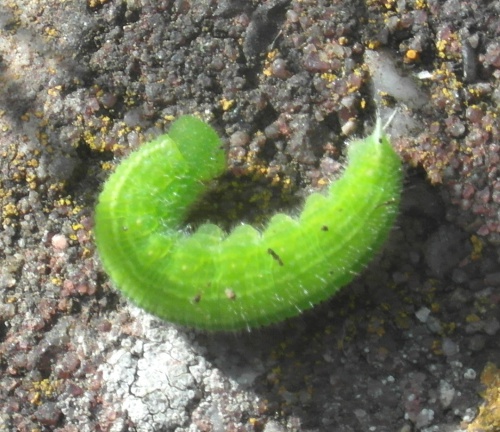 They have two broods a year; our butterflies are from the first brood which are on the wing between April and June. Eggs laid by the second brood produce caterpillars which develop into chrysalises with thick waxy skins suitable for overwintering until the following spring.
They have two broods a year; our butterflies are from the first brood which are on the wing between April and June. Eggs laid by the second brood produce caterpillars which develop into chrysalises with thick waxy skins suitable for overwintering until the following spring.
Unlike most butterfly species, Green-veined Whites mate more than once. This is not always about fertilisation, as the male deposits more than just sperm when mating. The male transfers proteins and other nutrients to the female which enables her to live longer and lay more eggs.
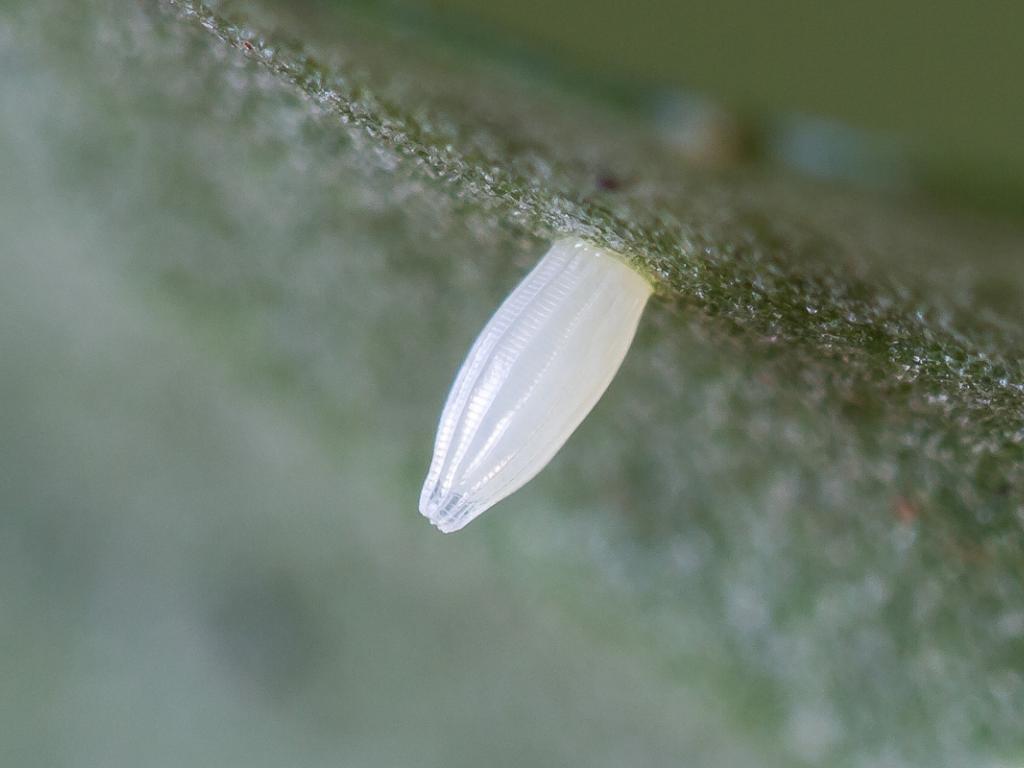 The female lays eggs one at a time in a range of wild crucifers, including Garlic Mustard, Cuckooflower, Water-cress, Charlock and Wild Radish. Cultivated crucifers are used occasionally. The eggs are off-white – this photo is about 15 times enlarged. After a week to ten days the caterpillar hatches. It takes around a month to mature, moulting 4 times before pupating.
The female lays eggs one at a time in a range of wild crucifers, including Garlic Mustard, Cuckooflower, Water-cress, Charlock and Wild Radish. Cultivated crucifers are used occasionally. The eggs are off-white – this photo is about 15 times enlarged. After a week to ten days the caterpillar hatches. It takes around a month to mature, moulting 4 times before pupating.
We were also lucky enough to spot a female Broad-bodied Chaser, again on Grecia’s Meadow. This patch is proving to be a real winner!
After a look around, Liz set to work on the Nature Site while I went back to work on our allotment plots. She was concerned that yet again we were failing to keep up with the ‘mowing’ schedule. The shortage of people able to do physically demanding work meant we just couldn’t do everything at the July work session. So Liz cut back the Hemp Agrimony and long grass on the east bank and around the seats above the small pond. She also cleared around the single seat under the Rowan. We should also have cut back one third of the nettles across the whole site but this task has had to wait.
Liz was going to cut back grass on the west bank. But she saw Burnet moths emerging from their pupae at the top of stems, so she decided to leave this area alone. As well as all the ‘mowing’, Liz collected seeds from Kidney Vetch and Yellow Rattle on the west bank and sowed them on The Scrapes. As she went into The Scrapes she disturbed a fox sunbathing on top of one of the craters.
Liz said there was a mass of butterflies, bees and other insects on the sheltered Nature site. By contrast our plots were being hit by a gusting SW wind and I hardly saw any flying insects.
Information about the Green-veined White is from The Butterflies of Sussex by Michael Blencowe and Neil Hulme and The Butterflies of Britain & Ireland by Jeremy Thomas and Richard Lewington
Photos of the caterpillar and eggs are courtesy of Butterfly Conservation
Nature Notes Saturday 1st July 2023
Present: Liz, Sally, Rachel, Simon and Dave
Apologies: Tara, Grecia, Jim, and Rossano
Notes by Dave
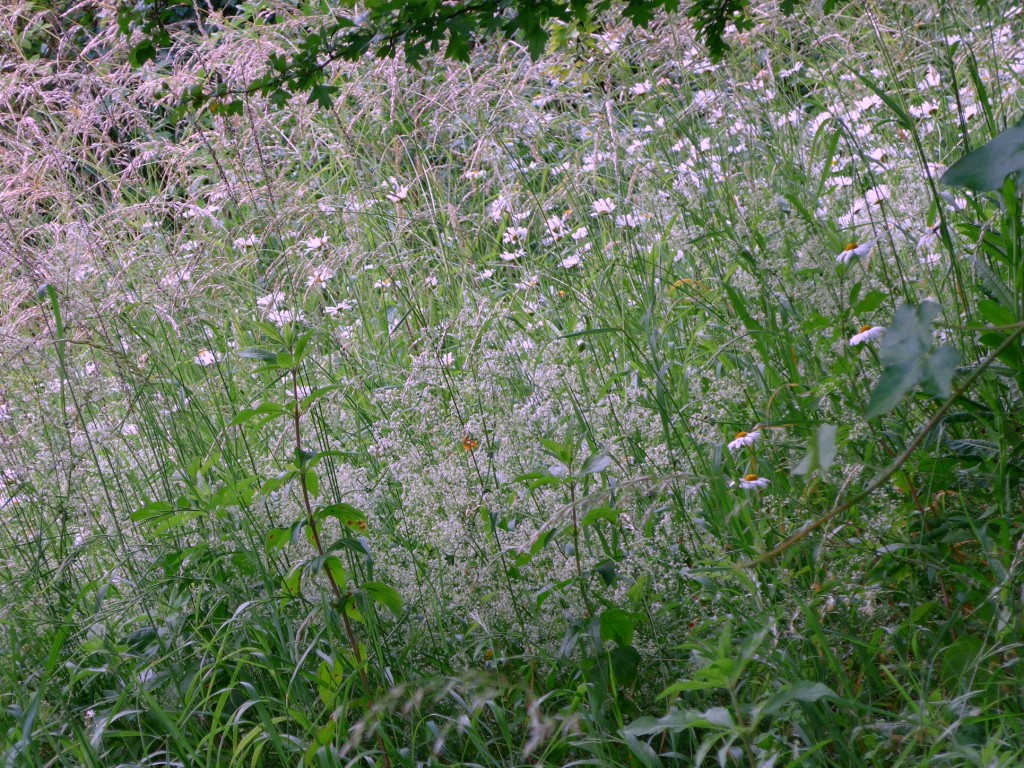
Hedge Bedstraw, Ox-eye Daisies and grasses
As usual for this time of the year, the paths were once again completely overgrown. So we knew where we had to start! Simon arrived with several lengths of plank on the back of his bike, so it was obvious what his main job was – step maintenance.
The whole site looked wonderful but what really stood out for us was the Scrapes area, pictured below. This is a real success and so rewarding after all the hard work to create it. We cleared, ‘landscaped’ and sowed the area over 3 sessions in winter.
As we reported in March’s Nature Notes, the Scrapes resulted from reading up on the results of the City Council’s ‘Wilder Verges’ project. These showed that scrapes attracted over twice the number of insects than flat areas, such as verges or meadows. A scrape is created by scraping away fertile soil to leave chalky soil where only chalk wildflowers are likely to grow, unimpeded by grass, which demands richer soil. The depth at one end (minimum 0.5mts) provides a warm hollow, sheltered from the wind in which insects can bask, or burrow to lay eggs. Bare soil is also very important, the best being 50% bare, but not compacted trampled soil which insects find hard to burrow into.
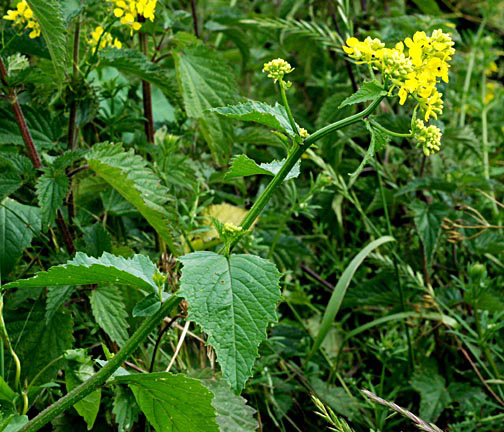 We made our Scrapes circular, or bomb crater shaped with a higher lip at the lower north end to trap the most sun and warmth on its slope. There’s now a mass of wildflowers on these upper ridges and they are alive with insects. Charlock in particular is a real winner – it’s not much to look at but all sorts of insects love it.
We made our Scrapes circular, or bomb crater shaped with a higher lip at the lower north end to trap the most sun and warmth on its slope. There’s now a mass of wildflowers on these upper ridges and they are alive with insects. Charlock in particular is a real winner – it’s not much to look at but all sorts of insects love it.
There was so much to do that we worked flat out for nearly two and half hours. It was a close, very hot day, so by the end of the session Liz and I were exhausted. Somehow Simon found the energy to do a bit more work after lunch!
Despite not finding time to look around properly, we saw lots while working:
- Moths – a White Plume and a yellow underwing, probably the Large Yellow Underwing (pictured at the end of these notes)
- Flowers – Small Scabious and White Clover
- Butterflies – Gatekeepers, a Small Tortoiseshell, a Comma, Meadow Browns, Small Skippers and Ringlets
- a Black-and-yellow Longhorn Beetle and Cinnabar Moth caterpillars on Common Ragwort (below)

We saw evidence of Leaf-cutter bees, but no sign of the bees themselves. The female bees cut out neat semi-circular sections of leaves to use to build egg cells in their nests. In this instance, they had chosen Tutsan leaves.
They glue the overlapping pieces of leaf together with saliva to use as a lining for each individual nest cell. Within each cell, the egg is provisioned with a mixture of nectar and pollen to feed the larva when it hatches. The cell is then sealed off with a plug of more pieces of leaf. Leafcutter bees are one of over 225 solitary bee species in our country.
So what did we do as well as clearing paths and repairing steps?
- cut back Hogweed and Brambles alongside the bottom hedge
- Liz cut back the bank above large pond
- Rachel continued to wage war on the invasive Hemp Agrimony
- cleared around Field Maple sapling
- cut back lower section of east bank under the Hawthorns
- removed a small Bullace in the Scrapes to improve light
- Dave cut back Bullace suckers, Brambles and self-sown Hawthorns which were overpowering saplings we’d planted on the west bank
The Water Lily was in flower in the big pond and we also saw Scarlet Pimpernel; a lone Purple Loosestrife amid the Hedge Bedstraw; Nipplewort; and Purple Toadflax (all pictured below, left to right).
Photos of White Plume Moth (Pterophorus pentadactyla) and Large Yellow Underwing (Noctua pronuba) courtesy of https://www.ukmoths.org.uk
Nature Notes Saturday 3rd June 2023
Present: Liz, Grecia, Sally, Jim and Dave
Apologies: Tara and Simon
Notes by Dave
We all worked hard today! But it was the perfect day for hard work – warm sun but with a fresh breeze. The site looked beautiful but extremely overgrown. It hardly seemed possible that it was only 3 weeks since we had cleared all the paths at the last work session. The large pond (below right) was almost completely covered over but we saw one of the newts again and a Large Red Damselfly laying eggs. A Common Blue Damselfly was circling hopefully but we didn’t see it find a mate.

The Hawthorns are in full flower and look magnificent. Seen from a distance the pink tree dominates the area below the large pond. I really must have a proper close look at the trees to try and determine their species.
There are two native Hawthorns. The Common Hawthorn (Crataegus monogyna) is typically white, but there is a pink variant. In general though the trees with pink flowers are Midlands Hawthorn (Crataegus laevigata), although most of this species have white flowers.
The leaves of the two species are slightly different but the flowers are distinctive. The flowers of C. monogyna have one style (part of the female organs) and the haws have a single pip. C. laevigata has two or even three styles and two or three pips. Unfortunately there is a further complication for rank amateurs like me: the two species also hybridise naturally and it’s very tricky to tell the pure C. laevigata from the hybrid C x media.
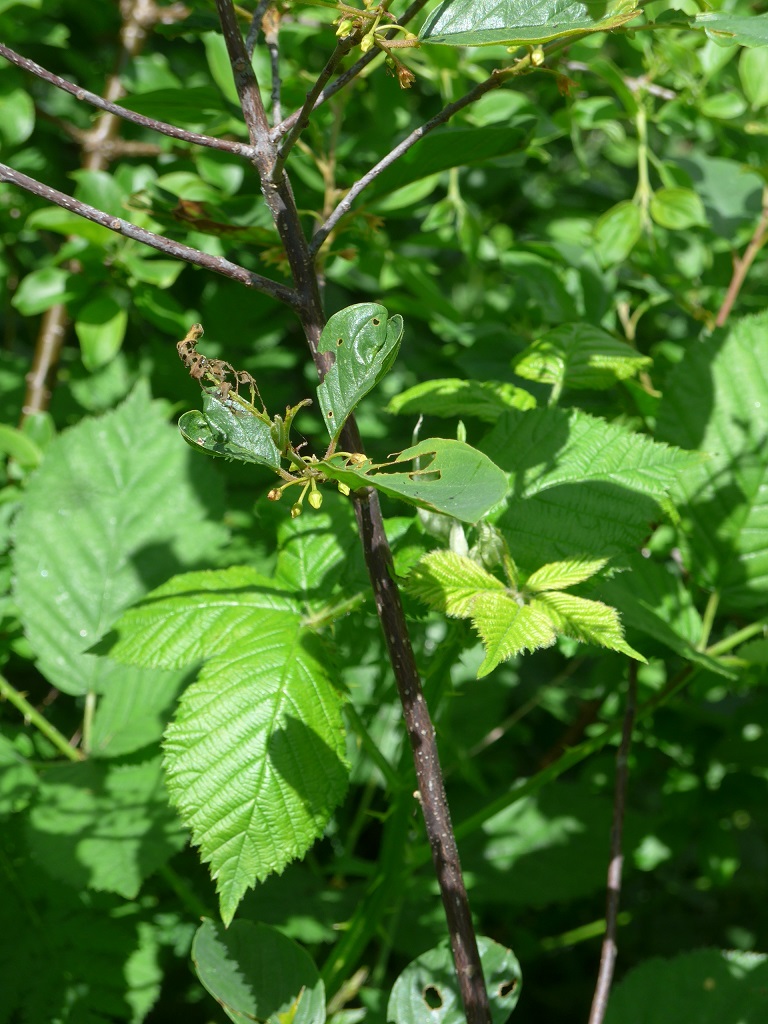 A male Brimstone butterfly has been seen flying along the bottom path since the beginning of April. It appeared again today but unlike the previous time we didn’t see a female. We live in hope of the Brimstones breeding on our site. In 2018 when we started to create the hedge we planted 3 Purging Buckthorns and 2 Alder Buckthorns, the main foodplants of Brimstone larva (caterpillars).
A male Brimstone butterfly has been seen flying along the bottom path since the beginning of April. It appeared again today but unlike the previous time we didn’t see a female. We live in hope of the Brimstones breeding on our site. In 2018 when we started to create the hedge we planted 3 Purging Buckthorns and 2 Alder Buckthorns, the main foodplants of Brimstone larva (caterpillars).
A study at Monks Wood National Nature Reserve found that 94% of the Brimstone eggs on the reserve were laid on just 2 buckthorn trees that were both in the sun and sheltered. Our trees are have the perfect conditions! The leaves of our Alder Buckthorns have been nibbled. Could this be Brimstone larva feeding? We haven’t found either caterpillars or eggs, and some of the nibbles look more like the work of Leaf-cutter bees.
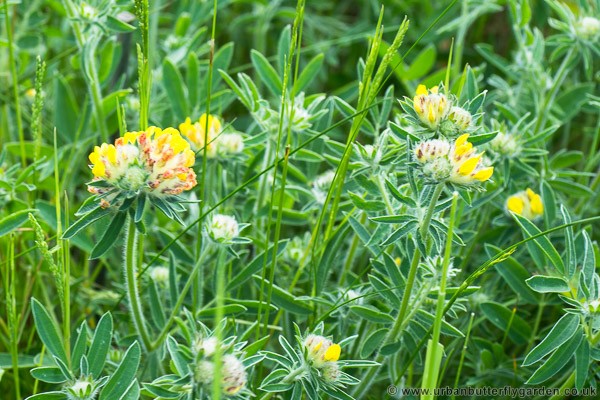 Sadly it seems certain that we have lost our colony of Small Blue butterflies which was on the west bank at the top of the site. Liz noted their absence last year and there is now even less Kidney Vetch (right), the larval foodplant of the Small Blue. The adult butterflies nectar on Common Bird’s-foot Trefoil and Horseshoe Vetch (as well as Kidney Vetch) and these are both still present on the bank. But without the Kidney Vetch they will not lay eggs there.
Sadly it seems certain that we have lost our colony of Small Blue butterflies which was on the west bank at the top of the site. Liz noted their absence last year and there is now even less Kidney Vetch (right), the larval foodplant of the Small Blue. The adult butterflies nectar on Common Bird’s-foot Trefoil and Horseshoe Vetch (as well as Kidney Vetch) and these are both still present on the bank. But without the Kidney Vetch they will not lay eggs there.
So what did we do:
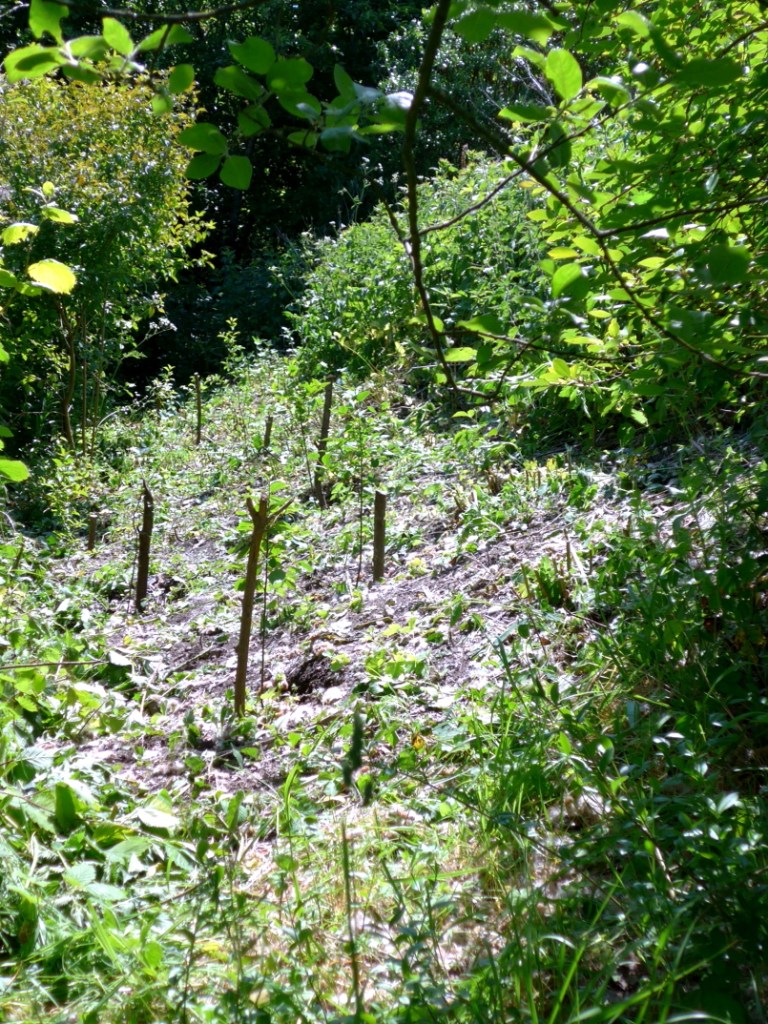 We cleared all the paths on the Nature site and the path leading down from the car park.
We cleared all the paths on the Nature site and the path leading down from the car park.- We opened up a short path to get to the recently planted saplings without having to trample over the Fly Honeysuckle at the top of the site.
- We watered the new saplings; all 8 are in leaf and thriving and we have gained an extra one! A small Hazel sapling has sprung up at the end of the row. This should develop into a very nice varied hedge. The marker sticks in the photo show where the saplings are – we don’t want to chop the trees down when we cut back the encroaching brambles!
- Filled the small pond which had dried out totally.
- In the Scrapes area we planted Common Bird’s-foot Trefoil which Liz had grown from collected seed.
When we opened up the Scrapes last year, we found a young cherry tree (above left). Its bark is beautiful at present, smooth to the touch with slightly raised ‘blobs’. It is most probably a Bird Cherry (Prunus padus) or a Cherry Plum (Prunus cerasifera) but it’s very difficult to identify for certain as the bark is so young and we haven’t yet seen it flower and fruit. It may be an ornamental but this is highly unlikely as it must be self-sown.
In December 2021 Special Branch Tree Nursery gave us a tiny Whitebeam, little more than 6″ high. We’ve nurtured it since and it’s grown into a beautiful little tree (2 photos above right). It had become completely swamped by brambles and was difficult to find.
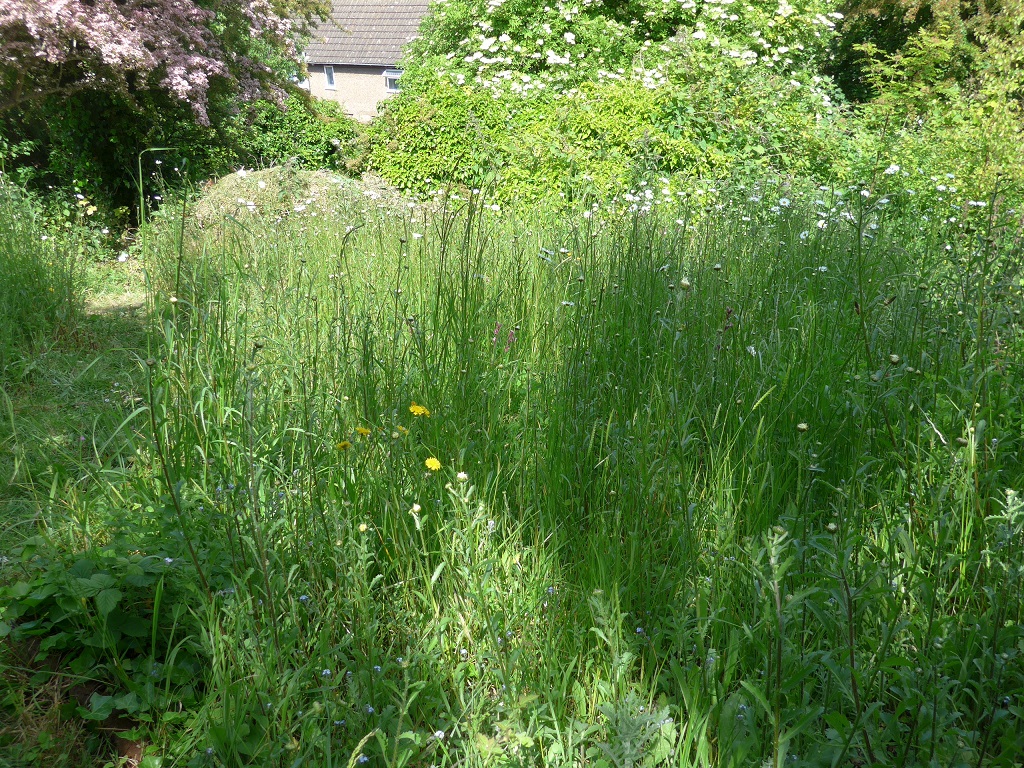 That same month we cleared a very stony area at the bottom of the site, full of brambles, nettles and bindweed. The following February Liz and Grecia cleared lots of the stones and sowed wildflower seeds.
That same month we cleared a very stony area at the bottom of the site, full of brambles, nettles and bindweed. The following February Liz and Grecia cleared lots of the stones and sowed wildflower seeds.
Just over a year later, this is the result – far better than we expected or could have hoped. This patch is now known as Grecia’s Meadow!
Rossano again brought along little Gustavo who apparently likes birdsong. Grecia has seen him smiling happily and wondered why. Then she has realised that birds are singing and Gustavo is listening.
Pictures below, clockwise from the left: Rossano with Gustavo; Grecia with shears; Liz clearing steps; Sally and Liz planting on the Scrapes; and Jim on the path below Grecia’s Meadow.
——————————————————————————————————————–
Nature Notes Thurs May 18th 2023
Present: Liz & Dave
Notes by Liz
The Nature Site looked so good on Sat at our work session, that Dave & I spent most of the following Thursday there as well. It was a sunny day so lots of creatures around. We wandered round, sat, listened and watched for over 4hrs. These are some of the creatures we saw (most exciting first).
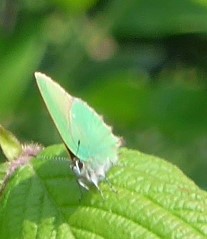 Green Hairstreak butterflies: These are small and though a brilliant emerald green when sitting still, when flying they move fast! We became aware of a sort of shimmering light then realised this was 2 small butterflies spiralling fast into the air. Their colour was unidentifiable, almost dark grey/silver. It wasn’t until we saw one resting on a hazel leaf that we could be positive. We saw 3 possibly 4 hairstreaks that day. As we’ve only seen them twice before on the Nature Site in 2018 & 2020 this was fantastic.
Green Hairstreak butterflies: These are small and though a brilliant emerald green when sitting still, when flying they move fast! We became aware of a sort of shimmering light then realised this was 2 small butterflies spiralling fast into the air. Their colour was unidentifiable, almost dark grey/silver. It wasn’t until we saw one resting on a hazel leaf that we could be positive. We saw 3 possibly 4 hairstreaks that day. As we’ve only seen them twice before on the Nature Site in 2018 & 2020 this was fantastic.
 Wasp beetle: This too was a fast mover and it took loads of totally duff shots of out of focus leaves before catching this pic. We saw at least 2 of them.
Wasp beetle: This too was a fast mover and it took loads of totally duff shots of out of focus leaves before catching this pic. We saw at least 2 of them.
We also saw Mint moths, a Blue Damselfly, Large Red Damselflies laying in the pond, Honey bees as well as the usual range of Bumblebees, and loads of Hoverflies of different species but too small and fast to identify.
Shield bug It was possibly Hairy or Woundwort, but there are so many Shield Bugs they are very tricky to identify. It was different from the Dock shield bugs we saw on Sat, as it had a chequered edge round it’s body. It too was on a hazel leaf (Hazel’s do seem to attract the insects).
Plants seen (new to our list of species) were as follows: Meadow buttercup (as well as Creeping B); Cranesbill – two new ones- Cut leaves cranesbill and Small flowered cranesbill; Heartsease; Great Burnet.
We also saw a large dog fox by the pond when we arrived.
Nature Notes Saturday May 13th 2023
Present: Liz, Simon, Jim, Rachel and Dave.
Apologies: Rossano, Grecia, Sally.
Notes by Liz
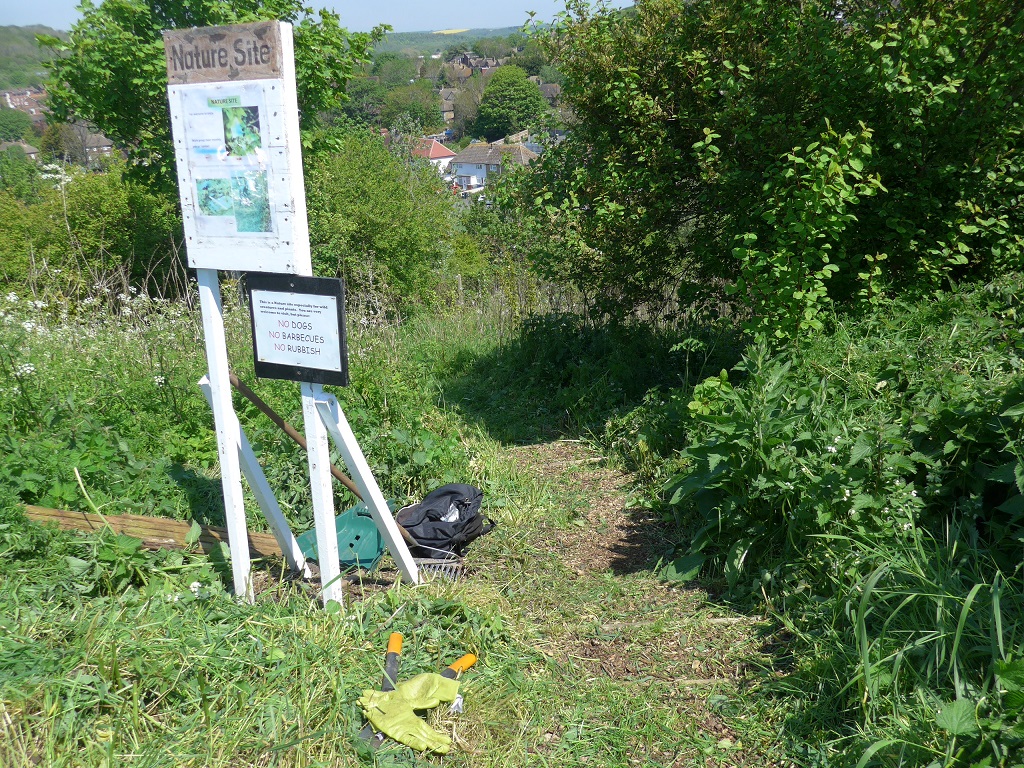 Spring has been cold, and wet! – the hence postponement of this work session by a week, but suddenly the grass and everything else has grown hugely. The paths had almost disappeared beneath long grass! It was a beautiful sunny day with a fresh northly wind to keep us cool while we worked.
Spring has been cold, and wet! – the hence postponement of this work session by a week, but suddenly the grass and everything else has grown hugely. The paths had almost disappeared beneath long grass! It was a beautiful sunny day with a fresh northly wind to keep us cool while we worked.
Jim cleared the steps down from the car park and around the Nature Site sign so people can see where to go now when they visit.
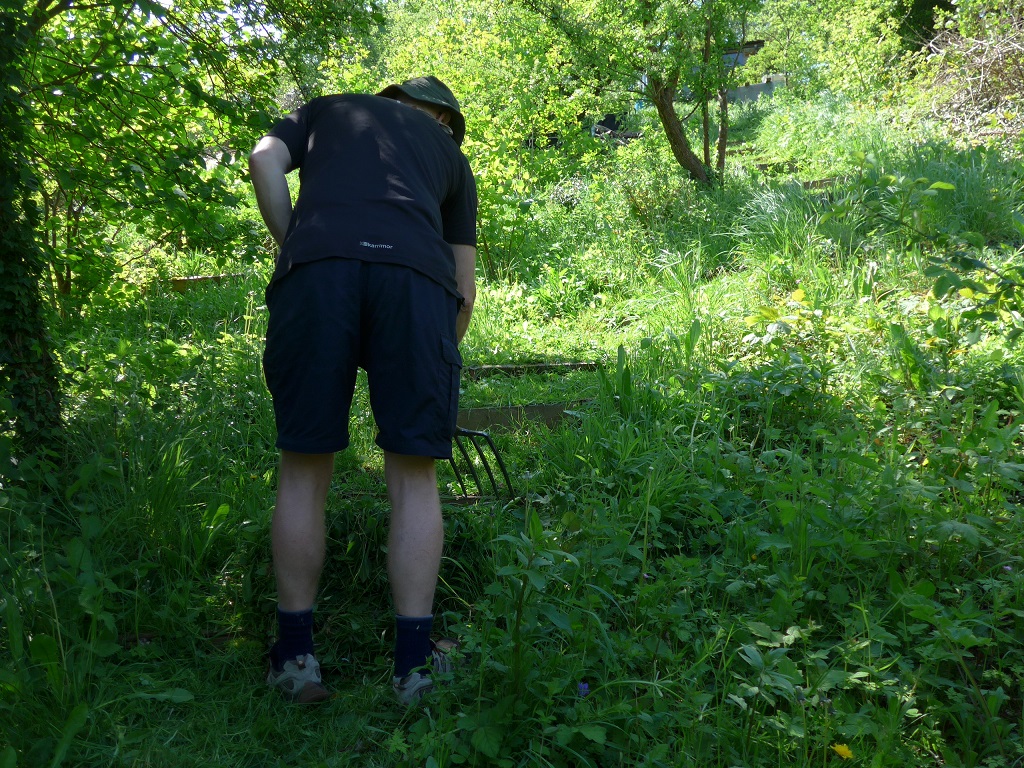 Simon cut all the other paths, plus the Hemp agrimony (urgh!) growth springing up on the newly sown wildflower Scrapes. We didn’t want to pull them out as this would disturb the newly sown wildflowers, so keeping them regularly snipped all summer will stop them flowering, spreading and may just make them give up altogether. Most of us had a go at cutting the tops off Hemp agrimony wherever we found it (there is a lot of it!)
Simon cut all the other paths, plus the Hemp agrimony (urgh!) growth springing up on the newly sown wildflower Scrapes. We didn’t want to pull them out as this would disturb the newly sown wildflowers, so keeping them regularly snipped all summer will stop them flowering, spreading and may just make them give up altogether. Most of us had a go at cutting the tops off Hemp agrimony wherever we found it (there is a lot of it!)
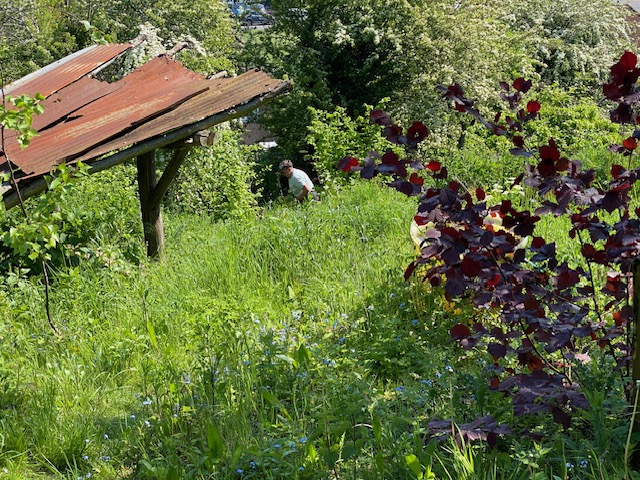 Dave and I selectively cut back the bank below the large pond. ‘Selectively’ as this should have been done a month ago before various flowers started growing tall. We tried to cut only long grass, brambles and ivy, leaving nettles and anything that flowered.
Dave and I selectively cut back the bank below the large pond. ‘Selectively’ as this should have been done a month ago before various flowers started growing tall. We tried to cut only long grass, brambles and ivy, leaving nettles and anything that flowered.
Rachel searched in vain for the red and pink polyanthus that had appeared amongst the wild primroses. We were going to dig them out to stop cross pollination with the wild species, but too late! All the flowers had gone over so it wasn’t possible to see which were which.
What did we see & hear?
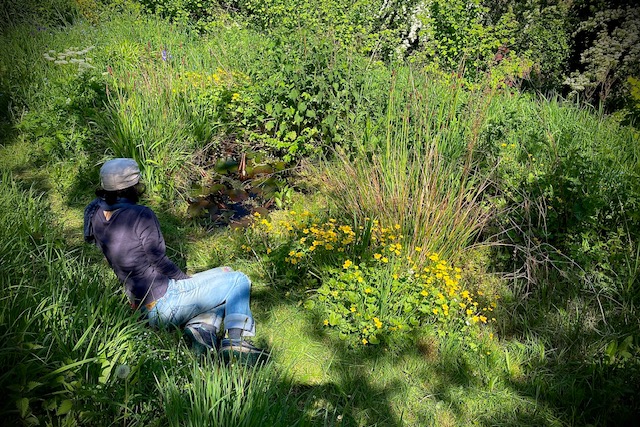 The site was looking great, loads of hawthorn blossom, and many other flowers too. The pond was especially colourful with Marsh marigold flowers, the first Irises, & some blue Brooklime flowering.
The site was looking great, loads of hawthorn blossom, and many other flowers too. The pond was especially colourful with Marsh marigold flowers, the first Irises, & some blue Brooklime flowering.
We watched 3 or 4 Smooth newts frisking in the pond, but also 2 young frogs proving that they can co-exist. Newts eat any small invertebrate, on land or in water, including tadpoles. However, Dragonfly nymphs can also eat newt tadpoles and eggs so it would seem a balance is struck between different pond species.
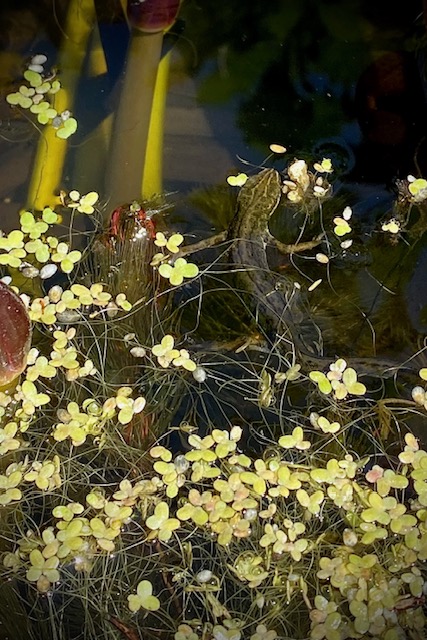 Newts spend time in ponds from Feb to June to mate and lay eggs. Each egg is wrapped by the female in a leaf under water. It hatches into a tadpole-like creature, that gradually changes into a young newt over the next few months. Unlike tadpoles, newt tadpoles develop front legs first, before back legs Newts spend most of the year on land, the new juveniles joining them in late summer. They shelter under logs, stones or other debris or sheds etc, and eat slugs amongst other invertebrates (hurray!).
Newts spend time in ponds from Feb to June to mate and lay eggs. Each egg is wrapped by the female in a leaf under water. It hatches into a tadpole-like creature, that gradually changes into a young newt over the next few months. Unlike tadpoles, newt tadpoles develop front legs first, before back legs Newts spend most of the year on land, the new juveniles joining them in late summer. They shelter under logs, stones or other debris or sheds etc, and eat slugs amongst other invertebrates (hurray!).
There were also the first Large red Damselflies, one pair mating on the pond plants, and many different types of hoverfly, one being the fat ‘marmalade hoverfly’ that glistened in the sunshine.
Insects were everywhere and many different species. We watched several brown shield bugs, a green one, and loads of different tiny spiders, one with bright yellow/green body with red blob on its bum.
We saw two tiny, shiny ‘things’ on a leaf, that were only identifiable after Simon photographed and blew the picture up, revealing lovely baby Crickets.
While we were having lunch we watch a ‘white butterfly’ repeatedly landing on trees in the bottom hedge. I had a hunch it wasn’t a ‘White’ but a female Brimstone (very pale yellow). It was looking for and hopefully laying eggs on their caterpillar foodplant, Alder buckthorn and Purging buckthorn trees. This was why we planted them & it seems to have worked in encouraging these lovely large yellow butterflies to our site.
These are more of the creatures we saw.
Poss. Crab spider Hazel leaf-roller weevil (Apoderus coryli)
Spider (?) Large Red damselfly Dock bug (Coreus marginatus)
Common frog Speckled wood butterfly
Nature Notes Saturday 2nd April 2022
Present: Tara, Julie, Liz, Grecia, Sally, Simon and Dave
Notes by Dave
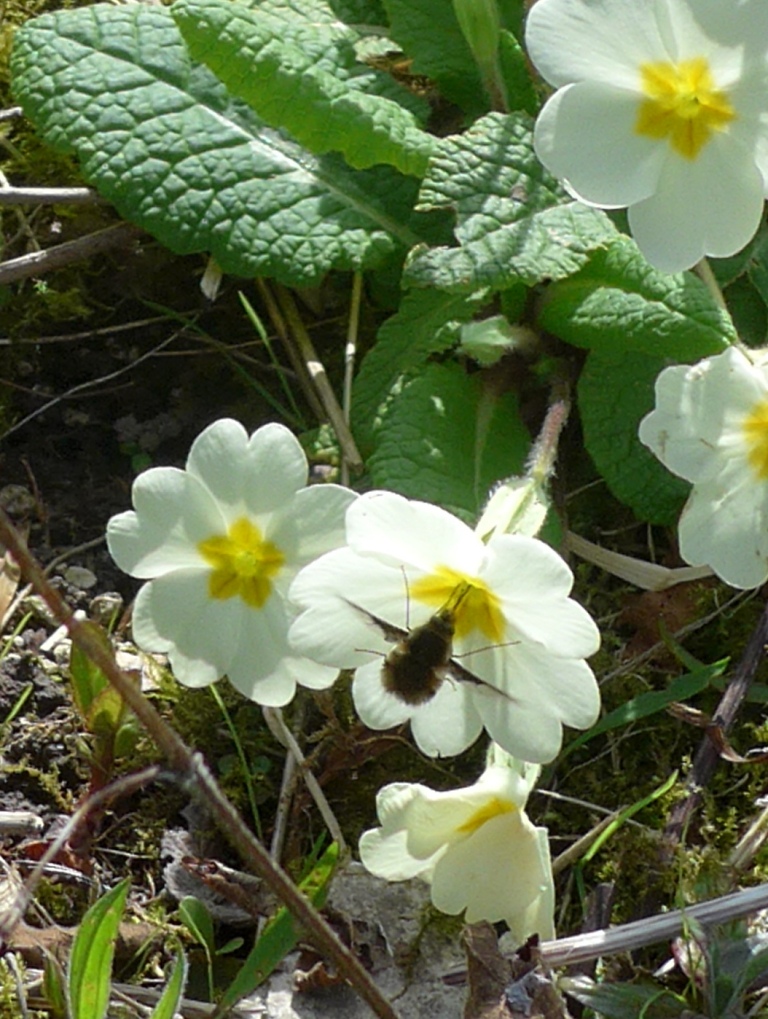 It was a beautiful sunny day and the site looked wonderful with nature really waking up. Queen bumblebees and honey bees were feeding on the Goat Willow catkins, Bee-flies were dipping into the Primroses, two Comma butterflies were basking in the sun by the side of the small pond and a male Large White was sampling Dandelion flowers.
It was a beautiful sunny day and the site looked wonderful with nature really waking up. Queen bumblebees and honey bees were feeding on the Goat Willow catkins, Bee-flies were dipping into the Primroses, two Comma butterflies were basking in the sun by the side of the small pond and a male Large White was sampling Dandelion flowers.
Chiffchaffs sang almost continually with their repetitive ‘chip-chap’ song. It’s astonishing to think that such tiny birds migrate all the way from Africa. We also heard and saw Blackcaps, Willow Warblers, a Chaffinch and a Blackbird. It was so glorious that Liz and I spent the following morning there just looking and listening.
We were pleased to welcome Julie who fairly recently acquired a plot on the allotment site. The main task for the day was planting 8 saplings. We were again offered some free saplings by Special Branch and Tara collected them a fortnight ago. It was very late to be planting trees, especially as some were coming into leaf, but these are all tough and should survive – 3 Alder Buckthorns, 3 Purging Buckthorns and 2 Blackthorn.
We planted them along the fence line, just outside the Nature site. We first had to clear a strip of ground, mattocking out brambles, ivy and nettles. The saplings replaced some which died in the scorching hot summer of the first Covid-19 year.
Rossano paid a visit with little Gustavo who was immediately the centre of attention!
 Liz was very restricted following a minor op on her hand but she and Grecia planted out Kidney Vetch and Viper’s-bugloss on the ‘Scrapes’ (the westward extension). Small Blue butterflies lay their eggs deep inside the Kidney Vetch flowers for the caterpillars to feed on as they hatch out. We had a small breeding colony of Small Blues at the top of the site. Unfortunately the Kidney Vetch has disappeared, probably because that area has become too shady, and we seem to have lost colony as a result. Hopefully the sunny Scrapes will be a better habitat for both plant and butterfly.
Liz was very restricted following a minor op on her hand but she and Grecia planted out Kidney Vetch and Viper’s-bugloss on the ‘Scrapes’ (the westward extension). Small Blue butterflies lay their eggs deep inside the Kidney Vetch flowers for the caterpillars to feed on as they hatch out. We had a small breeding colony of Small Blues at the top of the site. Unfortunately the Kidney Vetch has disappeared, probably because that area has become too shady, and we seem to have lost colony as a result. Hopefully the sunny Scrapes will be a better habitat for both plant and butterfly.
 The risers and logs edging the steps are covered in lichens, as are the log piles and tree branches. Lichens are so common that we hardly notice them. They are everywhere – on rocks, wood, cliffs, even in deserts stabilising the sandy floors. This one was on a Crab Apple. I know next to nothing about lichen identification but in my FSC guide it looks like Evernia prunastri which is widespread across the country.
The risers and logs edging the steps are covered in lichens, as are the log piles and tree branches. Lichens are so common that we hardly notice them. They are everywhere – on rocks, wood, cliffs, even in deserts stabilising the sandy floors. This one was on a Crab Apple. I know next to nothing about lichen identification but in my FSC guide it looks like Evernia prunastri which is widespread across the country.
Lichens are extraordinary. They are able to dissolve and absorb minerals in rocks; when they die and decompose the inanimate mineral becomes part of the soil and part of the life cycle. Some of the minerals in all of our bodies have probably passed through a lichen!
Their biology is remarkable too. They are a symbiosis between a fungus and an alga or a photosynthetic bacterium. The fungus gains the ability to photosynthesise and the alga or bacterium gains the means of growing protective tissue or digesting rock. But they aren’t either fungus or alga/bacterium; together they form a separate organism. Recent discoveries show they are even more complex – many lichens also contain a yeast and some have more than one fungal partner. So far biologists have not been able to devise a complete definition of a lichen.
We are seeing the first Lords and Ladies leaves. Those in my photo (above left) are in a sunny spot, but the plants are appearing all over the site. While we were having lunch, Tara described the plant’s remarkable reproductive process. Very soon the spike of flowers (the spadix, pictured above) will emerge, with the female flowers hidden at the base and male flowers above them. The spadix generates heat and a strong scent which attracts insects; these are trapped by hairs in the plant and coated with pollen from the male flowers. The insects are then ejected and fly off to spread the pollen to the female flowers of other Lords & Ladies plants. In the autumn the female flowers form the familiar cluster of red berries; these are very poisonous to humans.
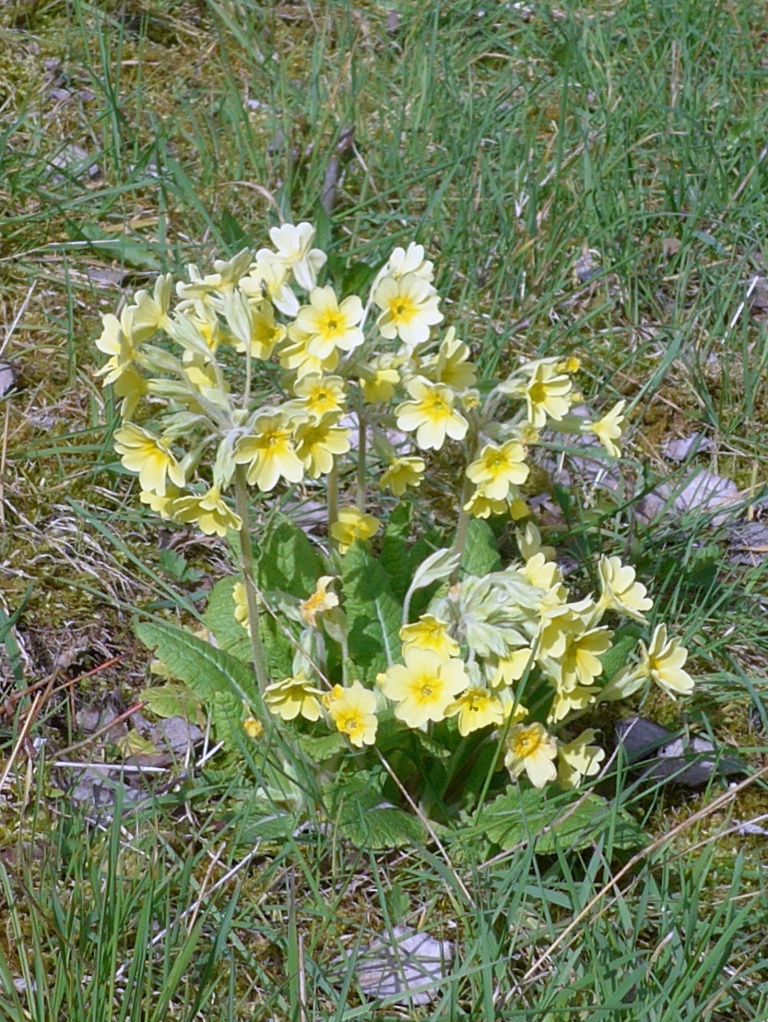 We seem to have lost the Cowslips from the top banks, with False Oxlips appearing instead. Where Cowslips (Primula veris) and Primroses (Primula vulgaris) grow close together they frequently hybridise to form a False Oxlip (Primula veris x vulgaris). The False Oxlip varies considerably but it is generally a larger plant than the Cowslip, and it flowers on all sides unlike Cowslips which flower on one side only. However it can be hard to tell the two apart.
We seem to have lost the Cowslips from the top banks, with False Oxlips appearing instead. Where Cowslips (Primula veris) and Primroses (Primula vulgaris) grow close together they frequently hybridise to form a False Oxlip (Primula veris x vulgaris). The False Oxlip varies considerably but it is generally a larger plant than the Cowslip, and it flowers on all sides unlike Cowslips which flower on one side only. However it can be hard to tell the two apart.
There is also an Oxlip (Primula elatior) which is found only in East Anglia according to my book.
Sally did some more work on the Dog Rose area at the bottom of the site. She has been turning it into a varied habitat and it now also looks very attractive. Rachel came just as we were finishing work and she planted some Wild Garlic plants in the bottom hedge.
We were very pleased to have several sightings of Small Tortoiseshell butterflies. Last year we saw hardly any, either on the Nature site or elsewhere, and it was a bad year for many species. Monitoring by Butterfly Conservation shows that the Small Tortoiseshell had its fourth worst year on record. In fact all butterflies were severely affected by the heatwave and drought of 2022, as the food plants of their caterpillars died in the drought. Species with more than one generation in a year declined last year; the effect on single-generation species may well be seen this year.
It’s not the first time butterflies have been affected by a drought. In the record summer of 1976 heat hit butterflies very hard. But the difference now is that butterfly species were already in decline; Butterfly Conservation’s ‘State of the UK’s Butterflies’ report reveals that 80% of butterflies have declined since the 1970s. Such a massive decrease is alarming as butterflies are an integral part of the ecosystem and this decline indicates a wider biodiversity crisis.
 Moths too were hit by the drought, but the Scarlet Tiger seems to be thriving. We found its caterpillars (right) on White Comfrey and other plants, and there are massive numbers over the entire allotment site.
Moths too were hit by the drought, but the Scarlet Tiger seems to be thriving. We found its caterpillars (right) on White Comfrey and other plants, and there are massive numbers over the entire allotment site.
In January 2020 we identified the caterpillar of a Ruby Tiger but we have yet to see the spectacular moth itself.
When Liz and I were on the Nature site on Sunday, a male Brimstone butterfly flashed past several times showing off its gorgeous yellow colouring. We also spotted two Common Newts in the large pond. You can just make out the dark shape of one of them to the left of the Water Lily leaf in the photo on the left.
Liz went round the site identifying plant species; this requires a good knowledge of their leaves and shoots as most are not in flower yet, and good eyesight!
Liz has just compiled the list of species sighted on the Nature site in 2022. These are on the website at https://moulsecoomballotments.wordpress.com/nature-site/ This page also has lots of other info about the site.
References:
Butterfly Conservation: impact of drought on butterfly populations 2022
hot-dry-summer-impacts-uk-butterfly-populations
Butterfly Conservation report
https://butterfly-conservation.org/state-of-uk-butterflies-2022
The ‘Wild Flower Key’ by Francis Rose is one of the definitive guides to British Wild Flowers
https://www.nhbs.com/the-wild-flower-key-book
Photo of Lords & Ladies spadix courtesy of Plantlife https://www.plantlife.org.uk/learning-resource/lords-and-ladies/
Field Studies Council ‘Guide to Common Lichens’ https://www.field-studies-council.org
Nature Notes Saturday March 4th 2023
Present: Liz, Simon, Grecia, Sally, Jim and Dave.
Apologies: Rossano, Tara, Rachel.
Notes by Liz
 A cold, cloudy day, but not much wind so good for working hard which is what we all did.
A cold, cloudy day, but not much wind so good for working hard which is what we all did.
It was great to see Grecia again after the birth of Gustavo, who was also given his first introduction to conservation work by Rossano- not sure if he was listening though!
Grecia and Sally cleared an area under the trees to plant a small red Hazel that had appeared from nuts planted by a squirrel on our plot. They also finished the winter cut back of brambles in the same area.
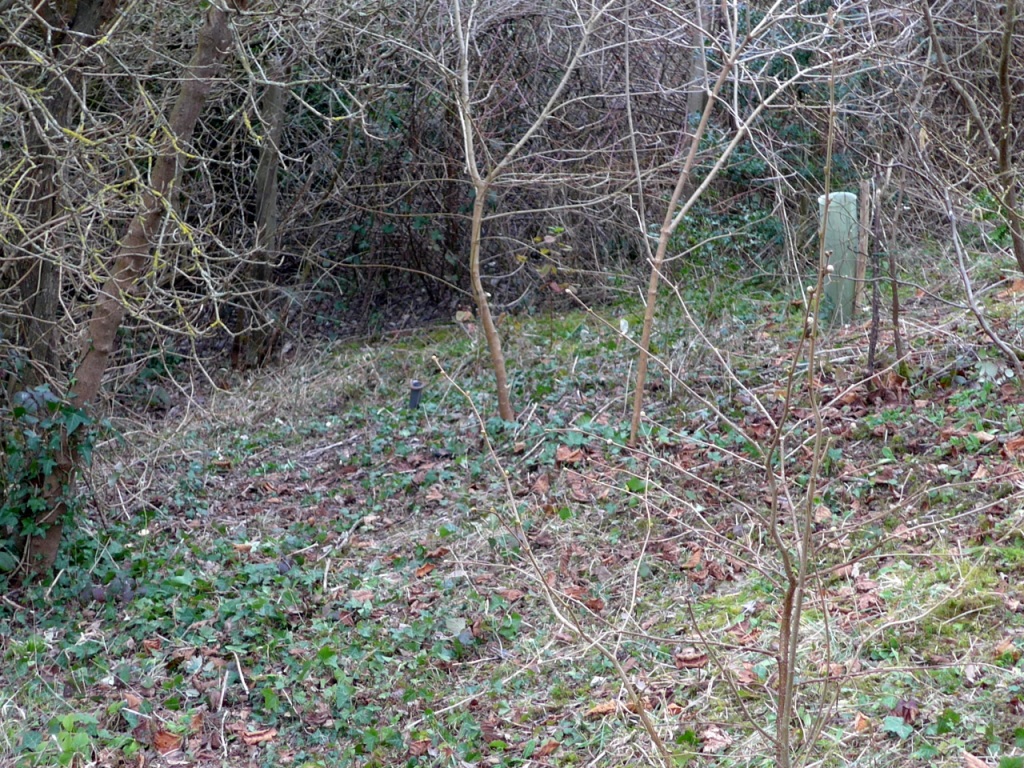 Dave worked on the area below the small pond. We planted half a dozen trees 8 years ago and their access to light was getting cut out by rampant new growth from the existing mature Wayfaring tree (Viburnum lantana). Dave cut out surplus branches and suckers giving more light to the younger trees as well as the primroses at their base.
Dave worked on the area below the small pond. We planted half a dozen trees 8 years ago and their access to light was getting cut out by rampant new growth from the existing mature Wayfaring tree (Viburnum lantana). Dave cut out surplus branches and suckers giving more light to the younger trees as well as the primroses at their base.
 Earlier in the week, Dave & I planted a small self-sown Honeysuckle (Lonicera periclymenum). We put it at side of trees West side above Jim’s water tank.
Earlier in the week, Dave & I planted a small self-sown Honeysuckle (Lonicera periclymenum). We put it at side of trees West side above Jim’s water tank.
Jim, Simon & I worked on the new, western extension. We wanted to create a wildflower meadow as this is the sunniest part of the Nature Site. We could just have sown it as it was, – a steep slope down the hill towards Bevendean, however I had recently read a report about Brighton & Hove Council’s ‘Wilder verges’ & Town to Down’ project. It is hoped that small as  many are, these areas help increase the overall number of insects in the City, countering the frightening National decline (64% since 2004). Graeme Lyons an ex SWT ecologist, was hired in 2020 to survey 19 ‘butterfly bank’s and wildflower areas to see how beneficial they have been, and whether some sites were more beneficial than others. You can read the full report (link attached), it is long and technical but fascinating. The report found that scrapes attract more than double (10% v 4.3%) the invertebrate species with conservation status compared to ‘butterfly banks’ and flat areas.
many are, these areas help increase the overall number of insects in the City, countering the frightening National decline (64% since 2004). Graeme Lyons an ex SWT ecologist, was hired in 2020 to survey 19 ‘butterfly bank’s and wildflower areas to see how beneficial they have been, and whether some sites were more beneficial than others. You can read the full report (link attached), it is long and technical but fascinating. The report found that scrapes attract more than double (10% v 4.3%) the invertebrate species with conservation status compared to ‘butterfly banks’ and flat areas.
Wilder Verges project (brighton-hove.gov.uk)
A Scrape is where a patch of ground has been excavated to scrape away fertile soil leaving chalky soil where only chalk wildflowers are likely to grow, unimpeded by grass, which demands richer soil. The depth at one end (minimum 0.5mts) provides a warm hollow, sheltered from the wind in which insect can bask, or burrow to lay eggs. Bare soil was also very important, the best being 50% bare, but not compacted trampled soil which insects found hard to burrow into.
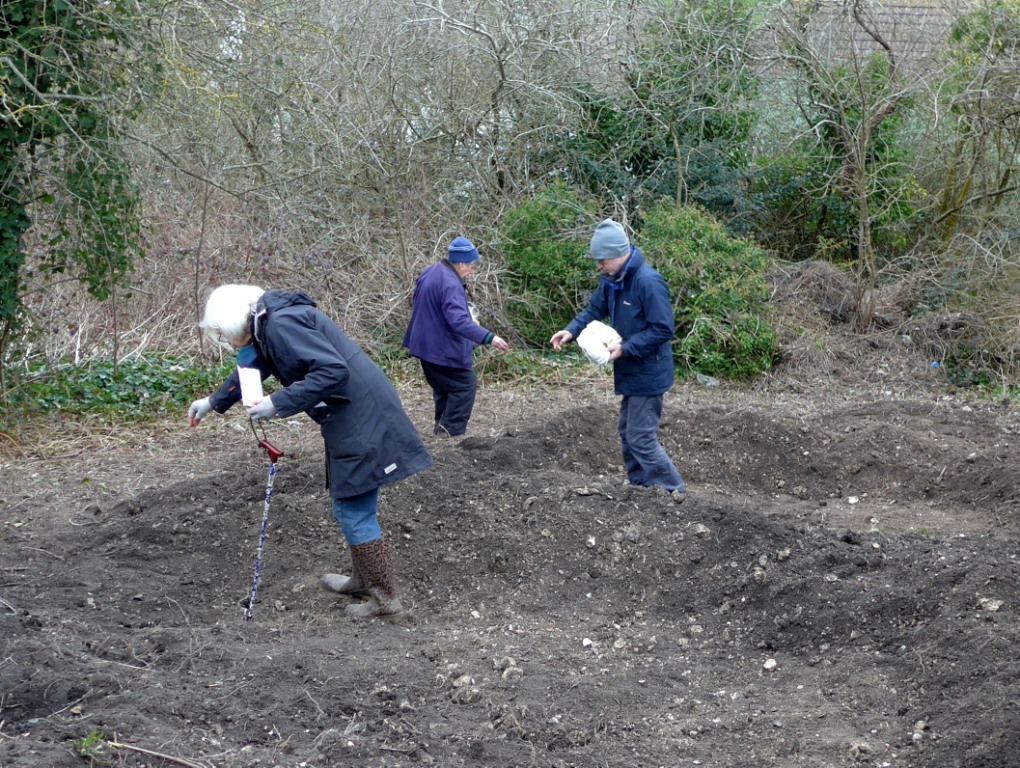 We made our scrapes circular, or bomb crater shaped with a higher lip at the down/ north end to trap the most sun and warmth on its slope.
We made our scrapes circular, or bomb crater shaped with a higher lip at the down/ north end to trap the most sun and warmth on its slope.
We all scattered wildflower seed liberally over the whole area.
Seeds were either bought ‘wildflower and annual cornfield mix ‘(cornflowers, corn marigolds, etc ) or perennial seeds I had collected from Downland flowers, incl Knapweeds, Mallows, Campions, Wild carrot, Yarrow, Scabious, Sainfoin, Clovers, Agrimony, Kidney vetch and Trefoils. We hope there will also be seeds in the soil dropped from last year’s wildflower annuals.
What did we see & hear?
Birds heard were Blue and Great Tits, Robins, Sparrows, a Dunnock & Magpies of course. A Blackbird came to investigate the newly turned soil for worms. The Hellebores were still flowering and looked spectacular, as did the Catkins and fir cones on the Alder trees, and Catkins on the Hazels.
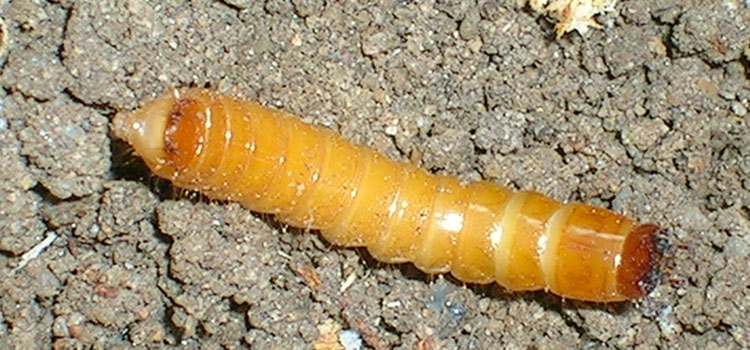 We found a ‘caterpillar’ while moving soil, that I think is probably a wireworm larvae, it looked very familiar from our allotment. The adult is a beetle, but for around 3 years is a larvae in soil eating roots esp potato crops!
We found a ‘caterpillar’ while moving soil, that I think is probably a wireworm larvae, it looked very familiar from our allotment. The adult is a beetle, but for around 3 years is a larvae in soil eating roots esp potato crops!
Nature Notes Sunday 15th Jan 2023
Present: Liz, Simon, Rossano, Sally, Rachel and Dave.
Apologies: Jim, Tara, Tina
Notes by Liz
At last, a dry day after cancelling Sat 7th (rain) and Sat 14th (rain again). We even got some sun which was very nice after weeks, and weeks of dark and wet.
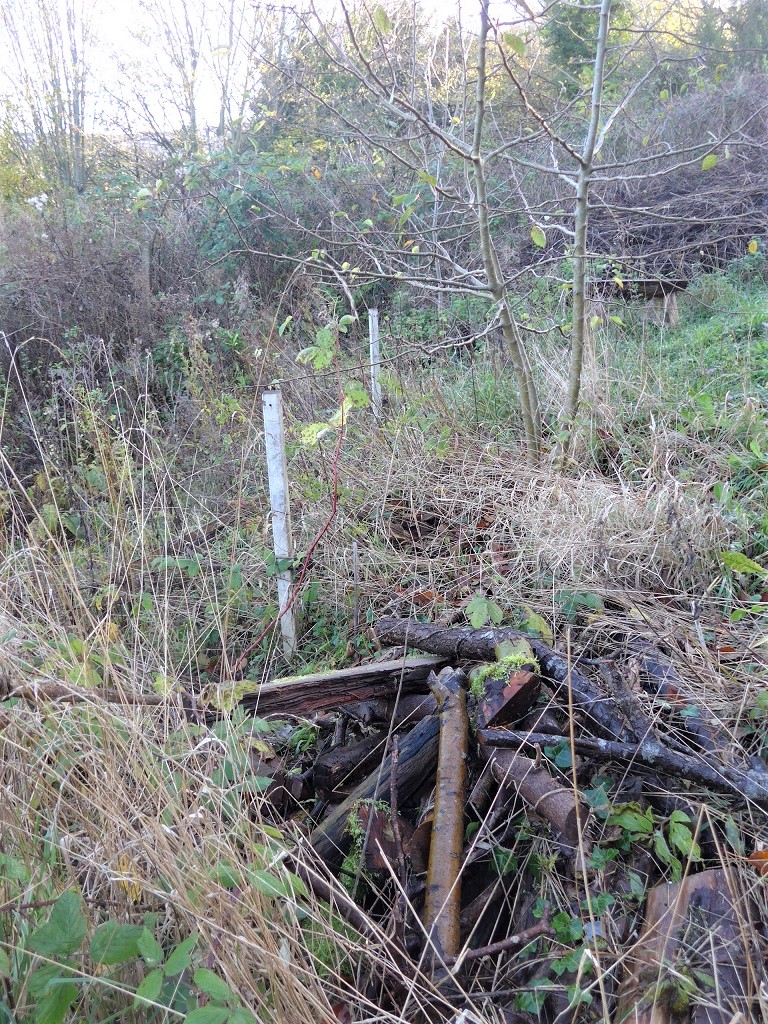
After so long, the work had piled up a bit. (pic left taken Nov) The fence round the small pond had totally collapsed, so too had several steps. There were outstanding flower/grass beds to be cut back, and I still had lots of wildflower seeds to sow. It was really great that so many people had come to this session, and we did so much we not only caught up with the work needed, we even made substantial in-roads on clearing the new Western area.
Dave made a new fence and cut back the whole area round the small pond.
Simon rebuilt a whole section of collapsed or weak steps. He also relocated the small Rowan tree growing below the large pond. It has now joined the blackthorn hedge at the side of the small pond.
Liz & Sally cut back bottom of west bank flower bed, pulled out tonnes of invading ivy, and made small patches of bare soil for Rachel to sow seeds.
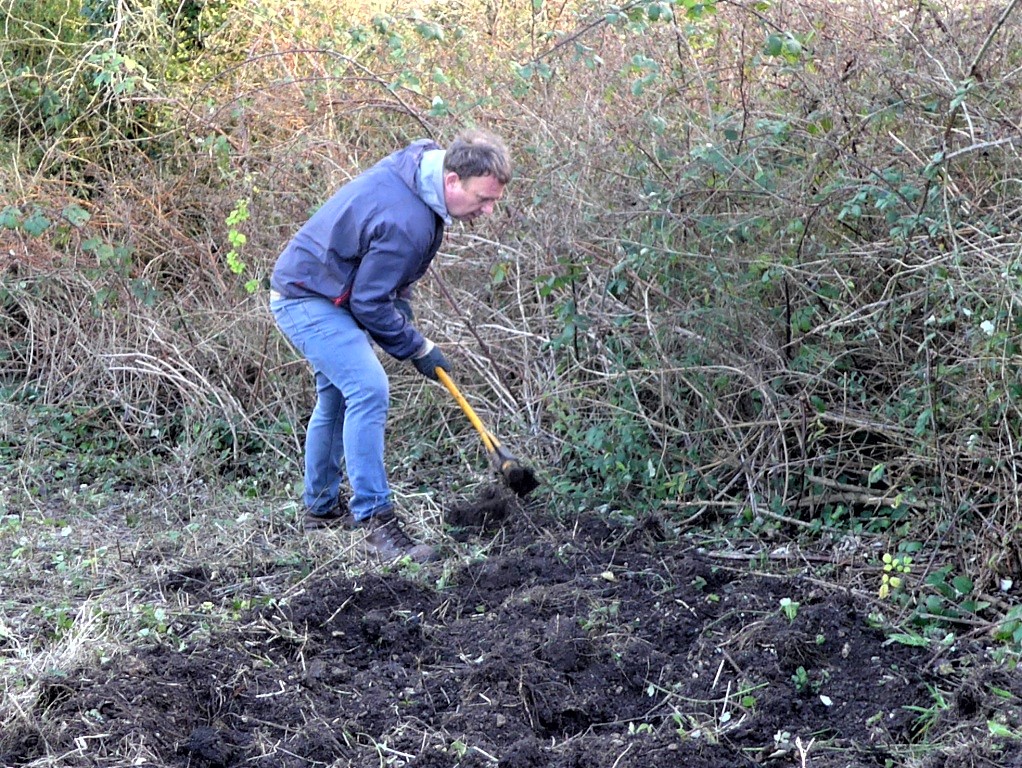 Rossano took the mattock to the new and overgrown western patch, cut everything back and mattocked out most of the remaining bramble roots. The plan is that he & Simon will complete the whole area up to the trees ready for wildflower sowing by March. At some point they will install a bench under the trees, and create a path. With so few of us (and most of us elderly) at most sessions, most of this work will take place outside regular work sessions as we need their fitness and muscles to help keep up with general monthly maintenance work.
Rossano took the mattock to the new and overgrown western patch, cut everything back and mattocked out most of the remaining bramble roots. The plan is that he & Simon will complete the whole area up to the trees ready for wildflower sowing by March. At some point they will install a bench under the trees, and create a path. With so few of us (and most of us elderly) at most sessions, most of this work will take place outside regular work sessions as we need their fitness and muscles to help keep up with general monthly maintenance work.
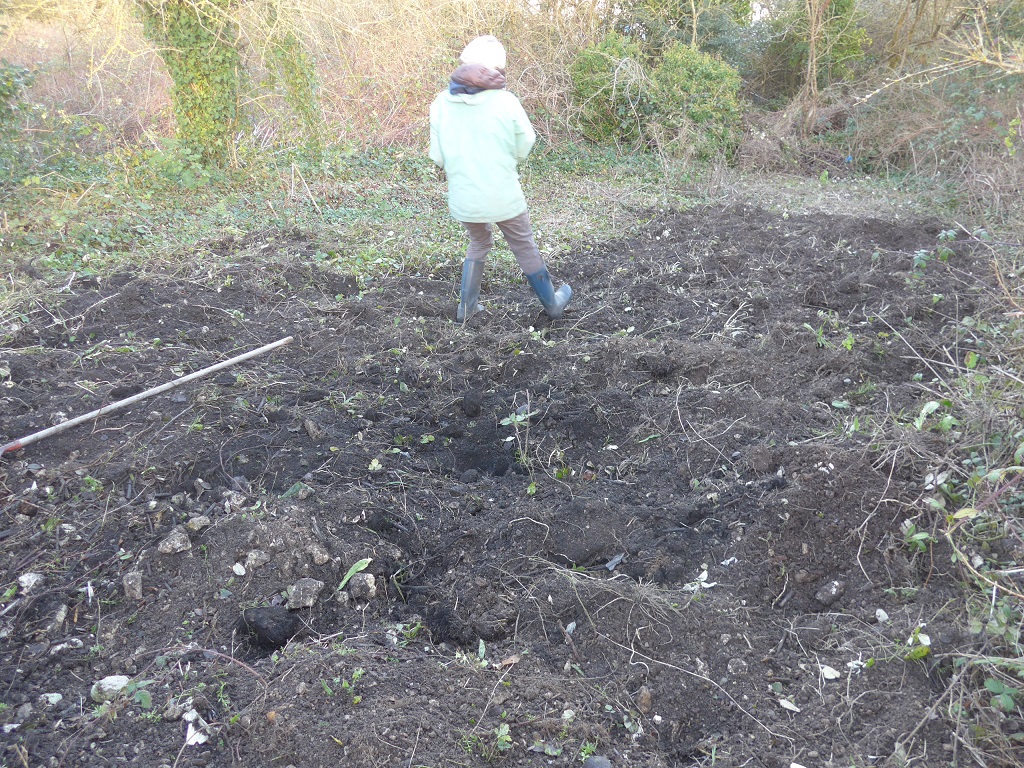
Rachel did loads of clearing up after all of us- collecting mountains of debris and chucking it on various ‘dead piles’.
What did we see:
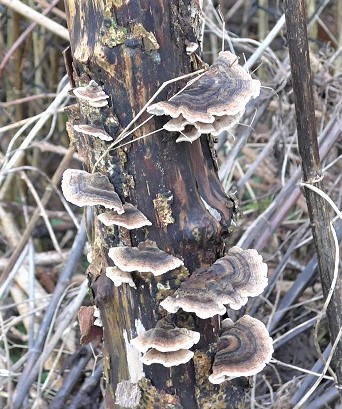 Beautiful ‘bracket’ fungi on rotting post. Probably a ‘Turkeytail’ – (Trametes versicolor): grows on wood of wide range of deciduous trees & shrubs; extremely common.
Beautiful ‘bracket’ fungi on rotting post. Probably a ‘Turkeytail’ – (Trametes versicolor): grows on wood of wide range of deciduous trees & shrubs; extremely common.
We heard or saw: blue tits, sparrows, robin, crow, magpie, but it was very quiet on the bird front. Two very large domestic cats squared up for a fight at one point.
Nature Notes Saturday 3rd December 2022
Present: Liz, Tara and Dave. (Sally for 5mins then disappeared)
Apologies: Rossano, Grecia, Jim, Simon, Giulia and Rachel
Notes by Liz
A very cold, damp day with a NE wind, brrrrr! But at least it is dry, – unlike November’s session which had to be cancelled due to torrential rain. The ground was wet, and paths slippery so we had to be careful especially on steps.
With so few of us, and me with only one hand working (hand surgery 2 weeks before), work had to be limited to essentials. Tara had strimmed all the paths several weeks before, and despite lots of rain and mild weather, weren’t too overgrown.
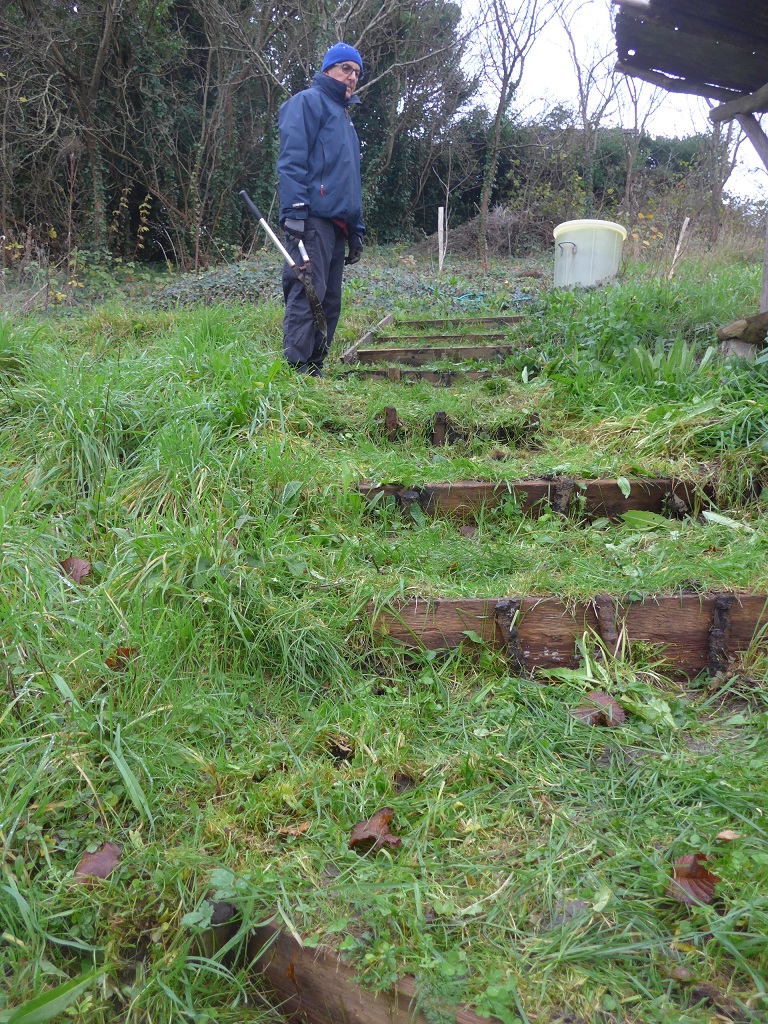 Dave cut path edges, then strimmed (thanks to Tara’s strimmer) most of the paths. Tara dug up Hemp agrimony from top (east & west) flower banks, I hacked one-handed to expose extra patches of soil, then sowed Kidney vetch seeds on the West bank where we have had breeding colonies of Small blue butterflies for several years until last summer. Kidney vetch is an essential food plant for their caterpillars, but seems to have diminished in number, which may account for lack of Small blue butterflies. Hopefully, now we have created more light on this bank by removing 2 trees, and re-sowed Kidney vetch, the Small blue’s will return and breed here again.
Dave cut path edges, then strimmed (thanks to Tara’s strimmer) most of the paths. Tara dug up Hemp agrimony from top (east & west) flower banks, I hacked one-handed to expose extra patches of soil, then sowed Kidney vetch seeds on the West bank where we have had breeding colonies of Small blue butterflies for several years until last summer. Kidney vetch is an essential food plant for their caterpillars, but seems to have diminished in number, which may account for lack of Small blue butterflies. Hopefully, now we have created more light on this bank by removing 2 trees, and re-sowed Kidney vetch, the Small blue’s will return and breed here again.
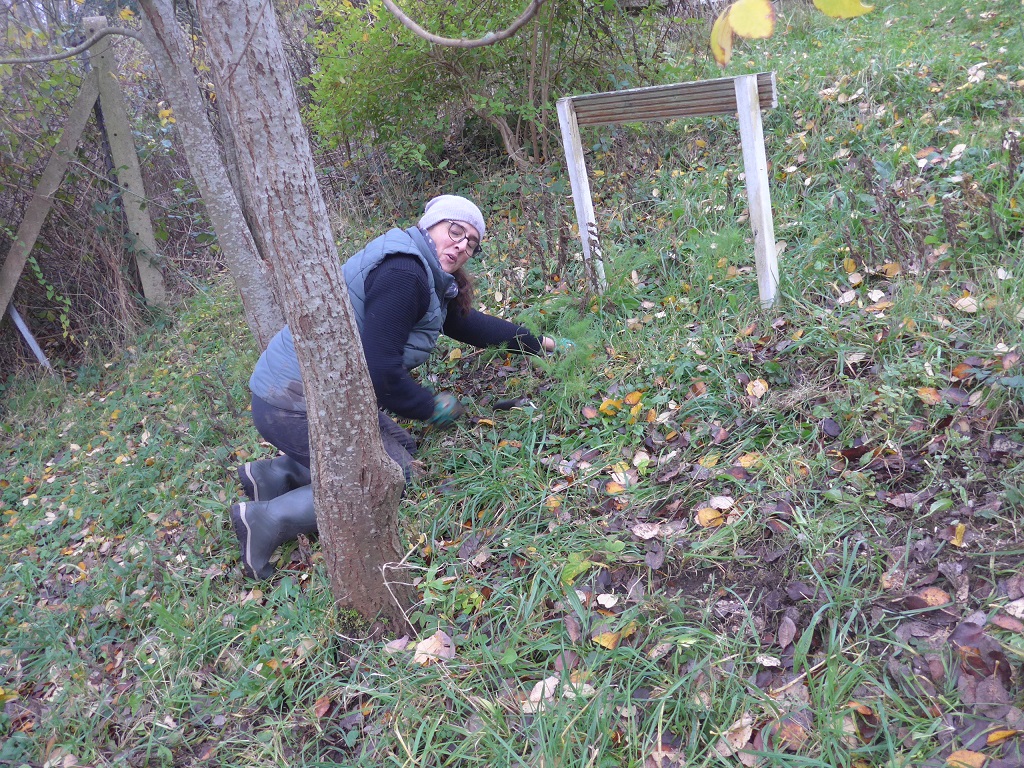 On the East bank, Tara managed to dig out most of the remaining Hemp agrimony, and I sowed mixed wild flower seeds. I collected huge amounts of seed this summer, mainly from our own plot, and these are a mix of large, tough perennials that will cope with dappled shade, Red & White campions, Knapweeds, Yarrow, grasses etc. Over the years we have sown and planted a huge amount of wildflowers on this bank, and though it still looks predominantly grass in summer, Tara & I noticed far more flower plants now – though mostly Oxeye daisy. We saw the Foxglove plants Rachel had planted a few weeks ago, these will also be happy in some shade from the Goat willow trees, and look great.
On the East bank, Tara managed to dig out most of the remaining Hemp agrimony, and I sowed mixed wild flower seeds. I collected huge amounts of seed this summer, mainly from our own plot, and these are a mix of large, tough perennials that will cope with dappled shade, Red & White campions, Knapweeds, Yarrow, grasses etc. Over the years we have sown and planted a huge amount of wildflowers on this bank, and though it still looks predominantly grass in summer, Tara & I noticed far more flower plants now – though mostly Oxeye daisy. We saw the Foxglove plants Rachel had planted a few weeks ago, these will also be happy in some shade from the Goat willow trees, and look great.
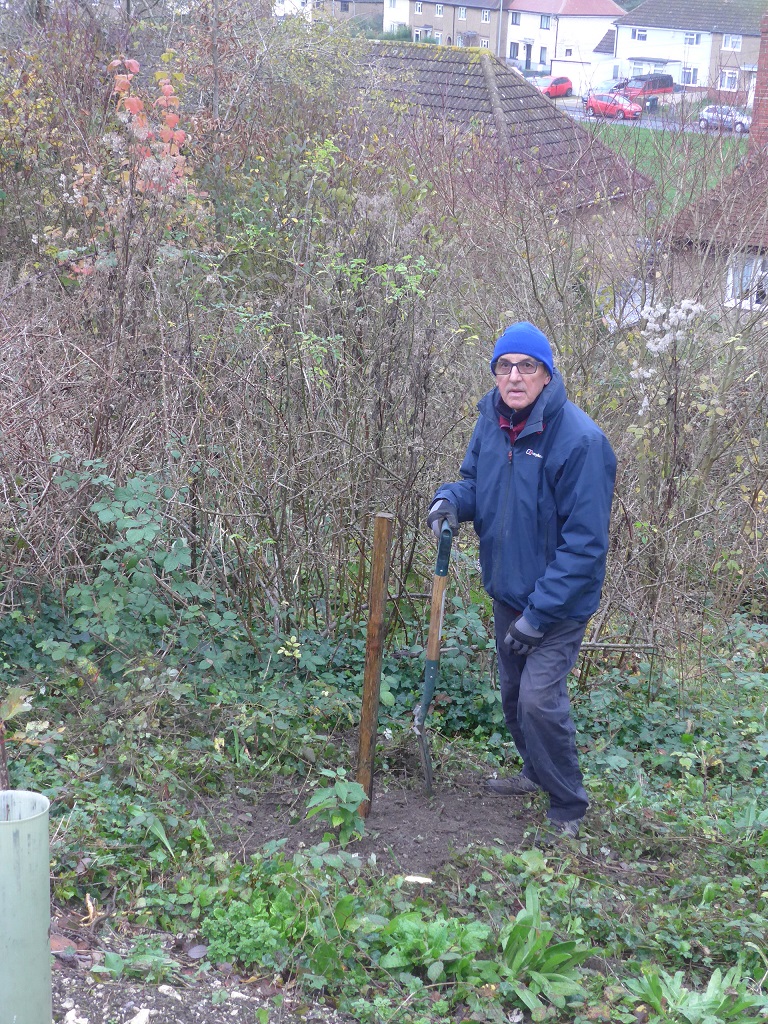 I still have huge amounts of seed, but it will need some work and muscle to clear encroaching ivy from the patch below Jim’s water butt before we can sow them. A job for Rossano or Simon I think.
I still have huge amounts of seed, but it will need some work and muscle to clear encroaching ivy from the patch below Jim’s water butt before we can sow them. A job for Rossano or Simon I think.
Dave and I also planted a small wild cherry tree – suckers from our domestic cherry tree on our plot. Domestic fruit is grafted onto different wild rootstock and cherry growers use wild cherry, hence suckers from below the graft line will be the wild rootstock.
What did we see:
This new large hole in the bank.
The hole is small so an animal no bigger than a rat, but a huge amount of spoil has been excavated so presumably the hole tunnels into the bank a long way. We know we have Bank voles on the site, so probably it is this, – we sent a photo of a nibbled hazel nut to Sussex Wildlife Trust and they could see the teeth marks were specific to Bank voles (I was hoping for rare Dormice!).
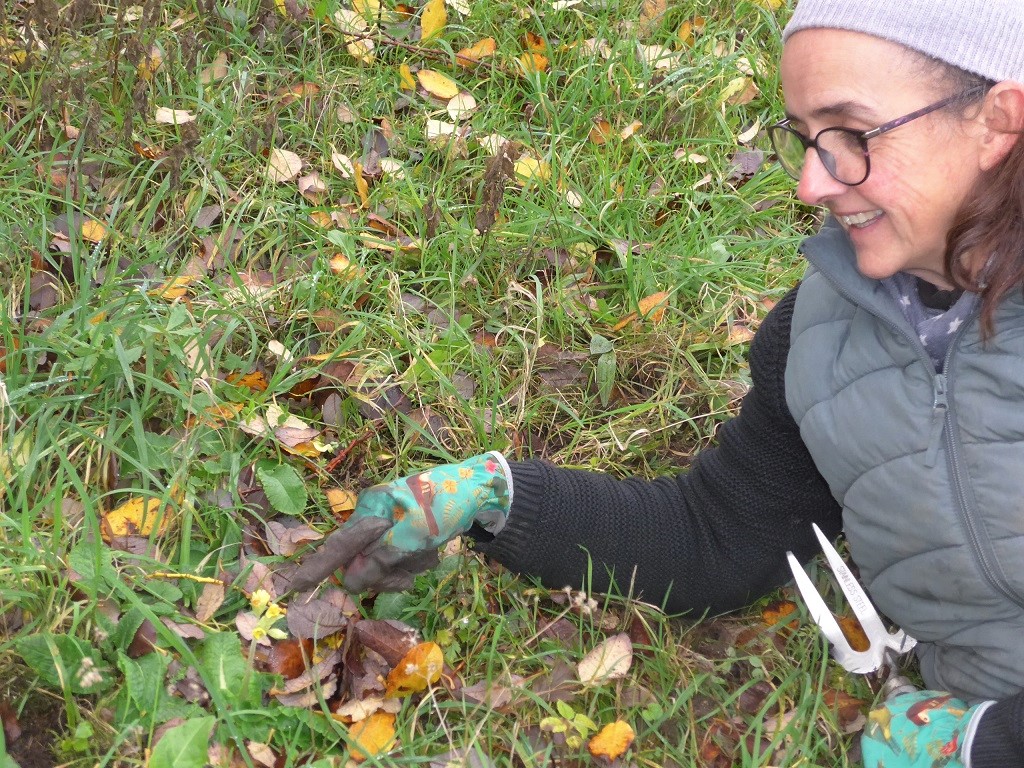
A Cowslip in flower! How weird is that for December!
Tara found this fungi on a dead stick. Her phone app confirmed our hunch that it is Candle snuff fungi.
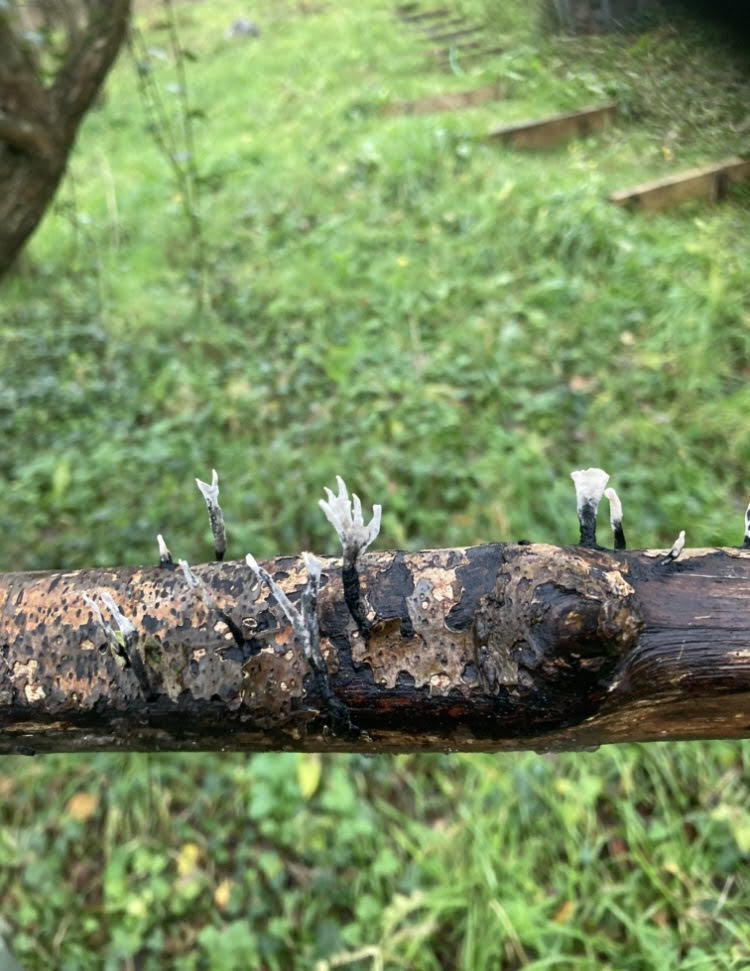
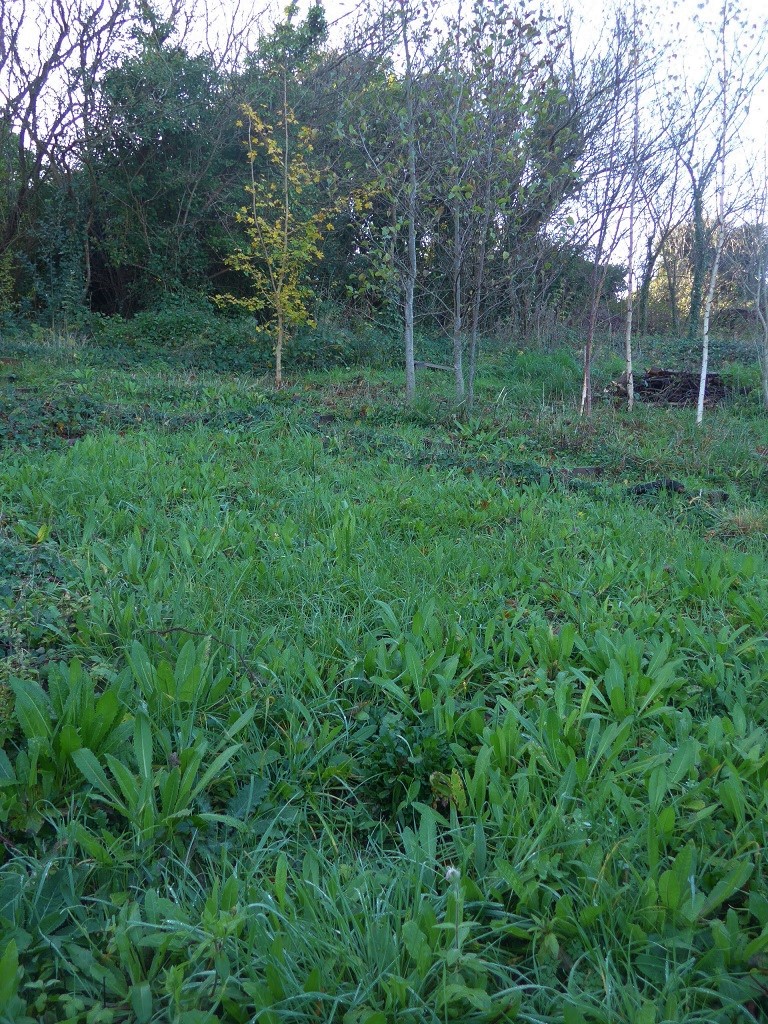 Grecia’s flower bed has grown, lots of different leaves/plants some wildflowers some different grasses, but it’s looking good and an improvement on brambles!
Grecia’s flower bed has grown, lots of different leaves/plants some wildflowers some different grasses, but it’s looking good and an improvement on brambles!
Many thanks for work done outside the sessions by people from the group. Tara- strimming & offer to put down woodchip in slippery places, Rachel and Sally for planting wildflowers (Tree Mallow and Foxgloves); Jim for offering to mend the broken step.
Photo of Bank Vole courtesy of the Woodland Trust www.woodlandtrust.org.uk
5th November 2022
Torrential rain and fierce wind – no session
Nature Notes Saturday 1st October 2022
Present: Liz, Dave and Rachel
Apologies: Simon and Tara
Notes by Dave
Just Liz and I for most of the session, then we were joined by Rachel for the last half an hour. We planted 2 trees which I’d received free as a member of the Woodland Trust. They arrived as whips a year ago so we put them in tubs and kept them on our plot to develop their roots.
Before planting the trees we had to clear a mass of bramble and ivy roots and try to make a hole with reasonable soil in our solid chalk ground. We planted a Wild Cherry just above ‘Dog Rose corner’. This replaced a Wild Cherry sucker from Whitehawk Community Orchard which failed to thrive.
Wild Cherry Crab Apple
At the side of the water shelter we planted a Crab Apple. It hadn’t developed as good a root system as we expected, but the soil is fairly deep so hopefully it will flourish. The Crab Apple above the small pond (below left) is absolutely laden with apples and looks wonderful. Just below it the 2 Guelder Rose shrubs are showing their beautiful autumn colours.
The name Guelder Rose is rather misleading. Viburnum Opulus is a native shrub and, according to my book, used to be called Water (or Swamp) Elder. These old names reflect its preference for damp locations and its elder-like berries. The ‘true’ Guelder Rose is a form which arose in Guelderland in The Netherlands some 400 years ago. It produces very large but sterile white flowers. Our Viburnum Opulus shrubs are definitely native as they have reproduced! Perhaps we should stick to the species name or go back to the name Water Elder.
 We talked about this at lunch and it led into a discussion about which trees grow near water. Liz reminded us that while Common Alders frequently grow in wet ground they don’t actually require wet conditions. Our Alder trees are proof of this, growing very happily well away from water. Alders can cope with the wet because, like the Pea family, their roots contain bacteria which can ‘fix’ nitrogen from the air to make up for the lack of nitrogen in wet soil. It seems that the same isn’t true of Willows – they need a huge volume of water and their roots are expert at seeking it out. In fact, if you plant a Weeping Willow too close to a house it will cause serious problems, getting into water systems and damaging the foundations.
We talked about this at lunch and it led into a discussion about which trees grow near water. Liz reminded us that while Common Alders frequently grow in wet ground they don’t actually require wet conditions. Our Alder trees are proof of this, growing very happily well away from water. Alders can cope with the wet because, like the Pea family, their roots contain bacteria which can ‘fix’ nitrogen from the air to make up for the lack of nitrogen in wet soil. It seems that the same isn’t true of Willows – they need a huge volume of water and their roots are expert at seeking it out. In fact, if you plant a Weeping Willow too close to a house it will cause serious problems, getting into water systems and damaging the foundations.
We cleared a sizeable patch of ground in the top bank overlooking the large pond, and Liz sowed it with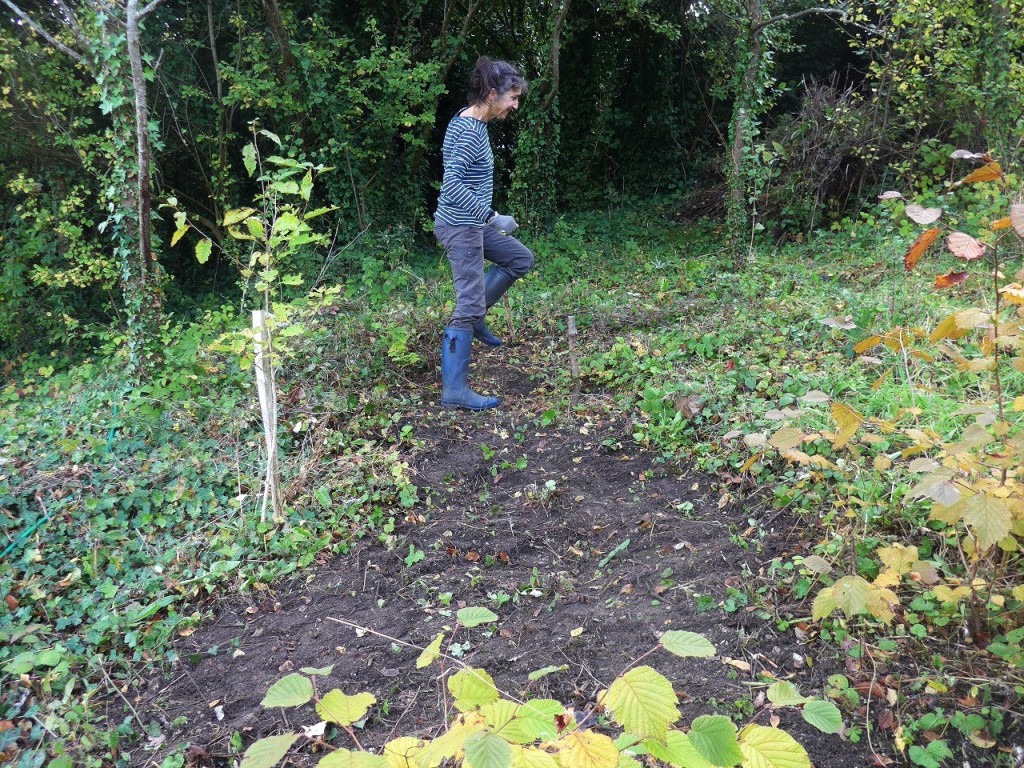 Garlic Mustard seeds which she’d collected one day in Tenantry Down Road on our way to the allotments. The species name is Alliaria petiolata but its other common names are Hedge Garlic and Jack-by-the-Hedge. Rachel is stamping down the seeds in this photo. Garlic Mustard is the food plant of caterpillars of the Orange-tip butterfly.
Garlic Mustard seeds which she’d collected one day in Tenantry Down Road on our way to the allotments. The species name is Alliaria petiolata but its other common names are Hedge Garlic and Jack-by-the-Hedge. Rachel is stamping down the seeds in this photo. Garlic Mustard is the food plant of caterpillars of the Orange-tip butterfly.
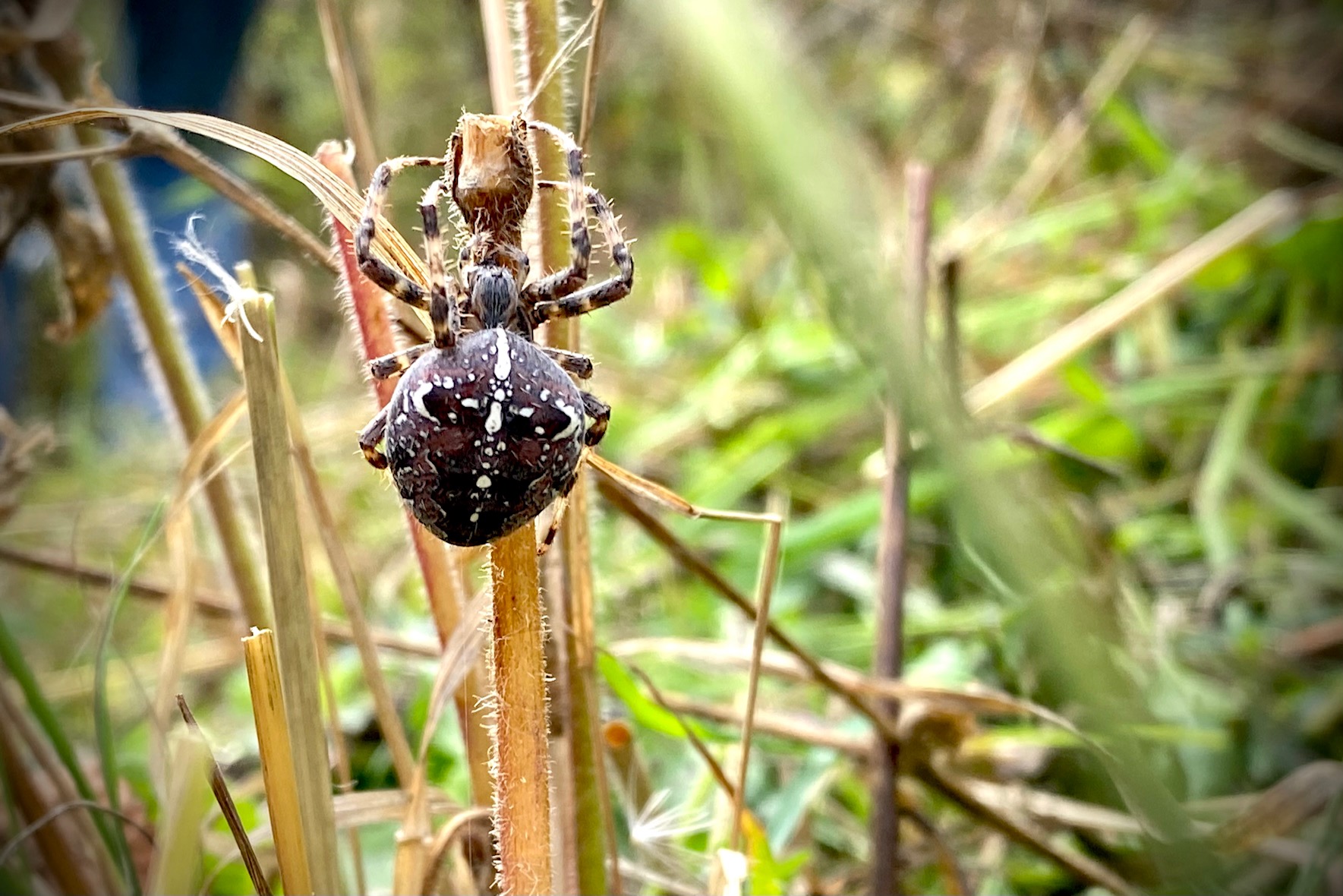 During a short break from tree planting, Liz and I watched a spider wrapping up its prey to store and eat later. Higher up in the web was another victim already in the larder! The spider was almost certainly a Garden Spider, the species described in September’s notes. Liz took this great photo of the spider completing the wrapping up.
During a short break from tree planting, Liz and I watched a spider wrapping up its prey to store and eat later. Higher up in the web was another victim already in the larder! The spider was almost certainly a Garden Spider, the species described in September’s notes. Liz took this great photo of the spider completing the wrapping up.
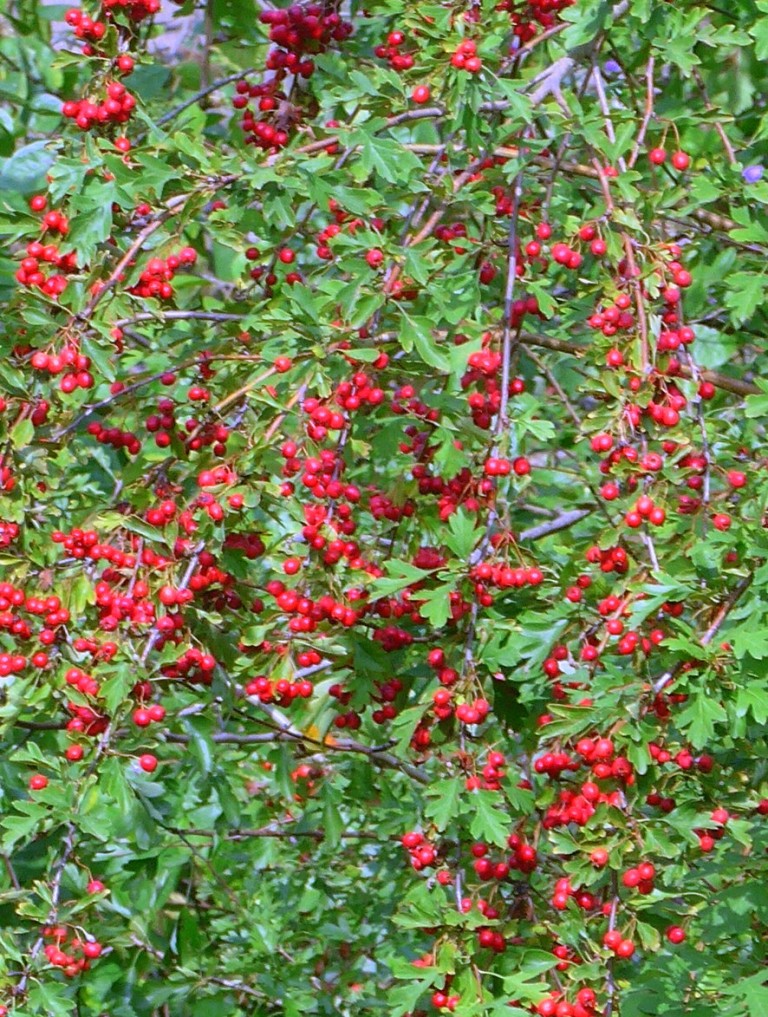 The Hawthorns on the site are still dripping with berries. At the last session Simon remarked that he couldn’t remember ever seeing so many berries on the bushes. Whilst they look wonderful, it’s unfortunately not good for wildlife. To quote from the Woodland Trust:
The Hawthorns on the site are still dripping with berries. At the last session Simon remarked that he couldn’t remember ever seeing so many berries on the bushes. Whilst they look wonderful, it’s unfortunately not good for wildlife. To quote from the Woodland Trust:
“ an unsettled climate can throw the cycles of nature off-kilter. Take fruit and nuts. Ripening now happens earlier for lots of plant species, and if it gets too hot, fruit may be smaller and drop earlier. This is a mechanism that helps plants and trees preserve water. But this can spell disaster for the wildlife that depends on them later in autumn, when animals like bank voles and blackbirds start building their energy reserves for winter.”
The article describes how heatwaves affect birds, amphibians, small mammals, and bumblebees and other insects.
“A lack of water can cause serious problems for trees and make it look as though you’re seeing a very early autumn. In dry weather, the sugars in leaves become concentrated and the leaves produce more anthocyanin (red and pink colour pigments). Consequently, the leaves turn redder or brown, and the tree may shed them to preserve the moisture in its branches and trunk.”
If you want to read more, here’s is the link
https://www.woodlandtrust.org.ukhow-heatwaves-affect-wildlife
The site will need a fair bit of maintenance at the November session. The paths have become rather treacherous. They are badly overgrown with grass and vegetation and 2 risers have collapsed. On Saturday they were still wet and I skidded down one lot of steps. The railings around the small pond have also collapsed. We didn’t have the time or energy to even start to tackle these jobs.
While we were tree planting, Liz and I discussed the problem of maintaining the site with such a small team of volunteers, especially when most of us are ageing or have physical problems. We came to the conclusion that we would probably have to abandon the westward extension which we cleared earlier in the year; it will require a lot of heavy work with the mattocks and regular maintenance to make it into a flower bank as we planned.
Nature Notes Saturday 3rd September 2022
Present: Liz, Giulia, Tina, Simon, Rossano and Dave
Apologies: Sally and Rachel
Notes by Dave
Yet another hot, very humid, day! It was hard to drink enough water to replace what we were losing as we worked. We were joined by Tina and Giulia, two friends of Simon, so there were 6 of us and we got a lot done.
Most of the work involved cutting back growth on the banks around the large pond and on the bank seeded earlier this year by Grecia and Liz. Once again we also uprooted masses of invasive Hemp Agrimony. The aim is to create diverse chalk grassland and meadows. Without any management, grassland becomes a dense mass of common grasses and thistles and eventually turns into thick scrub. The ‘best’ chalk grassland of the South Downs has a wide range of plant species. This is the result of some 5,000 years of sheep grazing and trampling the ground, aided for several hundred years by rabbits. The constant nibbling prevented any single plant becoming dominant, leading to a range of plants which in turn support a varied insect population.
This chalk grassland is considered one of the rarest and richest habitats in western Europe, with as many as 40 plant species per square metre. Research shows that the extent of chalk grassland varied over the centuries according to changes in agriculture. It largely disappeared during the second world war and the 1950s. Sadly, only around 5% of the Downs is now fine chalk grassland.
Several conservation bodies preserve and recreate chalk grassland. Sussex Wildlife Trust use grazing animals at many of their reserves, but we don’t have that option! So we are following a mowing regime which Liz drew up after a lot of research. We cut back areas of the site at different times to try and develop different habitats, and leave certain areas uncut and long for insects and animals.
 Unfortunately we disturbed some spiders today. A large female Garden Spider (Araneus diadematus) climbed over me and was very reluctant to leave. She was probably sitting in the centre of a web which we hadn’t noticed. They are common spiders across most of Britain, with a distinctive white cross on their abdomen. Females can be as big as 18mm, but males never reach more than 8mm. You often see their very intricate orb webs strung between plants or across paths. They spin the web at night then sit and wait, darting across to snatch any insects such as butterflies, flies and wasps which get caught in the web.
Unfortunately we disturbed some spiders today. A large female Garden Spider (Araneus diadematus) climbed over me and was very reluctant to leave. She was probably sitting in the centre of a web which we hadn’t noticed. They are common spiders across most of Britain, with a distinctive white cross on their abdomen. Females can be as big as 18mm, but males never reach more than 8mm. You often see their very intricate orb webs strung between plants or across paths. They spin the web at night then sit and wait, darting across to snatch any insects such as butterflies, flies and wasps which get caught in the web.
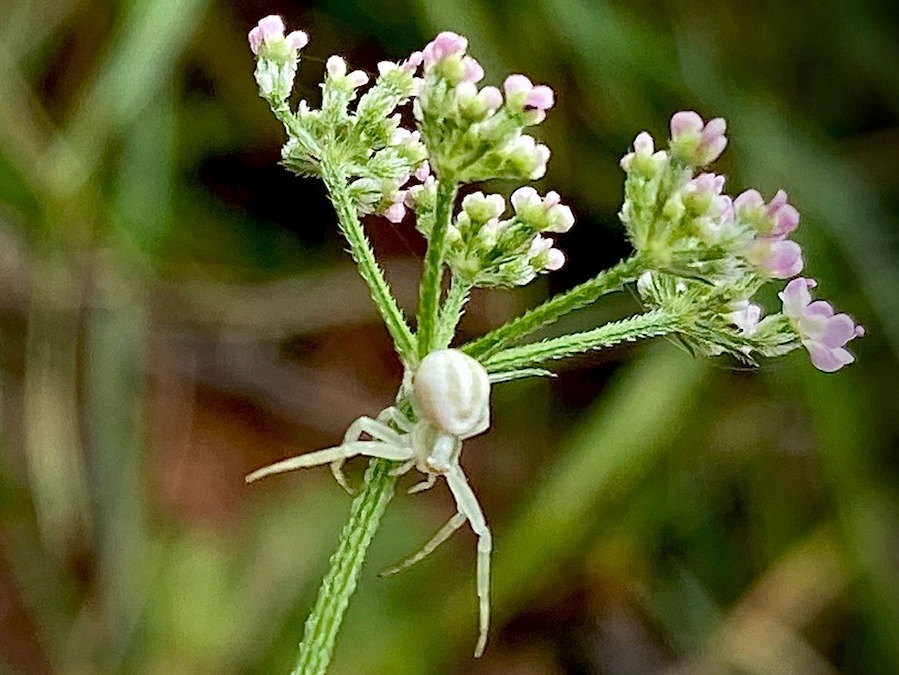 The other distinctive spider we spotted is resident only in southern England. We disturbed a nest of spiderlings of one of the Crab Spider species, Misumena vatia. These are found in tall grassland and woodland edges, as well as sometimes in gardens, but they are less common than other species of Crab Spider. Their front legs are much longer than the two back pairs, which helps to give them a crab-like appearance. Males are about 5mm and usually brown. Females are twice as big and are white, yellow or greenish. They have the ability to gradually change colour according to their surroundings. They sit camouflaged in a flower head and then ambush pollinating insects. Simon took the photos of both spiders – the camera in his phone is better than my compact camera, especially for close-up pictures.
The other distinctive spider we spotted is resident only in southern England. We disturbed a nest of spiderlings of one of the Crab Spider species, Misumena vatia. These are found in tall grassland and woodland edges, as well as sometimes in gardens, but they are less common than other species of Crab Spider. Their front legs are much longer than the two back pairs, which helps to give them a crab-like appearance. Males are about 5mm and usually brown. Females are twice as big and are white, yellow or greenish. They have the ability to gradually change colour according to their surroundings. They sit camouflaged in a flower head and then ambush pollinating insects. Simon took the photos of both spiders – the camera in his phone is better than my compact camera, especially for close-up pictures.
During the morning, several Southern Hawker dragonflies flew around and above the large pond. At one point there were eight. Unlike a fortnight ago, we didn’t spot any females.
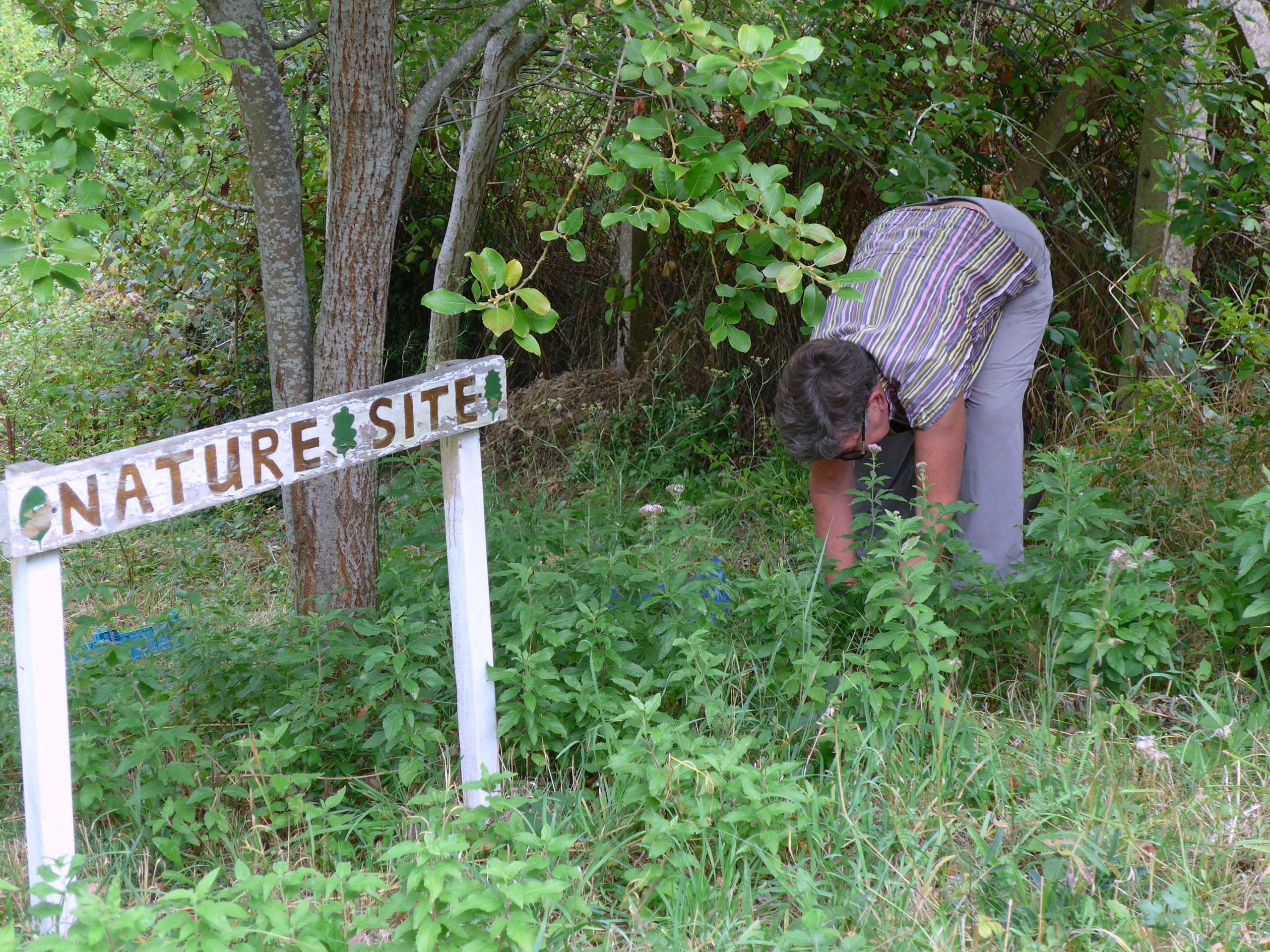 Before we went over to the Nature Site to start the session, Liz dug up a lot of wild flowers which she had grown on our allotment from collected seed. She dug out a mass of young Hemp Agrimony on the east flower bank and planted clumps of the flowers, mostly Red Campion. This was a back-breaking job! Rossano also removed a domestic pear tree from the top of the bank to allow in a bit more light.
Before we went over to the Nature Site to start the session, Liz dug up a lot of wild flowers which she had grown on our allotment from collected seed. She dug out a mass of young Hemp Agrimony on the east flower bank and planted clumps of the flowers, mostly Red Campion. This was a back-breaking job! Rossano also removed a domestic pear tree from the top of the bank to allow in a bit more light.
Nature Notes Saturday 20th August 2022
Present: Liz, Sally, Simon and Dave
Apologies: Rossano, Jim and Rachel
Notes by Dave
At last … the August session! Delayed by 2 weeks because of the Pride parade bus disruption and then by the heatwave. It was the third heatwave this year. After 3 days in June, we had 3 or 4 days in July which were classed as a national emergency. There was a record temperature of 40.3 °C (104.5 °F) although it wasn’t quite so high locally. The August heatwave was only a bit less hot and it would have been dangerous to work on the Nature site in full sun.
According to the Met Office it was the driest July on record in the south-east with only 17% of average rainfall. This was coupled with hotter than average days and nights. The site has really suffered, noticeably over the past 6 weeks since the early July session. We’ve struggled to keep the new saplings alive and stop the pond drying out.
Our efforts certainly paid off though! A Southern Hawker dragonfly laid her eggs in the large pond. Twice during the morning we’d seen 4 males flying fairly high over the pond and surrounding area, but no sign of a female. Then just after lunch Liz spotted the female ovipositing. She managed to get some great photos.
According to my book, copulation occurs well away from water, often high up in trees. We watched as the female landed on a log in the water and gradually manoeuvred herself into position to lay her eggs in the wood and the vegetation on top. Her eggs will remain dormant over the winter. The larvae hatch in early spring and live in the pond, feeding on small invertebrates such as beetles and water snails. After 1-3 years they emerge as adults in early spring. We shall be keeping a close eye on the pond next year in the hope of spotting the larvae hunting for food.
The Southern Hawkers are very beautiful dragonflies. They are large, around 7cm long, and are fast fliers, capable of flying backwards. The males have the habit of coming up close and hovering in front of you while they investigate you. The photos below are courtesy of the British Dragonfly Society. The female is on the left. https://british-dragonflies.org.uk/species/southern-hawker/
Liz wrote in the last notes about trees shading the top two flower banks. This has affected the flower species, losing the Kidney Vetch and with it the Small Blue butterflies breeding there. So we decided to take out 3 fairly young trees on the west bank – 2 Plums/Bullaces and a Goat Willow – to keep it sunny. We wouldn’t dream of touching the 2 mature Goat Willows and a younger one on the east bank. We have male and female trees and they provide a mass of nectar and pollen for bees and other pollinators in very early spring. We’ll simply accept that the habitat will change as the trees spread.
A very encouraging sign was a small show of flowers in late July on the new patch to the west of the site. We cleared it of brambles earlier this year and sowed some annual seeds. It all looked pretty ‘weedy’ and unimpressive on Saturday as flowering has now finished, but hopefully seeds will set and come up again next year.
It was a busy session. We just put our heads down and got on with it with little talking, although we made up for it with a good chat at lunchtime. It was a hot and humid day and it was hard work. So what did we do?
- pulled out masses of Hemp Agrimony from the east flower bank and below the small pond before it had chance to spread its seeds
- repaired a disintegrated step just below the car park
- cut back sections of the east and west flower banks
- cleared Hemp Agrimony from the tree section around the yellow water butt.
- planted out loads of young Viper’s Bugloss plants which Liz dug up from our allotment
- trimmed the chopped down trees to save stakes, pegs for steps, etc.
The Hemp Agrimony would dominate the site if we left it alone. We think it’s a menace but lots of insects love it! A Rose Chafer spent ages feeding on one its flowers. The sun caught it at different angles as it moved round. It seemed to change colour, appearing a shimmering golden at times. Unfortunately my photos didn’t capture it.
Nature Notes Sat 2nd July 2022
Who came: Simon, Liz, Rossano, Rachel
Who couldn’t come: Sally & Jim are on holiday, Dave is still testing positive with Covid.
Notes by: Liz Photos: Simon.
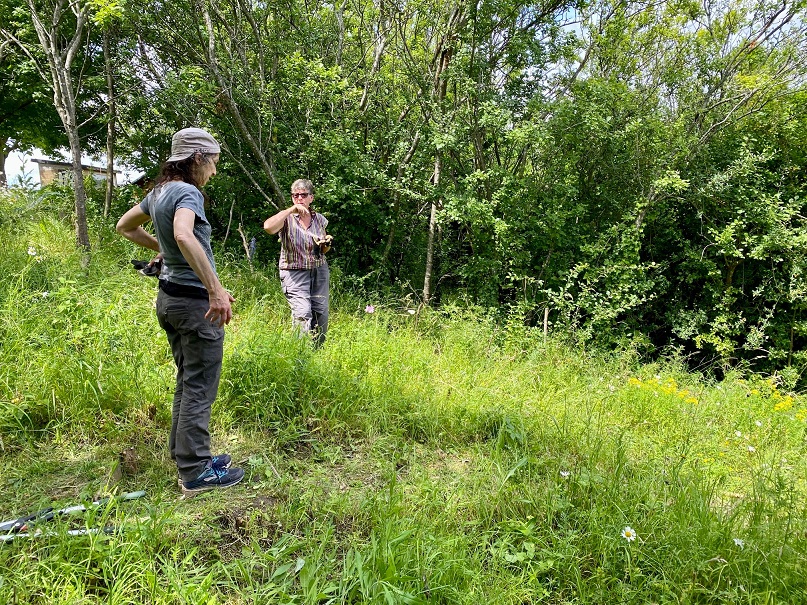 It is the Allotment Site Open Day and Summer show today. We had invited all our friends and supporters who don’t have an allotment plot, to visit as the gate would be open all afternoon to the public.
It is the Allotment Site Open Day and Summer show today. We had invited all our friends and supporters who don’t have an allotment plot, to visit as the gate would be open all afternoon to the public.
The main task was making all the paths passible. The grass hadn’t grown too much since the June session so this wasn’t too arduous, & Simon, Rossano & I whipped round the site fairly quickly. Rossano left and Rachel arrived late morning, and we had a really good blitz on pulling up the Hemp agrimony before it flowered and set seed. We entirely cleared it all from the western flower bank and Rachel pulled a lot from the lower part of the eastern bank.
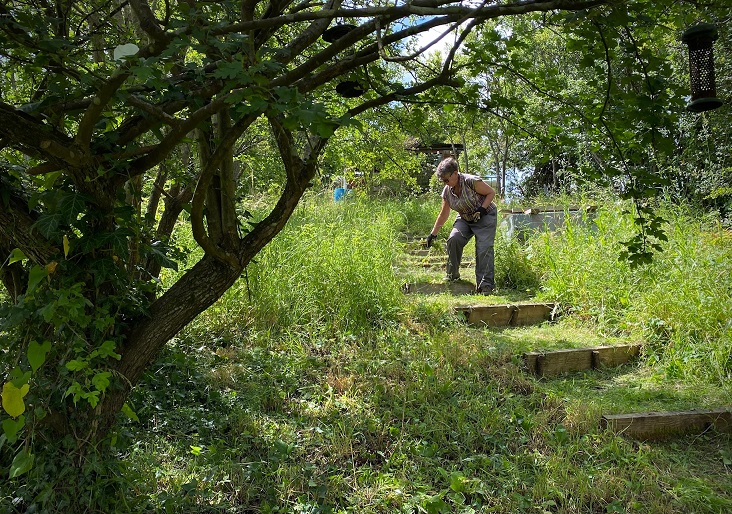 We were able to discuss changes in the site over the years: the top two flower banks are definitely much more shaded than when we first started the site in 2015. The Goat willow trees have grown upwards, and thickened. This would account for the almost total lack of Kidney vetch in the top western bank and consequently no Small Blue butterflies! Simon did see two Small blue’s however in a sunny patch above the Dog rose, & I saw another later on in the newly cleared area (we need to give this a name). We have probably lost our breeding colony, but they are around so we can try to establish this new area for them by sowing more Kidney vetch and Birds foot trefoil. Alternatively we could remove the Willows on the West bank to provide more sun.
We were able to discuss changes in the site over the years: the top two flower banks are definitely much more shaded than when we first started the site in 2015. The Goat willow trees have grown upwards, and thickened. This would account for the almost total lack of Kidney vetch in the top western bank and consequently no Small Blue butterflies! Simon did see two Small blue’s however in a sunny patch above the Dog rose, & I saw another later on in the newly cleared area (we need to give this a name). We have probably lost our breeding colony, but they are around so we can try to establish this new area for them by sowing more Kidney vetch and Birds foot trefoil. Alternatively we could remove the Willows on the West bank to provide more sun.
The management of the lower half of the west bank did work this year. We cut it down to 4inches in May to encourage Yellow rattle. We had a really good spread of yellow rattle flowers in June which is now setting seed, and hopefully will spread.
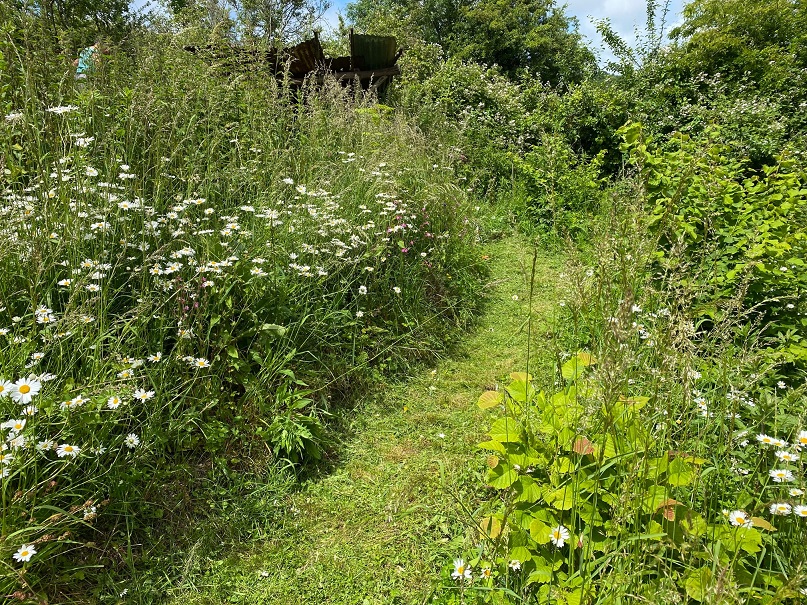 The bank below the large pond looked very good, with lots of flowers, Hedge & Ladies bedstraws, St John’s wort, Field scabious. It had lots of Bladder campion throughout June but this has now set seed. We found a plant new to the site, a Black horehound (looks like a large tough Red deadnettle). Actually we found two new plants, the yellow ‘mustard-type’ plant in the new cleared area Rachel identified as ‘Charlock’ a native of disturbed arable land- which makes sense.
The bank below the large pond looked very good, with lots of flowers, Hedge & Ladies bedstraws, St John’s wort, Field scabious. It had lots of Bladder campion throughout June but this has now set seed. We found a plant new to the site, a Black horehound (looks like a large tough Red deadnettle). Actually we found two new plants, the yellow ‘mustard-type’ plant in the new cleared area Rachel identified as ‘Charlock’ a native of disturbed arable land- which makes sense.
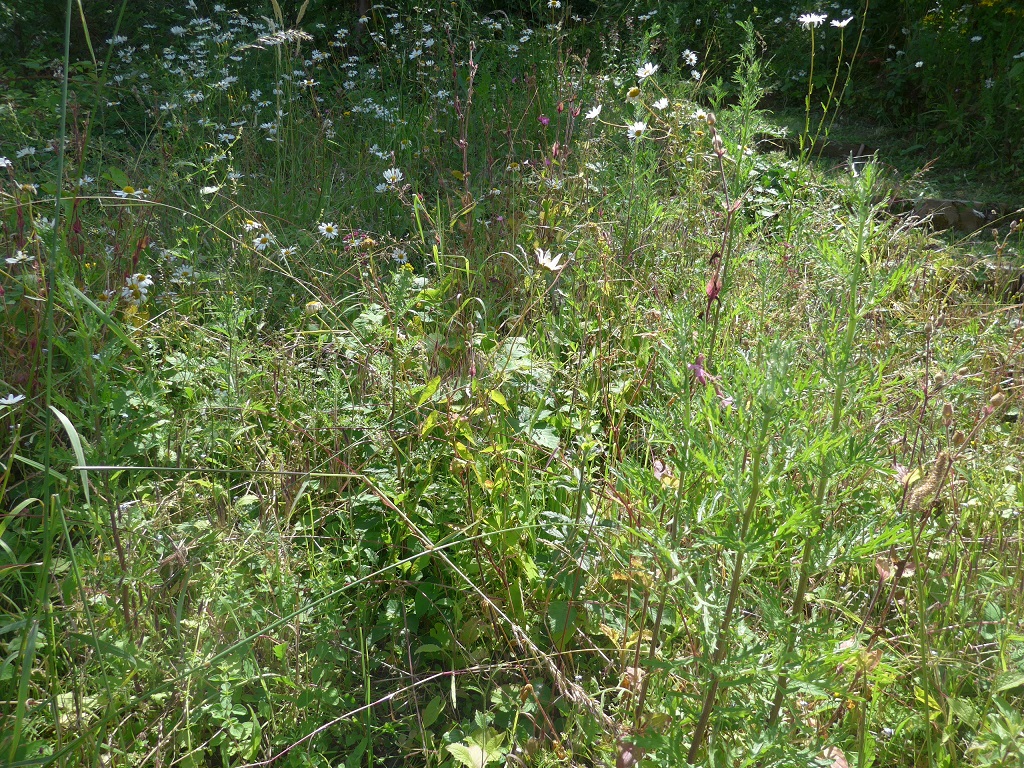 The newly sown patch close to the large pond also looked good for it’s first year. I’m going to name it ‘Grecia’s flower bank’ as she provided the seeds. It is studded with Oxeye daisy, Marjoram, and Red Campion that we transplanted from elsewhere, but the seeds are also coming through. I identified Melilot, Curled dock and Corn marigold among them.
The newly sown patch close to the large pond also looked good for it’s first year. I’m going to name it ‘Grecia’s flower bank’ as she provided the seeds. It is studded with Oxeye daisy, Marjoram, and Red Campion that we transplanted from elsewhere, but the seeds are also coming through. I identified Melilot, Curled dock and Corn marigold among them.
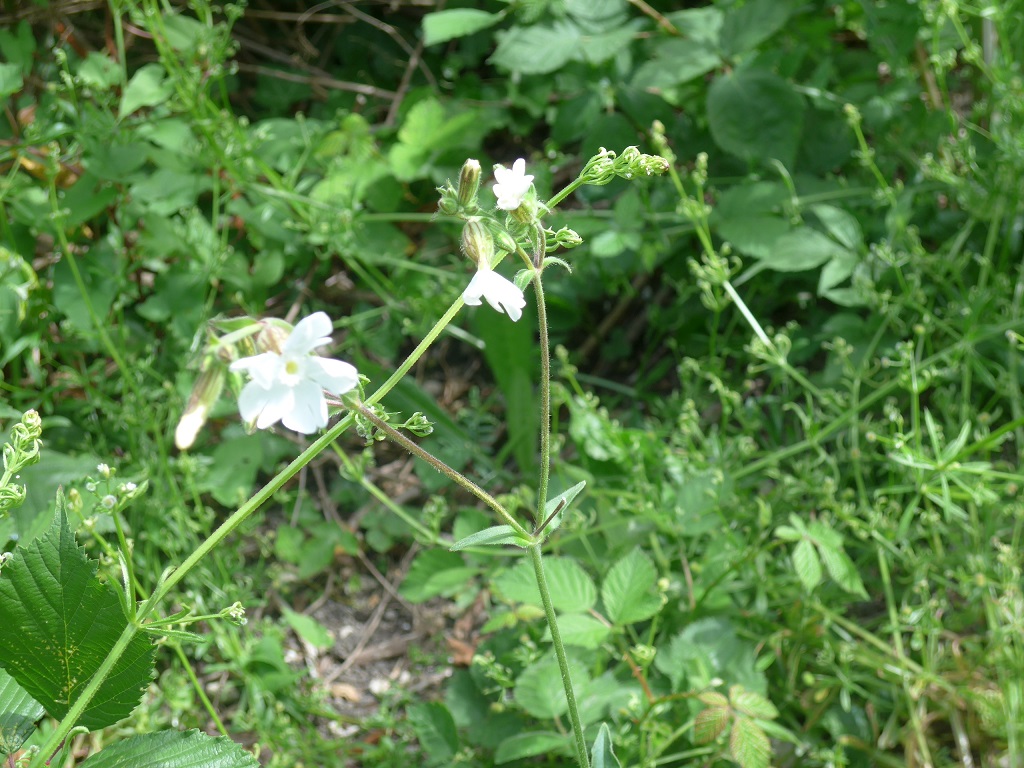 The most westerly new area- I’m going to name it ‘Rossano’ patch as he did a load of the heavy work clearing it- doesn’t look particularly beautiful to the eye. Bind weed, Goosegrass, and common ‘weeds’ such as fumitory predominate. But searching closely I found Chamomile, Cornflower, & White Campion, all are new to the site, plus some Vipers bugloss that I planted. It also has loads of ‘Charlock’ whether this was in the seeds we sowed I don’t know. It should look more colourful over July and August, but we can collect more seed or plants for an autumn sowing. It gets loads of sun so could be a really good ‘butterfly bank’.
The most westerly new area- I’m going to name it ‘Rossano’ patch as he did a load of the heavy work clearing it- doesn’t look particularly beautiful to the eye. Bind weed, Goosegrass, and common ‘weeds’ such as fumitory predominate. But searching closely I found Chamomile, Cornflower, & White Campion, all are new to the site, plus some Vipers bugloss that I planted. It also has loads of ‘Charlock’ whether this was in the seeds we sowed I don’t know. It should look more colourful over July and August, but we can collect more seed or plants for an autumn sowing. It gets loads of sun so could be a really good ‘butterfly bank’.
What did we see:
Well, all the plants named above, plus some beautify blue Vipers bugloss plants in flower; & a lovely pink Musk mallow.
We saw around 10 Cinnabar moths (bright scarlet, their caterpillars are the stripey orange and black ones we see on Ragwort, photo below left), around 5 Scarlet Tiger moths (bright scarlet underwing and black spotted with cream outer wings), 100’s of Meadow Brown and Ringlet butterflies, and a few Small White, and Comma butterflies. I saw a Holly Blue butterfly and Simon saw two Small Blue butterflies. There were of course the usual range of insects and bees, but we all felt these where much fewer in number than in previous years. (Rose Chafer, bottom right)
The plant count for the site is now 197 (max so far is 209 last year). There will certainly be more as 10-20 species are yet to flower – they are difficult to identify until they flower.
Open Day visitors: Just as we were about to leave, thinking no-one was going to visit, two groups arrived. Later another group came to look. In all 7 people, half who had an allotment on the site.
Nature Notes Sat 11th June 2022
Who came: Simon, Grecia, Liz, Sally, Jim, Dave
Who couldn’t come: Tara, Rachel
Notes by: Liz Photos: Heather.
We were a week late with the session, last Saturday was cancelled as it had been raining all Friday night and everything would have been too wet.
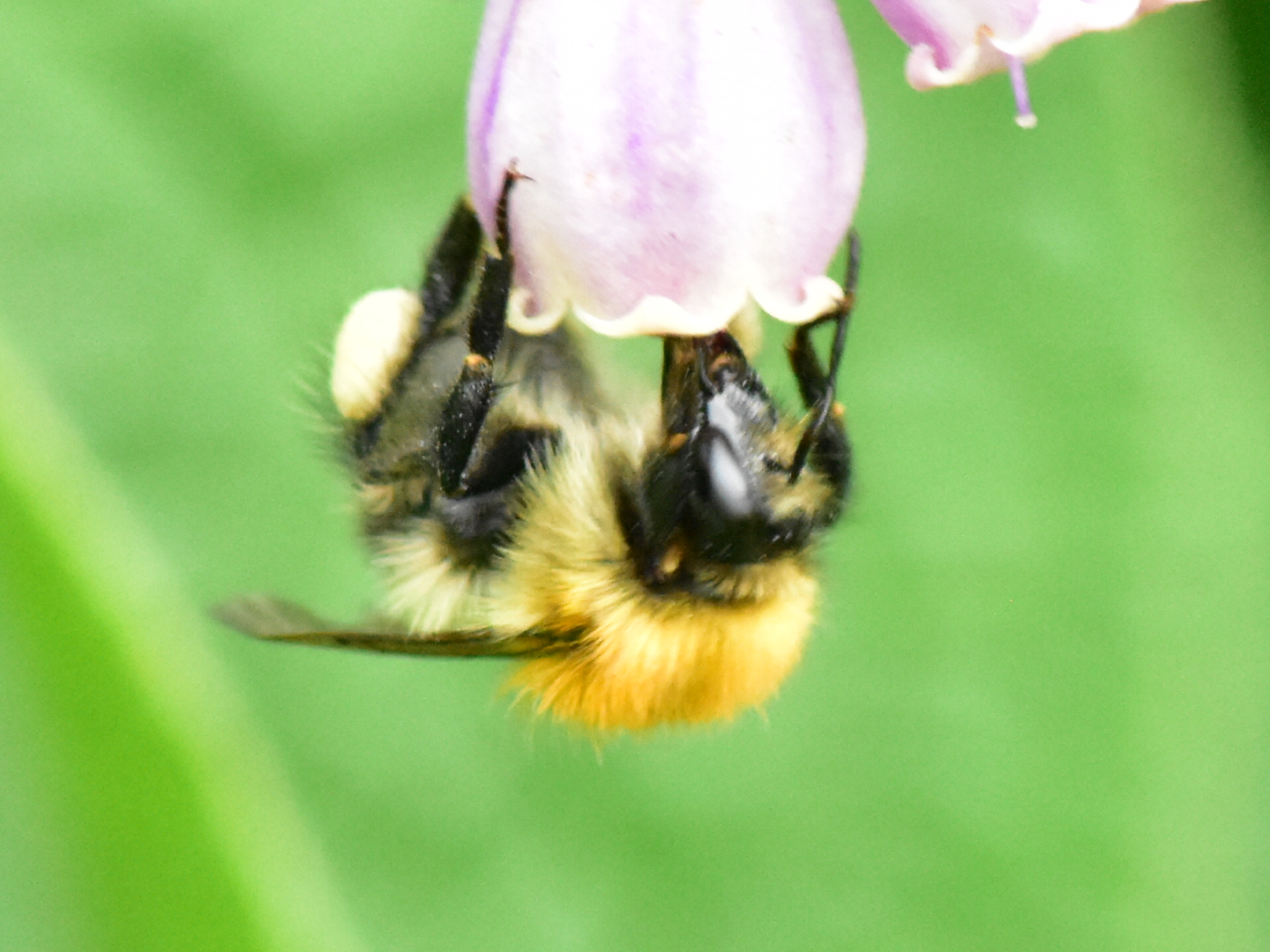 Due to frequent rain for the last few weeks, everything had grown enormously, especially grass on the paths. So cutting the paths & overhanging brambles was our main task. We also cut back the small top section of the flower bank. This easterly section, around the Nature Site sign, we are managing as ‘flowery lawn’, ie frequent cutting & raking with the aim of getting lots of Horseshoe & Kidney vetch and Birdsfoot Trefoil flowers for butterflies and other insects. We left the patches of Scabious which grow tall and are close to flowering.
Due to frequent rain for the last few weeks, everything had grown enormously, especially grass on the paths. So cutting the paths & overhanging brambles was our main task. We also cut back the small top section of the flower bank. This easterly section, around the Nature Site sign, we are managing as ‘flowery lawn’, ie frequent cutting & raking with the aim of getting lots of Horseshoe & Kidney vetch and Birdsfoot Trefoil flowers for butterflies and other insects. We left the patches of Scabious which grow tall and are close to flowering.
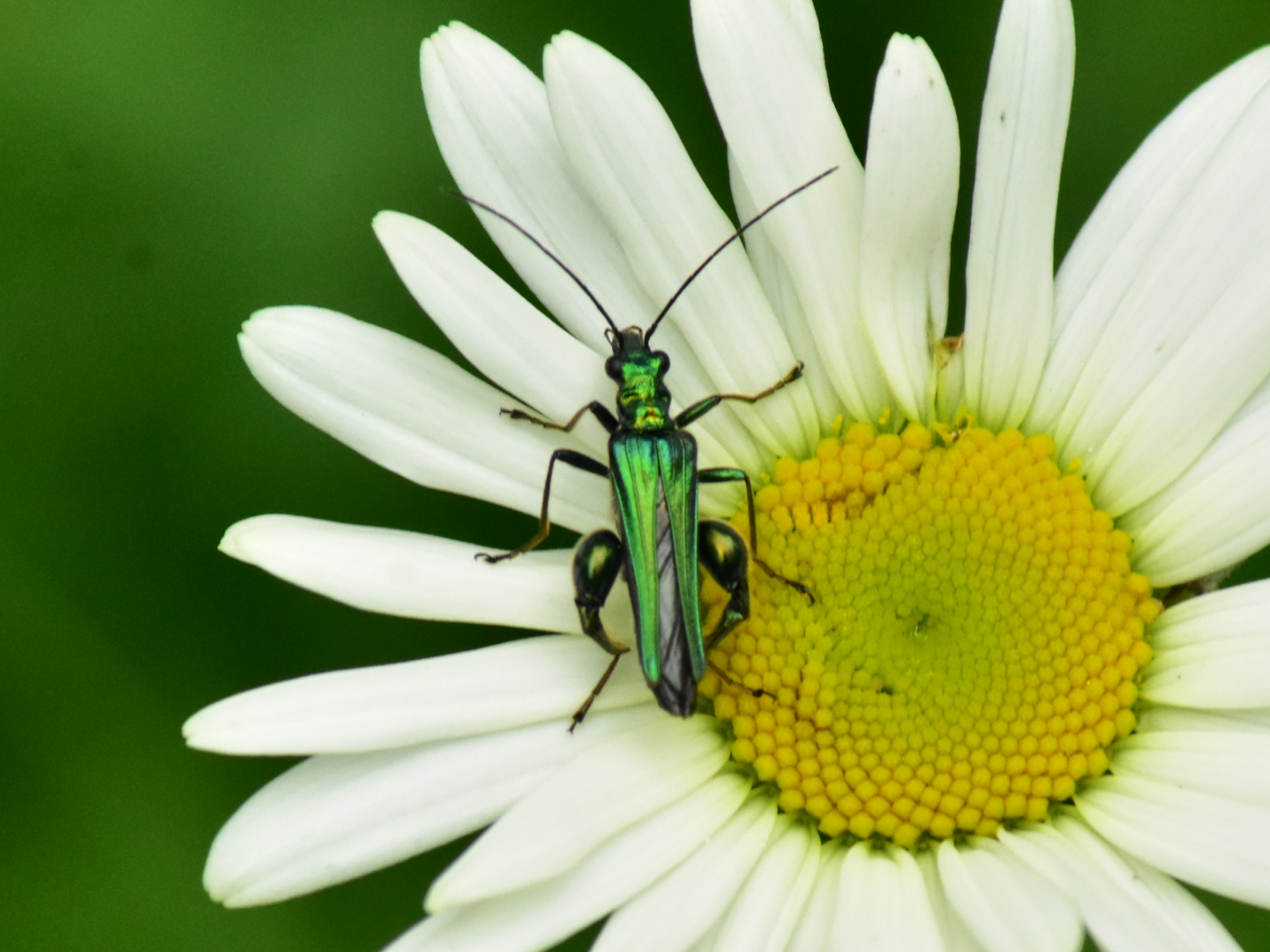 The Site generally was full of Oxeye Daisy flowers which seemed to be a favourite with Swollen Thighed Beetles (picture right), Solitary bees and thrips. Red Campions and Bladder Campions (white) were also fairy prolific esp in the large pond area. (Top picture: Common Carder bee in Comfrey flower)
The Site generally was full of Oxeye Daisy flowers which seemed to be a favourite with Swollen Thighed Beetles (picture right), Solitary bees and thrips. Red Campions and Bladder Campions (white) were also fairy prolific esp in the large pond area. (Top picture: Common Carder bee in Comfrey flower)
The newly sown flower bank next to steps past the large pond, (sown by Grecia & Liz a couple of months ago) was looking good. The Red Campion, Oxeye Daisy and Marjoram plants were all thriving, some flowering, and the sown seed were coming up, though still unrecognisable.
The newly opened up patch west of large pond (amongst the brambles) didn’t look great, the seeds we sowed weren’t apparent at all, but many brambles were shotting up where roots remained in the soil. It’s early days however, seed may still germinate, and if not, we can have another go at clearing bramble and other major roots from the soil, then sow with seed in autumn, which may get better results.
Over lunch we discussed our perceptions of the changes over the years of the types of flowers, and we felt many species that were flowering in profusion a few years ago, weren’t so evident any more with Oxeye Daisy very much predominating. The Kidney Vetch on the top West flower bank was conspicuously absent this year, as were the small blue butterflies which depend on it to lay eggs. Reasons for these changes could be:
- Our previous management regime of mowing only twice pa (March and Oct) has allowed grasses to predominate and crowd out other species.
- The soil is still too rich, causing lush grass growth at the expense of other species (animal grazing would constantly remove nutrients from the soil by eating it! We can’t do this).
- Trees have all grown over the last few years, creating a more shady site more suited to different plants (and creatures)
- Oxeye Daisy may be a ‘thug’ knocking out other species!
I think maybe all of these things may be true, though the ‘thuggishness’ of Oxeye Daisy may be false. Having read Isabella Tree’s book ‘Wilding’ about re wilding Knepp estate, she describes changes over 15 years of the plant species in one meadow, starting with predominantly thistles, moving to Oxeye Daisy then finally to more mixed, small and long lived plants. The Nature Site is in its 8th summer, so halfway through it’s transition, and possibly evolving into a totally different habitat to the one we envisioned when starting. We have been sowing and planting many sun-loving ‘Downland’ species on the two top flower banks, but maybe it is evolving into ‘open woodland’ with ‘glades’ and the species adjusting accordingly.
Having said this, the Site did look very beautiful. The pond was especially good, lots of flowers on the Water Lily, Bistort and Bog Bean plants multiplying very well. Other pond plants were flowering, Skullcap (tiny purple flowers), Brooklime (tiny blue flowers), a few yellow Lessor Spearwort flowers.
Our management (severely clearing out 3/4 of the Water Dropwort last winter) seems very successful, with a good balance of different plants pus more open water. We watched many Blue and Red Damselflies mating and laying in the pond while we eat lunch, a Broad Bodies chaser dragonfly flew round the pond but found no mate so left.
Heather had photographed these wonderful beasts above emerging from the pond the week before. Left: Dragonfly nymph before its transformation from pond bottom dweller to magnificent flying creature! (possibly Broad Bodied Chaser). Right: Damselfly nymph.
What did we see: Species I added to this year’s inventories were: Hedge Bindweed, Red & White Clovers, Corncockle, Curled Dock, Enchanters Nightshade, Soft Meadow grass, Common Fumitory, Cocksfoot, & Yorkshire Fog grasses, Ground Ivy, groundsel, Orange Hawkweed, Bristly Oxtongue. Upright Hedge Parsley, Common Poppy, Scarlet Pimpernel, Skullcap, Common Sorrel, Spear Thistle, Toadflax, Rosebay Willowherb, Horseshoe vetch, some Kidney Vetch, Common (purple) Vetch, and lots and lots of Yellow Rattle (this is parasitic on grass so very helpful in managing wildflower meadows). We saw a lot of insects, especially bee species, also a magnificent Rose Chafer a Small Tortoiseshell butterfly & a frog!
Three photos above, taken by Heather on the Nature Site last week- what are they? Can anyone identify them? Please let me know if you can.
Nature Notes Sat 7th May 2022
Who came: Simon, Rossano, Liz, Rachel
Who couldn’t come: Tara, Sally, Dave (housebound due to minor leg surgery)
Notes by: Liz Photos: Simon
 Everything has grown enormously in the last few weeks, and the paths, while not having quite disappeared, were also badly in need of cutting. Hawthorn blossom was weighting down the trees there was so much, with its lovely heady perfume, and the birdsong was glorious.
Everything has grown enormously in the last few weeks, and the paths, while not having quite disappeared, were also badly in need of cutting. Hawthorn blossom was weighting down the trees there was so much, with its lovely heady perfume, and the birdsong was glorious.
Lots to do with very few of us – crikey! We had 2 large packets of annual plus some perennial wildflower seeds to sow on the newly cleared section. Simon & Rossana quickly mattocked out some bramble that had re-appeared, then raked 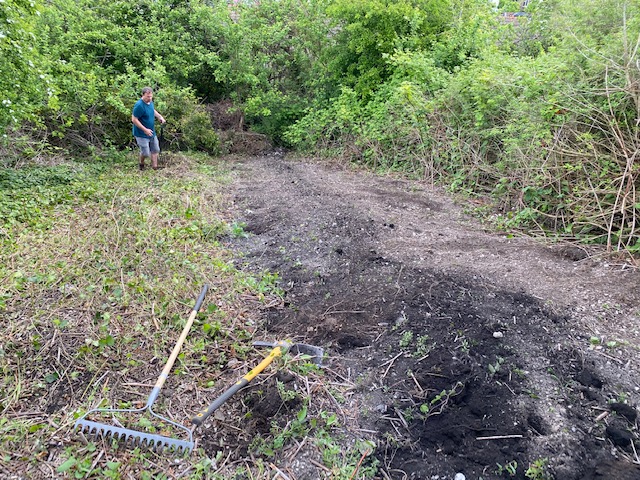 it before sowing seeds. Rossano did an amazing job clearing the dense ivy from the remaining section and mattocking out huge bramble roots from the path to the new section. With luck we should get flowers such as cornflowers, corncockles, corn marigolds this summer, though there will undoubtedly be many more brambles coming through which we can deal with next winter.
it before sowing seeds. Rossano did an amazing job clearing the dense ivy from the remaining section and mattocking out huge bramble roots from the path to the new section. With luck we should get flowers such as cornflowers, corncockles, corn marigolds this summer, though there will undoubtedly be many more brambles coming through which we can deal with next winter.
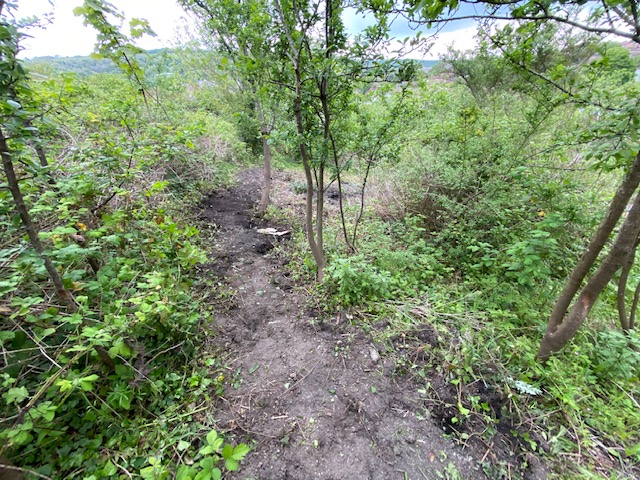 I planted a few Vipers Bugloss plants (self-seeded on our allotment) on the new area previously sown with wildflowers by Grecia. The seeds are sprouting but too small yet to see what exactly is coming up but it should look good this summer.
I planted a few Vipers Bugloss plants (self-seeded on our allotment) on the new area previously sown with wildflowers by Grecia. The seeds are sprouting but too small yet to see what exactly is coming up but it should look good this summer.
Several areas of flower bank were on our ‘mowing chart’ as needing to be cut back as well as making the paths safe and visible. Simon  mended a collapsing step in record time (I’ll swear it took him about 30 seconds!) Rachel arrived just before lunch so after lunch Simon, Rachel & I managed to cut and rake the wildflower banks, and cleared most of the paths so that at least the steps were visible and visitors wouldn’t trip on them.
mended a collapsing step in record time (I’ll swear it took him about 30 seconds!) Rachel arrived just before lunch so after lunch Simon, Rachel & I managed to cut and rake the wildflower banks, and cleared most of the paths so that at least the steps were visible and visitors wouldn’t trip on them.
Simon whipped round with watering can giving the newly planted tree saplings a drink (I don’t think it’s rained properly in about 2 months.
What did we see: The thing about cutting ‘grass’ with your nose 18inches from the ground is you spot an awful lot of plant species. I made a list of around 40 plant species, most of which I hadn’t already added to this year’s plant list as they have only just become visible, incl. Sainfoin (not seen last year).
Left to right, above: Germander speedwell on steps, Brooklime (blue) & Marsh Marigold and Bogbean
I was pleased to see we hadn’t inadvertently ‘weeded’ some of the pond plants them out when we cleared it in December. Bog bean, Bistort, Brooklime & Marsh marigolds looked fantastic. We watched 4 newts in the pond, at the shallow ‘newt end’, while Simon counted 3 or 4 frogs of different sizes in the deep ’frog end’. We intervened in nature by rescuing a trapped Red Damselfly.
The Blackthorns planted by Dave & Tara the winter before last, and at the edge of the small pond are doing really well, thickening out and with leaves. At the March session Rossano replaced clumps of grass behind them at the edge of the damson copse. This has worked really well forming a dense long wall of grass tussocks that will support Skippers and other butterfly caterpillars until they ‘hatch’ in June or July. Hopefully it will also suppress the Hemp Agrimony that was invading the spaces between the damson trees.
Dave managed to visit the Nature Site the following day, and we saw an Orange Tip butterfly, not seen on the site since 2020. It prefers Garlic mustard to ay its eggs on, which this year we have quite a bit growing in the thinned section of the woods above the large pond. In April we also saw a couple of Brimstone butterflies. Both these species prefer dappled light with lots of long vegetation. Looking around the nature Site we realised that we really have managed to created quite a range of habitats now. Sunny open flowering patches, dappled shade, dense shade, water/ ponds and woodpiles specifically for invertebrates. The addition of a mowing regime so that wildflower banks are cut at different times will provide different lengths, densities and flowering times of grass/ flowers. This will provide a rolling sequence of undisturbed patches for Butterfly/ Moth caterpillars and other invertebrates to eat all through the spring and summer months. As butterflies all have different breeding times, this should provide a range of habitats for everyone!
We also saw our first Cinnabar moth of the year with it’s bright scarlet wings. It needs ragwort to lay eggs on.

Nature Notes Friday 15th April 2022
Notes by Dave
A perfect Spring day! Warm sun and a fresh southerly breeze. And the Nature site looked and sounded wonderful. Liz and I watched solitary bees diving into flowers and emerging with pollen-yellow legs, followed the flashing flight of butterflies across the site, and caught glimpses of life in the ponds. Some flowers were blooming, others just making their presence known.
I mustn’t get too romantic, though. It was not like the 1950’s or 60’s, but given today’s badly depleted state of nature our visit was a real joy and we spent the whole morning there – our allotment plots could wait!
So what did we see and hear? The ‘usual suspects’ of course – Robins, Great Tits, Blackbirds, Peacock and Large White butterflies, Primulas and many more – but lots of ‘firsts’ this year as well as species coming into their own after a slow start.
Wildflowers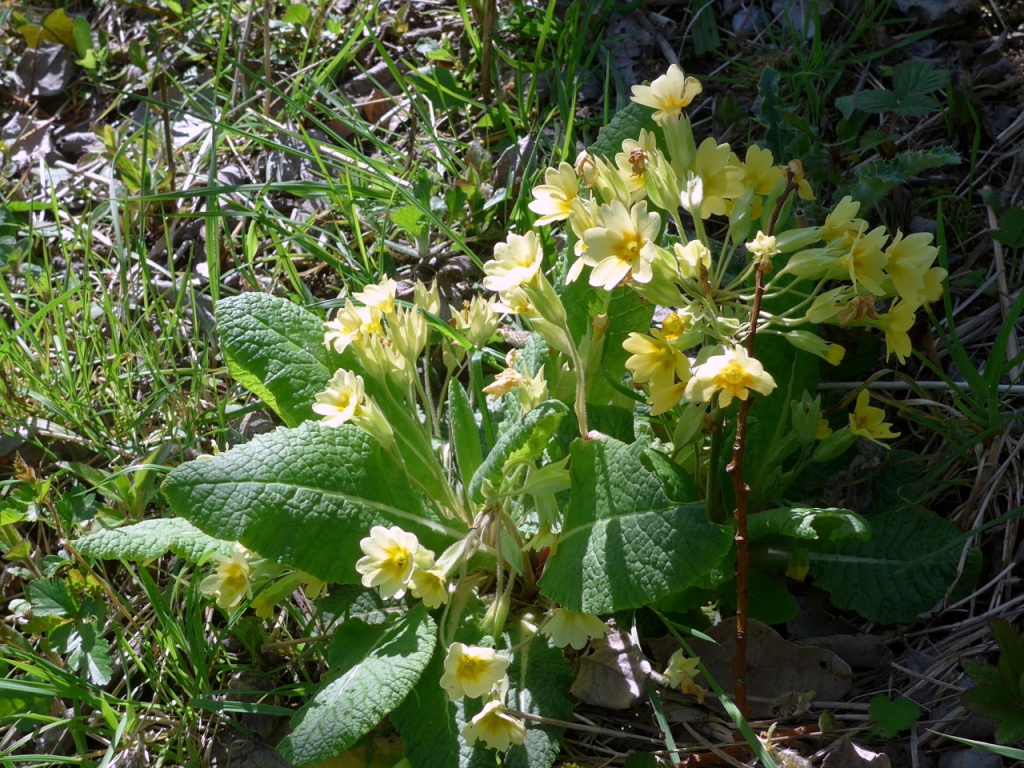 Cowslips have proliferated and False Oxlips are in flower like this beautiful clump pictured right. Dropwort (Filipendula vulgaris), Field Scabious, Bugle, Alchemilla, and Yarrow are just emerging.
Cowslips have proliferated and False Oxlips are in flower like this beautiful clump pictured right. Dropwort (Filipendula vulgaris), Field Scabious, Bugle, Alchemilla, and Yarrow are just emerging.
Cuckoo Flower aka Lady’s-smock (Cardamine pratensis) has just come into flower below the small pond and Common Dog-violets (Viola Riviniana) are also just in show.
We also saw Green Alkanet, Lesser Celandine (Ficaria verna), , Lords-and-Ladies aka Cuckoo Pint although its distinctive spike of red fruits comes much later, Herb Robert, Garlic Mustard, Alexanders and Wild Sweet Peas.
Above, left to right: Lady’s-smock, Common Dog-violet, and Garlic Mustard.
Clockwise above: Lords-and-Ladies, Alexanders, Lesser Celandine and some wonderful fungi on a dead branch.
The ponds
Full of life! A frog dived for cover in the small pond and took refuge under the Water Mint. In the large pond we spotted at least 4 newts swimming round the deepest part of the pond. It confirms our suspicion that the tadpoles have been eaten. It was hard to see the newts clearly but I was only sure of seeing females, although it seems likely that there were 2 of each sex. I think they are Smooth Newts aka Common Newts but it is difficult to distinguish them from Palmate Newts without seeing their underside. Male and female Common Newts have spots on their underside and throats.
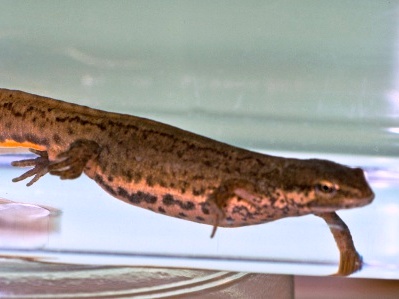 Both species are widespread and often turn up in small ponds. My book says they also breed in temporary pools in open woodland but avoid larger lakes where they suffer predation from fish. I would have needed a more sophisticated camera to take photos, so this one of a female Common Newt is courtesy of Nature Spot. Both species spend a lot of the year on land.
Both species are widespread and often turn up in small ponds. My book says they also breed in temporary pools in open woodland but avoid larger lakes where they suffer predation from fish. I would have needed a more sophisticated camera to take photos, so this one of a female Common Newt is courtesy of Nature Spot. Both species spend a lot of the year on land.
Smooth Newts are about 4 inches long (11cm) and are a bit bigger than Palmate Newts. The largest British newt is the Great Crested Newt which is over 6 inches long (15cm) but sadly these are in decline. The male is very striking during the breeding season, with a large jagged crest running along its back.
The Brooklime planted a fortnight ago has settled in nicely at the edge of the pond and Dwarf Sweet Flag (Acorus gramineus) is growing up.
Birds
A Blackbird’s nest had been raided by a predator. The most likely culprit is a Magpie as we see lots on the site, although all the Corvids will eat eggs and chicks. One of the eggshells still had some yolk inside.
We spotted Long-tailed Tits and a male and female Blackcap. We’d heard the Blackcap song and a bit later the male appeared in the hedge next to Bevendean Down Nature Reserve. He then flew into the Wayfaring tree where he began to sing again. We also heard Chiffchaffs ‘chip-chapping’ away and the beautiful song of a Garden Warbler.
We’ve taken to calling this warbler the ‘garden gabbler’ because of its fast flowing song. It’s most unfair on the poor bird as the song is varied and musical, but we’ve got such poor memories that it’s the only way we can remember whether the song comes from a Garden or Willow Warbler. I can also confuse the songs of the Garden Warbler and the Blackcap!
It used to be thought that in Britain only male birds sing. It doesn’t help that male and females are almost identical in species such as Robins and Wrens so it was assumed that the singing birds were male. However research and DNA analysis tell a different story. Both male and female Robins sing in autumn, although a quieter song than the spring song produced by males. Some female Dunnocks often sing although their song is shorter and less elaborate than that of the male. Most singing Wrens are male, but females can sing when they choose, and they also sing a soft song to their chicks. In fact all female songbirds have a range of sounds – while feeding, as alarms and for communication with mates and young; but these aren’t usually classed as ‘song’.
Insects
Speckled Wood butterflies were patrolling the shady edge of the trees on the west flower bank then rolling and tumbling round each other in the sun. A Holly Blue or two flew up high round the Wild Damson trees. In Spring they lay eggs mainly on Holly for their caterpillars to feed on, while in the Summer Ivy is the main food plant. The Nature site has lots of both. There were flashes of bright yellow as a male Brimstone appeared out of nowhere at the bottom of the site and dashed up the path.
When we see Brimstones we think ‘Spring is here’ and have thoughts of nature’s rebirth (if we’re romantics!). In fact, these early Brimstones have overwintered as butterflies and if anything signify the end of winter. Brimstones live for about 11 months – most butterfly species live for around a month as adults.
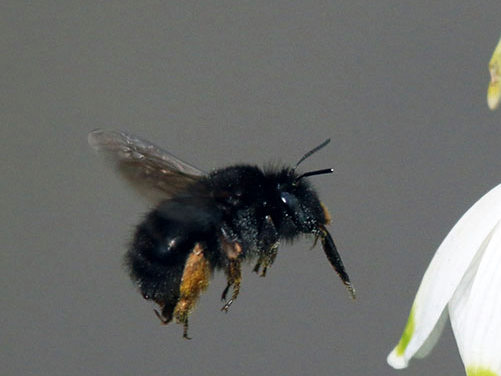 We spotted several Common Carder Bees (Bombus pascuorum) but what really drew our attention was the loud buzzing of Hairy-footed Flower Bees (Anthophora plumipes) poking their long tongues into Green Alkanet and White Comfrey. The females (left) are all black with an orange pollen brush on their hind legs while the males are usually buff coloured with a yellow face.
We spotted several Common Carder Bees (Bombus pascuorum) but what really drew our attention was the loud buzzing of Hairy-footed Flower Bees (Anthophora plumipes) poking their long tongues into Green Alkanet and White Comfrey. The females (left) are all black with an orange pollen brush on their hind legs while the males are usually buff coloured with a yellow face.
Naming species in English
Graeme Lyons, Senior Ecologist for Sussex Wildlife Trust, has recently argued that the English names of species should always have initial capital letters. I’ve tended to do that where it’s obviously needed but I’m not consistent. His reasons make sense to me so I’ll try to stick to capitals from now on. After all the terms ‘large’ and ‘small’ in Large White and Small White distinguish the species of butterfly; they don’t denote size as both species are roughly the same size. So small White makes no sense. Lack of capitals can be very confusing: Buglife quote the example of a Small Sandpit Mining Bee (Andrena argentata) compared with a small Sandpit Mining Bee (Andrena barbilabris).
With scientific names the convention is that capitals are used for the first word only, eg Pieris brassicae for the Large White.
If you want to read Graeme’s rather passionate and interesting blog about naming species you can find it here https://analternativenaturalhistoryofsussex.blogspot.com/2021/08/why-english-names-of-species-should.html
Basic ID guide to wildflowers
If you’re looking for a very small field guide to the most common families of wild flowers, this book which has just come out could be what you’re after. It covers 20 families with flowcharts to guide you to an ID, with illustrations of each species arrived at (200 colour photos in all).
Cost £6-99. Wild-flower-flowcharts-book
Nature Spot can be found at https://www.naturespot.org.uk
Nature Notes Saturday 2nd April 2022
Present: Liz, Grecia, Rossano and Dave
Apologies: Simon, Tara, Sally, Jim and Rachel
Notes by Dave
The weather forecast was dire and we thought we might have to cancel the session. Thankfully the rain kept off but the NW wind was very fierce and cold.
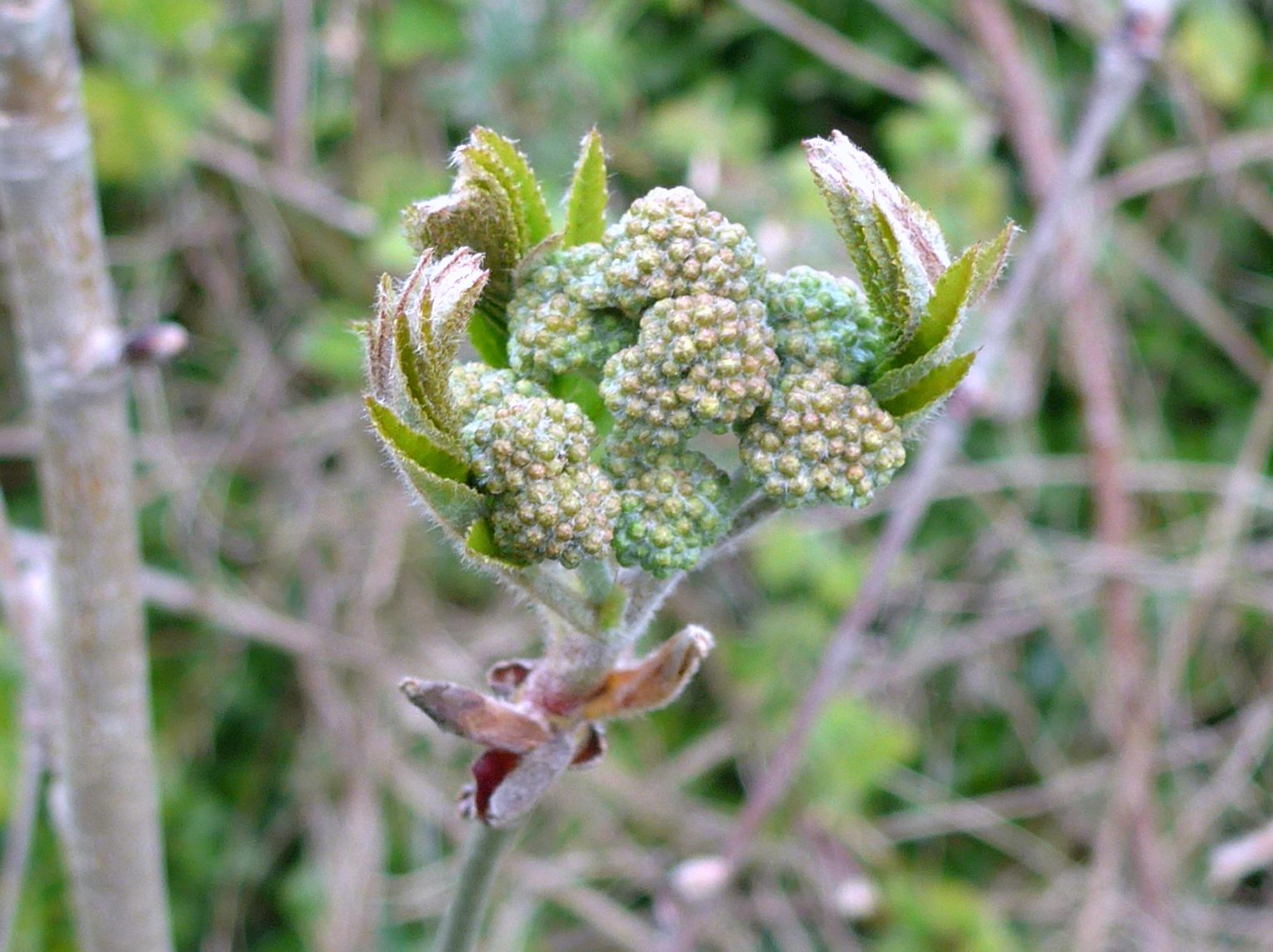 The Goat Willows at the top of the site, both male and female trees, had catkins. Lots of the male ones have already shed their pollen. Despite this and the strong wind, bees were buzzing around the trees. Cherries and Blackthorn had blossom and many other trees were coming into leaf or starting to develop flower buds. The young Rowan buds surrounded by young leaf shoots make me think of strange cauliflowers!
The Goat Willows at the top of the site, both male and female trees, had catkins. Lots of the male ones have already shed their pollen. Despite this and the strong wind, bees were buzzing around the trees. Cherries and Blackthorn had blossom and many other trees were coming into leaf or starting to develop flower buds. The young Rowan buds surrounded by young leaf shoots make me think of strange cauliflowers!
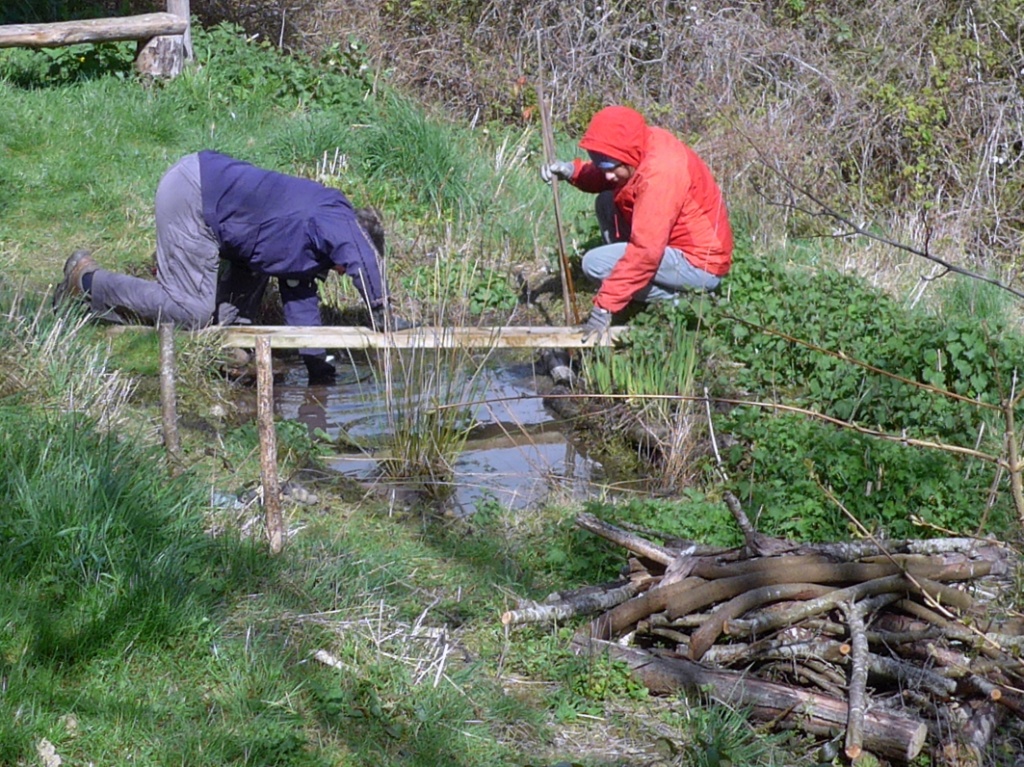 Liz and Grecia worked on the large pond. They skimmed off planted Blanket Weed which had spread rapidly over most of the pond. This year they didn’t have to worry about tadpoles lurking in the weed. There had been a small amount of frogspawn in mid February and the tadpoles weren’t very abundant, but there’s no sign of life now. We’d seen a Common Newt late last summer and if remained over the winter, it would have gobbled up the tadpoles. We know there are several Dragonfly nymphs in the pond, and these too are partial to tadpoles.
Liz and Grecia worked on the large pond. They skimmed off planted Blanket Weed which had spread rapidly over most of the pond. This year they didn’t have to worry about tadpoles lurking in the weed. There had been a small amount of frogspawn in mid February and the tadpoles weren’t very abundant, but there’s no sign of life now. We’d seen a Common Newt late last summer and if remained over the winter, it would have gobbled up the tadpoles. We know there are several Dragonfly nymphs in the pond, and these too are partial to tadpoles.
We ordered Amphibious Bistort (Persicaria amphibia) and Brooklime (Veronica beccabunga) from a nursery to replace some of the plants which had disappeared from the pond. Liz had made a planting ‘sock’ for the Brooklime by sowing up some old sacking. They filled it with soil and placed it at the edge of the pond; the plants roots should grow through the sock into the bank.
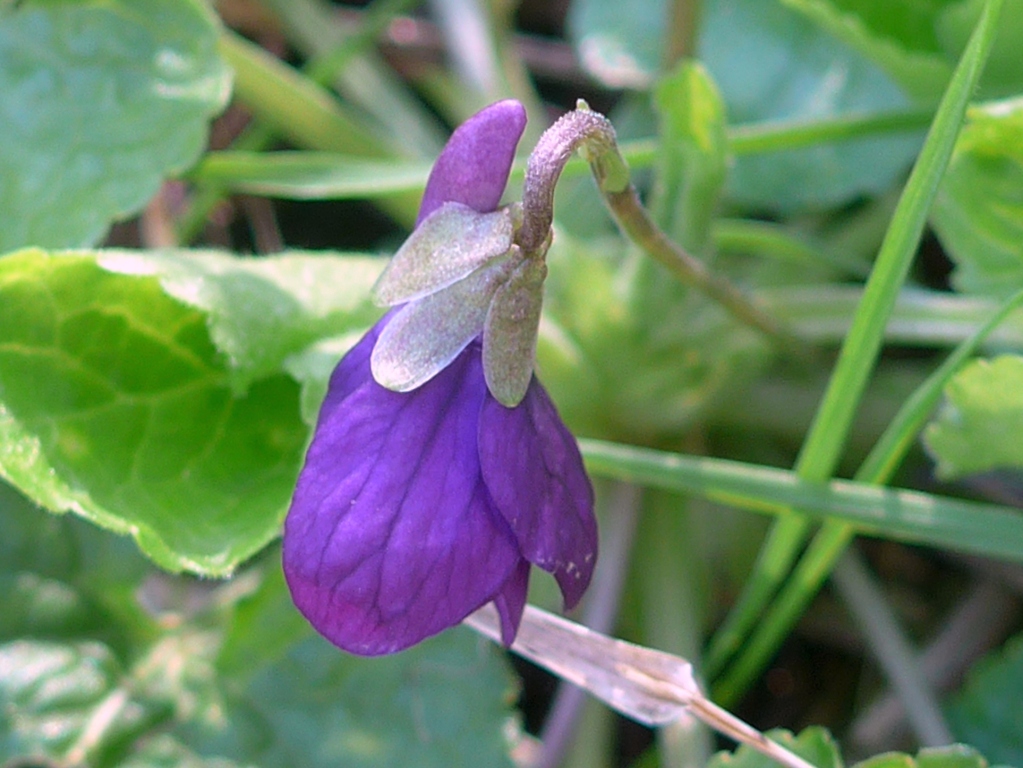
We had a very close look at a number of Violets on the site, all turned about to be the same species. This is a tricky genus, as Violets easily form hybrids. The most common in the wild is the Common Dog-violet. The only scented one is the Sweet Violet (Viola odorata). Our violets fit the description in the Wild Flower Key but don’t have any scent!
Rossano and I spent the whole time clearing paths and steps. For once, we used a strimmer in places to speed things up. Several steps were completely hidden and had become slippery and unsafe. Several people visited the site while we were working, so it seems that we cleared the steps in the nick of time.
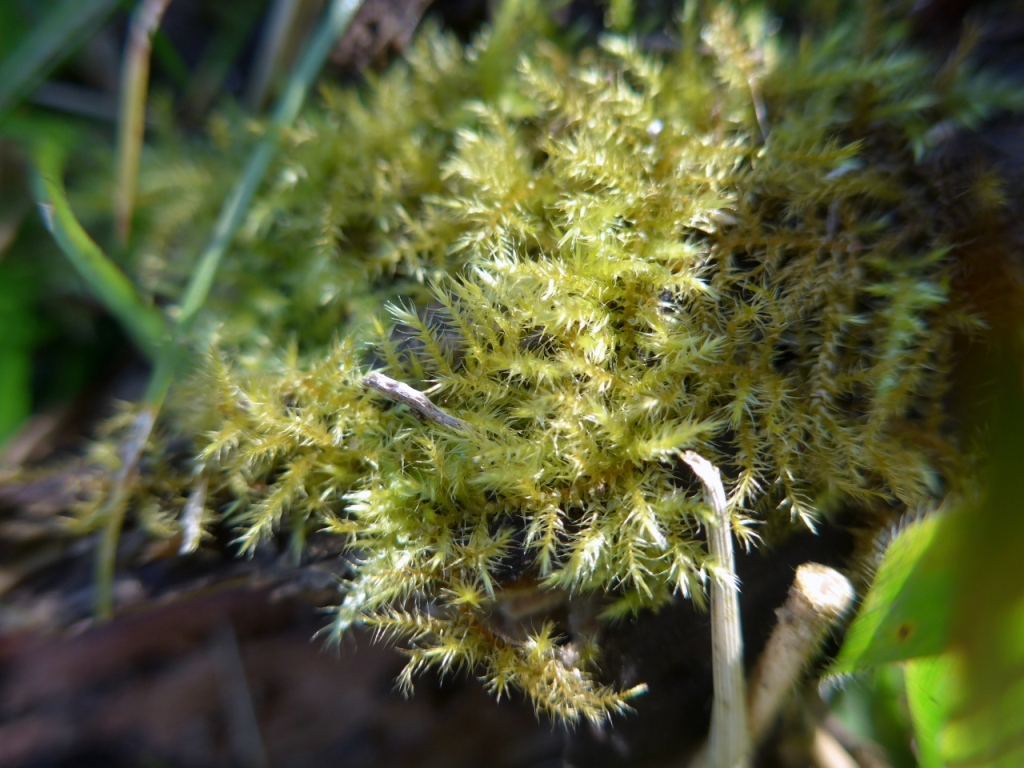
The risers and logs edging the steps are covered in lichens, as are the log piles and tree branches. I took this photo of one which I think is Ramalina farinacea which is widespread across the country. In fact lichens are so common that we hardly notice them or recognise them for what they are. How often do you see what looks like chewing gum on the pavement? Well, it’s far more likely to be lichen. Lichens are everywhere – on rocks, wood, cliffs, even in deserts stabilising the sandy floors.
Lichens are truly extraordinary. They are able to dissolve and absorb minerals in rocks; when they die and decompose the inanimate mineral becomes part of the soil and part of the life cycle. Some of the minerals in all of our bodies have probably passed through a lichen! Lichens have been shot into space and survived massive levels of radiation.
The biology of lichens is remarkable too. They are a symbiosis between a fungus and an alga or a photosynthetic bacterium. The fungus gains the ability to photosynthesise and the alga or bacterium gains the means of growing protective tissue or digesting rock. But they aren’t either fungus or alga/bacterium; together they form a separate organism. Recent discoveries show they are even more complex – many lichens also contain a yeast and some have more than one fungal partner. So far biologists have not been able to devise a complete definition of a lichen.
A beautiful lone Cowslip was flowering beneath the Alder trees, at least I’m fairly sure it’s a Cowslip (Primula veris). Where Cowslips and Primroses (Primula vulgaris) grow close together they frequently hybridise to form a False Oxlip (Primula veris x vulgaris). The False Oxlip varies considerably but it is generally a larger plant than the Cowslip. However it can be hard to tell the two apart. Our Cowslip is my photo on the left, on the right is a stock photo of a False Oxlip. There is also an Oxlip (Primula elatior) which is found only in East Anglia according to my book.
- The Wild Flower Key by Francis Rose is one of the definitive guides to British Wild Flowers
https://www.nhbs.com/the-wild-flower-key-book - If you want to more about lichens: https://www.britishlichensociety.org.uk
Home Page https://moulsecoomballotments.wordpress.com/home/ Welcome Page: News & Events https://moulsecoomballotments.wordpress.com






